Rebuilding SA’s manufacturing sector
Addressing the imbalance in the road-rail split
Profit or loss: the top 3 mistakes
Ayanda

GAUTRAIN:
more than just a train
Invest in SA: Risks, mitigation & mechanisms
SMEs: ACCELERATE YOUR BUSINESS
TRANSPORT SPECIALFEATUREDSECTION INSIDE
FASSET focussed on growing SA’s workforce
A BUSINESS INTERACTION PUBLICATION Volume 9 | Issue 4 | October 2023 R75.00 Incl. VAT 9772411292008 23011 Information | Innovation | Inspiration | Transformation
Mafuleka
A pothole-reporting app to track and monitor progress on pothole fixing and road rehabilitation.






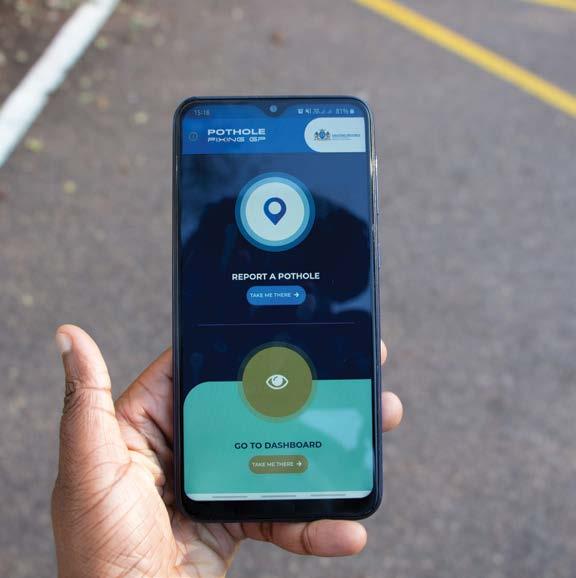
Maintenance applications to assist authorities to track and report on various road maintenance activities.

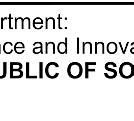
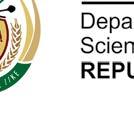




Khangwelo Muronga

KMuronga@csir.co.za

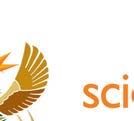


SMART MOB I LITY








TRANSPORT SYSTEMS AND OPERATIONS











 Singh
Singh

Growing the economy
Recently it was announced that over 100 CEOs pledged their support to assist the government in getting the economy back on track.
The need for collaboration to help grow the economy and unlock opportunities is something that has been highlighted numerous times. While the news is welcome, it is also a bit vague, and it remains to be seen how this collaboration will work. It is noted that collaboration between the public and private sector can work ( see pages 14 and 36).
In this issue we focus a lot on transport, and there are numerous reasons for that. One being transport month in October, and to highlight how critical the transport sector is in driving the economy.



The recent taxi strike in the Western Cape illustrated just how much the sector impacts our daily lives. One of the key aspects evident during this strike was how reliant we are on road transport. Over the years there have been many calls to fix the rail system and a fair amount of talk about actions to be taken, but whether the talk will translate into solid and efficient implementation remains to be seen.
We all know there are challenges, but there is also potential for us to collectively address these and enforce accountability.
Tashne
Tashne
@SABImagazine NOTE
South African Business Integrator
FROM www.ixist.co.za info@ixist.co.za
YOURdream WE'LL BUILD YOUR website Get a professional website up and running in no time and share your ideas with the world.
Follow us...
Ed's
R2500
BUILD
Since Serving
1909
Since Serving 1909
Formed in 1909, The South African Institute of Electrical Engineers sports ± 6000 engineering professionals.
Formed in 1909, The South African Institute of Electrical Engineers sports ± 6000 engineering professionals.
Why Join Us
Why Join Us
Our members are professionally engaged in various engineering activities, including academic research, manufacturing, electronics, telecommunications, measurement and control, mining, and power infra-structural services. Members make meaningful contributions to the quality of life in communities and the steady advancement of technology. Their efforts are acknowledged in many countries worldwide.
Our members are professionally engaged in various engineering activities, including academic research, manufacturing, electronics, telecommunications, measurement and control, mining, and power infra-structural services. Members make meaningful contributions to the quality of life in communities and the steady advancement of technology. Their efforts are acknowledged in many countries worldwide.
Our Purpose
Our Purpose
To enhance the practice of electrical engineering in South Africa and the stature of our members through knowledge, networking, influence, education and communication.
To enhance the practice of electrical engineering in South Africa and the stature of our members through knowledge, networking, influence, education and communication.
Training Academy
Training Academy
We offer CPD training courses, a powerful learning tool to improve skills, ensuring that academic qualifications do not become outdated.
We offer CPD training courses, a powerful learning tool to improve skills, ensuring that academic qualifications do not become outdated.
Skills Development
Skills Development
One of our core objectives is to harness and foster the growth of Education in the Engineering sector, which has been faced with a debilitating shortage of skills.
One of our core objectives is to harness and foster the growth of Education in the Engineering sector, which has been faced with a debilitating shortage of skills.
Corporate Forums
Corporate Forums
Corporates are invited to monthly forum meetings to discuss and brainstorm critical issues in South Africa and find solutions.
Corporates are invited to monthly forum meetings to discuss and brainstorm critical issues in South Africa and find solutions.
SAIEE House, 18A Gill Street, Observatory, JHB
011 487 3003
SAIEE House, 18A Gill Street, Observatory, JHB

www.saiee.org.za
011 487 3003
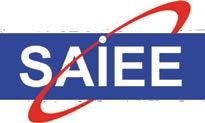
Contact Us
Contact Us
www.saiee.org.za
76 Standardisation to address crushing energy constraints
80 ADVERTORIAL: Novare invests in renewable energy to bolster Pan-African sustainability drive
82 Rebuilding SA’s manufacturing sector

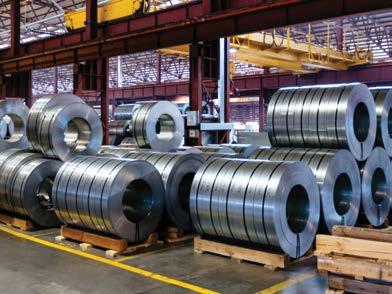
84 ADVERTORIAL: Aims International – Work from home or back to the office?
86 The dos and don’ts of ESG-linked executive rewards
88 ADVERTORIAL: Sinayo – sustainable transformation and inclusivity
90 ADVERTORIAL: Splendi – Financial freedom starts with real-time data
92 SMEs: accelerate your business
100 SMEs can survive construction spike
104 Profit or loss: the top 3 mistakes
106 Crypto providers caught in the licensing net
110 Legal implications for emerging technologies

4 sabusinessintegrator.co.za
CONTENTS
workforce
Gautrain: more than just a train
the imbalance in the road-rail split 26 Restoration of rail functionality
to support road infrastructure development 34 Transforming SA’s transport ecosystem 36 Toll road public-private partnerships: a sustainable roadmap for the future 40 Q&A: FleetAfrica – a trailblazer in the industry
Looking ahead – the role of AI in fleet management
Transportation collapse threatens the viability of the agriculture sector
Transformation in logistics, transport and supply chain
Coca
transport infrastructure to create a more equal and prosperous nation
Driving affordable and effective training in the motor industry
Transnet National Ports Authority partners with CSIR
Local aviation pioneer celebrated
ADVERTORIAL: M84 Geotech – geohazards mitigation and rope access
Q&A:
IMT futureproofing operations
8 COVER FEATURE: FASSET focussed on growing SA’s
14
20 Addressing
30 SADC: forging a harmonised regional strategy
46
50
54
58 ADVERTORIAL:
Cola – Enhancing
60
64
66
68
70
Probe
94 Invest in SA: risks, mitigation & mechanisms
98 Overregulation feeding deficit of affordable housing
14 82 46

Unlock the Power of Independent Employee Benefits Consul�ng Healthcare | Re�rement | Investment Consul�ng | Financial Planning | Actuarial Services | Short-Term Risk Insurance T&Cs apply. The NMG SA Group of Companies are authorized financial service providers t/a NMG Benefits Finding a be�er way Transparent Solutions for Your Business's Success Talk to us today! Are you looking to enhance your employees' well-being while op�mizing your bo�om line? Look no further than NMG Benefits, your trusted partner in independent employee benefits consul�ng.
CREDITS









South African Business Integrator @SABImagazine


GAUTRAIN:
PUBLISHER
Elroy van Heerden-Mays elroy@mediaxpose.co.za

Rebuilding
more than just a train
SA’s manufacturing sector
Addressing the imbalance in the road-rail split
Profit or loss:
Ayanda Mafuleka
Invest in SA: Risks, mitigation & mechanisms

SMEs: ACCELERATE YOUR BUSINESS

TRANSPORT SPECIALFEATUREDSECTION INSIDE
FASSET focussed on growing SA’s workforce
COVER
IMAGE CREDITS: 123rf.com
DISTRIBUTION
Media Support | On the Dot
PUBLISHED BY
6 Carlton Crescent, Parklands, 7441
Tel: 021 424 3625 Fax: 086 544 5217
E-mail: info@sabusinessintegrator.co.za
Website: www.mediaxpose.co.za
Disclaimer: The views expressed in this publication are not necessarily those of the publisher or its agents. While every effort has been made to ensure the accuracy of the information published, the publisher does not accept responsibility for any error or omission contained herein. Consequently, no person connected with the publication of this journal will be liable for any loss or damage sustained by any reader as a result of action following statements or opinions expressed herein. The publisher will give consideration to all material submitted, but does not take responsibility for damage or its safe return.
EDITOR

Tashne Singh editor@sabusinessintegrator.co.za
SUB-EDITOR
Tessa O’Hara tessa.ohara@gmail.com



CONTENT MANAGER
Wadoeda Adams artwork@mediaxpose.co.za
DESIGNERS
Anja Bramley artwork1@mediaxpose.co.za
Shaun van Heerden-Mays artwork2@mediaxpose.co.za
EDITORIAL CONTRIBUTORS
Sindisiwe Chikunga (MP)


Mesela Nhlapo
Thania Dhoogra

Ctrack
Kulani Siweya
Catherine Larkin
Mike Hanly
Alexandra Burger
Roelof van den Berg
Lerato Lamola-Oguntoye
Analisa Ndebele

Celeste Snyders
ADVERTISING SALES MANAGER







Rashieda Wyngaardt rashieda@sabusinessintegrator.co.za
ADVERTISING SALES
Rene van Heerden rene@mediaxpose.co.za
Jaun Haas jaun@mediaxpose.co.za
MEDIA PARTNERSHIPS
Maurisha Niewenhuys maurisha@mediaxpose.co.za
DIGITAL AND SOCIAL MEDIA
Kyla van Heerden social@mediaxpose.co.za
Tia Arendse tia@mediaxpose.co.za
DISTRIBUTION & SUBSCRIPTIONS
Shihaam Gyer distribution@mediaxpose.co.za
CHIEF FINANCIAL OFFICER
Shaun van Heerden-Mays shaun@mediaxpose.co.za
ADMIN ASSISTANT
Ketsia Makola ketsia@mediaxpose.co.za

WEBSITE DEVELOPER/ADMINISTRATOR




Justin McGregor justin@mediaxpose.co.za
RECEPTION
Daniëla Daniels receptionist@mediaxpose.co.za
A BUSINESS INTERACTION PUBLICATION Volume 9 Issue 4 October 2023 R75.00 Incl. VAT 9772411292008 23011 Information | Innovation | Inspiration Transformation
6 sabusinessintegrator.co.za
Ayanda Mafuleka – FASSET CEO
A BUSINESS INTERACTION PUBLICATION

growing SA’s workforce FASSET focussed on
FASSET (Finance and Accounting Services Sector Education and Training Authority) has embarked on various programmes and projects, which help unlock opportunities for the development of a skilled workforce to promote social and economic growth. FASSET CEO, Ayanda Mafuleka, tells us more...

In terms of skills development, how does SA fare in comparison to its global counterparts?
It is noteworthy that in an ever-changing global economy, the imperative of future skills has seen an upwards spiral. Like its global counterparts, the South African job market is undergoing a rigorous transformation, spearheaded by technological advancements, globalisation, and the emergence of knowledge-based economies.
South Africa scores below OECD (Organization for Economic Cooperation and Development) countries on all three indicators of job quantity, namely: employment, unemployment and broad underemployment, due to deep structural problems and a long period of low growth. Studies have highlighted that only half of the working-age population is in employment and unemployment is about five times the OECD average.
South Africa in essence is one of the economies with a low productivity growth rate among emerging economies. Low productivity performance in South Africa reflects the skills shortage, high cost of executing business and lack of competition in many markets.
Noteworthy strides have been achieved by South Africa, however, when set on the same pedestal
COVER FEATURE: FASSET
8 sabusinessintegrator.co.za
FASSET: CEO Ayanda Mafuleka
with its global counterparts, the margin seems to be greater, and such could be attributed to factors such as the historical context of South Africa.
What are some of the challenges and risks in the finance field that could have a negative impact on the local industry?
At this juncture, the countrywide energy crisis is one of the key challenges and the finance and accounting services sector has not been spared as there has been disturbance in its financial system infrastructure.
Some of the noteworthy hindrances in the FAS sector posing a negative impact on the local industry are: sharp repricing in government debt; higher interest rates for a longer period; a greater period of being grey listed by the finance action task force; slow and inequitable domestic growth; financial sector is underprepared for climate change risk; successful systemic cyberattack capital outflows and declining market and liquidity; and secondary sanctions amid heightened geopolitical polarisation.
How has the “brain drain” impacted the finance and accounting field?
This has led to a major bottleneck for the different sectors in South Africa. The cascading of the FAS sector to greener heights has become blurry due to the high intensity of the human capital flight. The FAS sector is a sector that constantly changes and requires skilled and qualified people at its forefront, however, the emergence of a “brain drain” makes it difficult to keep up with the rest of the world.
A “brain drain” in its entirety has a dire impact on an economy of a country. It contributes immensely to the loss of revenue due to the state relying heavily on income tax to fund its social programmes. Projects of this nature are bedevilled due to a mass exodus of people leaving the country, not just with their skills, but also their contributions to generated tax.
A loss of human skills is a prerequisite to the development of a country not showing growth.
FASSET needs the support of the government
in mitigating the “brain drain”, however, SETAs like FASSET need to drive such a mandate with a rigorous and robust approach with the government serving as the captain of the ship.
A strategic framework like the ERRP needs to be inclusive of strategies and plans for combating this foe. FASSET together with its stakeholders can come to the party by effectively harnessing digital technologies powered by Artificial Intelligence and blockchain technologies.
How can skills development and training in the finance/accounting field help unlock cross-sectoral opportunities?
The development of a skilled workforce helps to promote economic growth and social development by creating a more skilled and diverse workforce. The constant reskilling and upskilling allow people to improve their job performance, enhance their ability to be innovative and cascade their critical thinking and problem-solving skills.
A skilled workforce can compete at an international level with its global counterparts. Skills development needs to, however, respond to what is required within the everchanging landscape of skills that are required to ensure that those yearning to learn are offered the opportunity to learn effectively and efficiently. Skills development needs to be driven by an epistemological foundation.
FASSET has embarked on various programmes and projects which help to unlock opportunities. Some of these initiatives include the 18-month Work-Based Experience Programme whereby TVET college students are capacitated with in-depth workplace experience which culminates into a National N Diploma issued by the Department of Higher Education and Training.
In the past four years, FASSET has supported over 1 100 TVET learners of which some have been absorbed into permanent employment.
Lifelong Learning, another FASSET programme, takes a more focused approach, presenting IT
COVER FEATURE: FASSET
9 sabusinessintegrator.co.za
updates that affect the sector and other topics that are more sector-focused, such as tax updates, reporting standards, and governance. Instead of just providing soft skills, this engagement ensured that in the 2022-2023 financial year, over 27 000 employees within the sector were kept abreast through relevant experts such as Professional Bodies.
FASSET plays a pivotal role in eradicating some of the challenges relating to accessing professional body programmes towards obtaining professional designations. First, through making the opportunity accessible to black professionals and secondly, through availing funding. In the 2022-2023 financial year, FASSET funded 1 373 candidates.
It has been reported that many SMMEs fail within the first year. To what extent does poor financial management and processes cause this?
It is notable that funding for SMMEs is available, however, the dilemma lies in the rigorous processes that are required to attain such funding.
Financial management in an enterprise might be a prerequisite for success and the enterprise being a catalyst or the downfall of the enterprise. The failure rate of SMMEs being at a staggering percentage of 70-80% in its first year could be attributed to poor management skills that have not been fine-tuned accordingly and lack of exposure to markets.
Financial literacy and capacitation are vital and in essence, SMMEs need to be guided from their inception and it should be continuous and not be executed in a manner which almost symbolises a task of just ticking the box.
SMMEs are critical to solving economic challenges through employment, but womenowned businesses often face challenges in accessing finance and markets.
FASSET addresses these challenges through a partnership with the Graca Machel Foundation:
Women Creating Wealth programme. This impactful intervention is aimed at developing 600 womenled SMMEs in the financial services sector. The programme, which started on 31 July 2023, currently [at time of going to print] has 71 participants.
One of our other major programmes is through a facilitation partnership with IRBA to deliver an SMME employee support programme as one of FASSET’s strategic priorities. This programme is aimed at identifying and providing support to 50 small black audit firms with candidates who are eligible to register for the Audit Development Programme.
FASSET also opens its discretionary grant funding to SMMEs and prioritises their applications. In the past four years, over 1 000 SMMEs have been supported through discretionary grant funding.
Is the private sector doing enough to address youth unemployment?
The time for the private sector to grab the bull by its horns is now to propose a means of collaborating with the government in delivering on this dire need and long-standing economic blockage.
The private sector has the resources to spearhead this programme and work towards combating unemployment. They need not be on the grandstand anymore, however, they need to show their patriotism by fighting this foe of unemployment, because it is the people of the country who make their businesses thrive.
FASSET has forged a collaborative initiative with the private sector by coupling learning and education to workplace training and working towards reducing unemployment in the country.
Internships are the doorway to entering the employment pool through the provision of experiential learning. FASSET places priority on ensuring its beneficiaries are offered the same opportunity to contribute towards the sector. This focus also aligns with FASSET’s transformation agenda. In the 2022-2023 financial year, FASSET funded over 2 455 beneficiaries in various rural parts
10 sabusinessintegrator.co.za
COVER FEATURE: FASSET
of South Africa, including KwaZulu-Natal, Eastern Cape and Limpopo, and our intention is to extend this nationally. Our beneficiaries within the internship programme are also provided access to digital skills training which is a value add to make them attractive candidates for permanent employment.
Is there scope for SETAs in collaboration with government and the private sector to play a larger role?
Skills development is an ongoing process and cannot be regarded as an initiative with a start and an end, just like transformation. Evolving means that the world will not be known as it is therefore what might be current now, in the next few years might be conventional. Therefore, reskilling and upskilling will always be vital to move with the times and not be left behind.
Government, the private sector, educational institutions, and civil society each form a piece of the puzzle. One should not operate in silos because skills development and training require all to be active to bring about positive change, which will see a greater contribution to economic growth and development.
Noting that the finance and accounting sector is functional in various sectors, FASSET’s scope of partnerships also cross-pollinates. The SETA’s programmes thus respond to a broader call for a skilled workforce and delivering on this mandate requires cross-sectoral partnerships. It is important to note that FASSET operates on skills development levies emanating from organisations within the finance and accounting sector. This means the finance and accounting sector employers are currently singlehandedly servicing skills development initiatives which benefit all sectors. The relevance of this point brings about an opportunity for sectors outside of the FASSET traditional scope to come forward and make their contribution through the allocation of levies to the SETA. This will also allow for a larger of pool of beneficiaries and a quicker turnaround in bridging the skills gap.
Talk to us about digital transformation. Digital transformation requires clear contextualisation for it to align and have an impact on those it affects. In the South African context, the process must consider the history and geographical make of the country to ensure no one gets left behind.
A major focus of FASSET’s digital transformation portfolio has been the establishment of ICT Hubs at 26 TVET Colleges in partnership with the TVET Colleges Governors Council. A similar offering has been extended to Community and Education Training Centres such as KZN CET in Hlabisa, KwaZulu-Natal, where entrepreneurship is highly promoted. The laptops donated to these centres now assist the learners with creating business plans, online advertising and many other capabilities in the digital realm.
How does FASSET assist in driving holistic transformation?
Transformation and inclusivity need not just be good on paper; however, a rigorous and robust approach is required to execute and implement what appears in policy and strategies.
Inclusivity and transformation remain a bitter pill to swallow, however, these phenomena require leaders who are not afraid to face the realities of the past, current and future socioeconomic trends and be trailblazers in revising the narrative.
Rhetoric is no longer what is needed; it is the ethos of a courageous leader who will be an actioner that will help curb inclusivity.
FASSET prides itself on being protransformation because we use this agenda in the development of relevant programmes for greater impact. First, by looking at the underrepresented groups and developing means of ensuring they are provided with the keys to various doors that will allow them to become active participants in the sector and the economy.
11 sabusinessintegrator.co.za COVER FEATURE: FASSET
(Applications close 31 October 2023)
(Applications open September 2023)




Special Edition 13 sabusinessintegrator.co.za
TRANSPORT
Gautrain: More than just a train
The 8th of June 2010, marked a historical moment for South Africa when the first Gautrain ride for commuters left Sandton Station for OR Tambo International Airport Station, just in time for the 2010 FIFA World Cup. Members of the Gautrain project and the public braved the cold to be present for this historic journey.

TRANSPORT LEAD FEATURE: GAUTRAIN
14 sabusinessintegrator.co.za
Thirteen years later, the Gautrain Management Agency (GMA), an agency established by the Gauteng Provincial Government to manage the implementation of the Gautrain Project, is recognised as a centre of excellence in the rail and public transport industry.
The Gautrain has also proven to be more than just a transport project, it is an economic development project focusing on reaching objectives of stimulating economic growth and job creation, promoting investment and new development.
The system was a major employer of Gauteng residents in its construction stage, and this has continued through to the operational phase. A total of 10 900 direct jobs and 61 000 indirect jobs have been supported during operations.
Rapid rail network a forerunner in promoting smart mobility
South Africa’s first and only rapid rail network is a forerunner in promoting smart mobility, helping to reduce road congestion, harmful carbon dioxide emissions as well as noise pollution by providing a cleaner, greener public transport option.
A 2018 independent economic impact study commissioned by the GMA found that a commuter who uses the Gautrain every working day, to and from work between Johannesburg and Tshwane, saves around seven hours and R1 300 in petrol and car-maintenance costs a month. Furthermore, an average single trip on the Gautrain saves 2.8kg of carbon dioxide per passenger trip when compared to a private car.
In the 13 years since the Gautrain first opened its doors for passengers, 131.6 million passenger trips have been undertaken, and every day there are 24 200 fewer cars on Gauteng roads.
“Gautrain is without doubt fundamentally changing perceptions of public transport, and this has generated a number of social, economic and environmental benefits,” says GMA Chief Executive Officer, William Dachs.

TRANSPORT LEAD FEATURE: GAUTRAIN
15 sabusinessintegrator.co.za
The Gautrain has also proven to be more than just a transport project, it is an economic development project...
The arrival of
has influenced local development and commercialisation decisions. R46 billion has been added to the total gross domestic product (GDP) of the provincial economy due to property development induced by the Gautrain, further contributing to another 245 000 jobs.
“We have seen a significant proportion of commercial and residential properties mushrooming around Gautrain stations. The Gautrain route also breaks city boundaries and connects the metropolises of Johannesburg, Tshwane and Ekurhuleni, as well as Africa’s largest airport, OR Tambo International Airport,” says Dachs.
“This has not only led to the integration of communities but has also opened up opportunities for job seekers, entrepreneurs and investors. Well-connected cities mean access to businesses, workers, residents and supply chains, reducing transaction costs, improving productivity and facilitating economic growth,” he adds.

TRANSPORT LEAD FEATURE: GAUTRAIN
This has not only led to the integration of communities but has also opened up opportunities for job seekers, entrepreneurs and investors
Gautrain stations in communities
16 sabusinessintegrator.co.za
Influence on local development and commercialisation decisions
Dedicated feeder and distribution services
Alongside the railway operation, Gautrain has a dedicated feeder and distribution service, consisting of both dedicated buses and midi-buses in partnership with taxi associations, provided to improve accessibility to the train stations and to limit road traffic to the stations.

The Gautrain midibus service has been a critical game changer in unlocking the potential of the minibus taxi industry to operate scheduled, safe and reliable public transport services. In 2022, GMA formed an innovative contracting model with taxi associations operating in the Linbro Park area. Since 2011, more midibus routes have been introduced and are operating at Gautrain Marlboro, Centurion and Hatfield stations.
“Part of GMA’s mandate is to enhance the integration of the Gautrain system with other public transport services within the Gauteng province through initiatives such as the midibus Service which commuters can use for just R12. Gautrain is for everyone, and we have taken
steps to make it even more accessible by, for instance, offering discounts to students through the Gautrain Student Card. We also have a multitiered fare structure that offers favourable fares to frequent and off-peak travellers,” Dachs explains.
Technology offerings and innovations
According to Dachs, Gautrain has also focused on continuously introducing technology offerings and innovations to make its services even more convenient, efficient and accessible. Innovations include the Europay, Mastercard and Visa (EMV) project which was launched in 2019 to enable Gautrain passengers to use the system using their bank-issued contactless cards.
Furthermore, Driver’s Licence Testing Centres have been established at Gautrain Midrand and Centurion stations the Gautrain, an initiative led by the Gauteng Department of Roads and Transport.
It is evident that the Gautrain, a national strategic asset valued at R45 billion at replacement value, has not only changed the perception of public transport in Gauteng but most importantly, has enhanced economic growth in the province.
As the first publicprivate partnership of its scale in South Africa, the Gautrain has also been commended internationally, and much interest has been shown in the lessons learnt from this contractual form and its application to other projects throughout the world.
The Gautrain’s positive impact will undoubtedly continue to increase exponentially.
TRANSPORT LEAD FEATURE: GAUTRAIN
17 sabusinessintegrator.co.za
Transforming Spaces, People and the Economy
The Gautrain is not just a transport project, it is an economic development project focusing on reaching objectives of stimulating economic growth and job creation, promoting investment and new development.


Addressing the imbalance in the

road-rail split
Addressing the imbalance between road and rail transportation of freight remains a critical element of developing a sustainable transportation operational framework.
 By Sindisiwe Chikunga (MP), Minister of Transport
By Sindisiwe Chikunga (MP), Minister of Transport
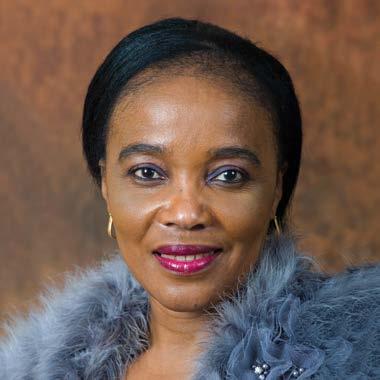
TRANSPORT
20 sabusinessintegrator.co.za
To understand where we are today, we have to look at the historical context. The Road Transportation Act (introduced in the 1930s) restricted the development of the road freight industry, with the distinct purpose of developing the rail network of South Africa. In 1987, the road freight industry was deregulated due to the fact that it had developed sufficiently in competency to provide services to the whole country. Subsequently the South African Transport Services (SATS) was relieved from common carrier obligations it previously enjoyed. This was a prerequisite for the policy changes that were then implemented on the Road Transport Quality System (RTQS), which was set out in the National Road Traffic Act (Act 93 of 1996).
Rapid expansion of road freight resulted in oversupply of transport
The rapid expansion of the road freight industry between 1980 and 1990 resulted in an oversupply of road transport, reducing profitability and decreasing quality standards. The industry successfully negotiated with the authorities the need to increase the vehicle-carrying capacity, which is generally dictated by the weight carried, semi-trailer length, height, width, and overall combination length. This placed the road freight industry in a favourable position (unfair due advantage over rail) to compete with long-haul railway services for high-value commodities. The road freight market share along major corridors is now considerably higher than in the 1980s. This expansion covers high-value commodities and other goods that are normally regarded as suitable commodities for rail haulage, such as maize, fuel, coal, vehicles, containers, and cement.
In its National Transport Policy (2021) the Department of Transport states as one of its objectives the need to improve South Africa’s competitiveness and that of


its transport infrastructure and operations through greater effectiveness and efficiency to better meet the needs of different customer groups, both locally and globally.
Certainly, losses to society can be incurred when goods are not produced at their lowest possible cost including the lowest possible costs to the environment and it can be surmised that efficiencies in freight transport must include a reduction in costs to both society and the environment, especially as environmental damage carries long-term costs to society.
This perspective on freight transport remains accommodative of the National Development Plan (NDP) Vision 2030 in its overriding emphasis on producing efficiencies in the economy of transport, or more importantly, on ensuring that transport plays a pivotal role in developing and growing an economy founded on principles of sustainability
In its vision on transport in 2030, the NDP aspires to, “promote a low-carbon economy by offering transport alternatives that minimise environmental harm”. To this extent, and where this has to do with the flow of factors including cargo, the choice of the mode of transport remains with significant policy implications.
The balance between economic growth and environmental sustainability may well mirror a historically fragmented approach to freight transportation versus a currently very progressive stance to development and growth that is premised on integrated development planning.
TRANSPORT
21 sabusinessintegrator.co.za
Road freight status quo
The current road/rail split stands at 87/13 percent. This is not the equitable split required for an effective land surface transport system. Road is currently the default primary mode of transport for freight for various reasons, with rail taking the backseat due to the sector being characterised by significant constraints such as:
Suspension of Transnet locomotives
Decreased
Toward an equitable rail/road split
While road freight delivery has significant advantages, the great number of freight vehicles on the road contributes to overloading and the subsequent significant deterioration of the road network, traffic congestion, pollution, spillages, accidents and noise. This has resulted in the development and formulation of the Freight Road to Rail Migration Plan, the primary aim of which is to rebalance the road freight-rail freight split in an attempt to create a more appropriate market share and to reduce the number of heavy trucks on the roads to decrease overloading on the road network. The implication is a reduction in overall transport and logistics costs and externality costs (e.g. road damage, road accidents, road congestion, noise pollution and carbon emissions).
The plan is based on the strategic recommendations of the Cabinet approved Road Freight Strategy (RFS), 2017 which in turn was necessitated by the 2005 Cabinet approved National Freight Logistics Strategy (NFLS). The
Constrained demand, power failures, theft, vandalism of critical infrastructure, adverse weather and derailments
migration plan will be based on a qualified assessment of the state of South Africa’s current rail infrastructure, costs of repair and maintenance, capital requirements and future market demands by Transnet. The RFS supports this initiative and notes that the following commodities are best suited to be transported exclusively by rail in the form of break-bulk, liquid bulk and bulk due to factors such as route, type, distance, quality and high pressure: timber, sugar, cement, zinc, coal, grain, liquid bulk, car parts.
Since deregulation in 1987, internationally proven long-haul trucking technology and equipment that have been imported to South Africa and adapted for South African conditions have steadily improved in both vehicle performance and durability, but there have been adverse consequences on the road infrastructure which was not built to move such commodities. South Africa currently permits some of the largest vehicle combinations in the world for general freight haulage – an overall combination length of
22 sabusinessintegrator.co.za TRANSPORT
locomotive reliability and availability
Covid 19 pandemic
No availability of slots
Cyber-attacks and civil unrest in KwaZulu Natal
Historic infrastructure under investment in container corridor mainline
Customers declaring force majeure on key projects
Spike in cable theft incidents
Fire damage at the Richards Bay Coal Terminal
22 m and load heights of 4.3 m, permitting a load area of 124 m³ and 38 tonne payloads and 56 tonne gross vehicle mass (GVM). The carrying capacities and dimensions of these vehicles are undoubtedly a contributory factor in attracting large volumes of bulk commodities.
At present, a feature of the road freight market is the extent to which road freight operators are able to offer competitive rates on the main corridors for the haulage of bulk commodities such as steel, fertiliser, cement, maize, timber, containers, and fuel, which were historically moved by rail. The rates are comparable to railway tariffs and most times cheaper and thus more competitive. However, road freight provides increased flexibility and negotiable back-haul cargoes.
On the negative side, large numbers of heavy vehicles on the major freight corridors and on many provincial roads contribute to accidents, overloading, road damage, congestion, and pollution, emphasising the importance of the externalities of the mode. Provincial authorities who are tasked with controlling and enforcing road traffic legislation have not been provided with the additional capacity necessary to keep pace with the growth in the industry. One of the possible measures to internalise the impacts of heavy vehicles is to implement a user-pay principle.
Improving the overload control system
The RFS draws attention to the improvement of the overload control system through a series of coordinated solutions such as the establishment of a national inspectorate, the utilisation of mobile technologies, administrative enforcement approaches, credible deterrents and data intelligence.
One of the major causes of concern in the road freight system is the fact that it is evident that heavy goods vehicles do not currently contribute adequately to compensate for the wear, damage, and externalities caused on the roads in South
Africa. Another of the strategic thrusts of the RFS is road infrastructure management and funding, which is supported by the NATMAP 2050.
Growing externalities a cause for concern
The externalities associated with the rapid increases in the road freight operations in South Africa are a growing cause for concern. The growing externalities are, in part, due to the high percentage of goods being transported by road instead of rail resulting in making the main city centres suffer from considerable congestion during peak hours, aggravated by the presence of heavy vehicles. The rising heavy vehicle accident rates in cities and on the main national road corridors are partly caused by, though not limited to, competition for road space and the inadequate control of operating standards in the trucking industry. Externality factors include driving hours, driver training, and control of speeds and loads. Heavy goods vehicle exhaust emissions are a major cause of air pollution in cities, and traffic jams and congested roads further aggravate this situation, as road transport contributes 95% of the total transport sector CO2 emissions.
Key road freight challenges
One of the biggest challenges to hit the road freight industry in recent years has been the violent attacks on the road freight logistics supply chain, mainly targeting the road freight corridors. In some instances, this has led to supply and delivery routes being dysfunctional and some having stopped operating and thus lost to the country. To this effect the perishable goods industry has suffered a lot, while some industries have shrunk, and others have shut down completely. Some of these have led to organised crime syndicates that target specific commodities such as coal and agricultural products.
The War in Ukraine has also had some consequences on SA, as the reliance on petroleumbased fuel and products has rendered the global
23 sabusinessintegrator.co.za TRANSPORT
food supply chains vulnerable. With the fuel supply shortages, a lot of freight and logistics companies have had to look for alternative fuel/energy resources and a number of high value goods. Also noteworthy, the fuel price increases continue to be a challenge for freight and logistics operators.
Other challenges include public unrest and looting, which disadvantages supply chain warehouses, distribution depots, retail outlets and intermodal facilities. The stoning of vehicles to voice displeasure is also on the rise. The opportunistic culture of criminals is evident and continues to undermine government efforts to provide an enabling environment for the seamless movement of cargo.
Despite the challenges, road freight transport continues to increase (48% in last 10 years) with heavy goods vehicles (HGVs) making up 34% of traffic on the N3, and HGV accidents on that route at the same level as light vehicles. The levels of enforcement are not keeping pace with the growth of traffic thereby aggravating the cost of accidents (R300 billion p.a.), according to STATSA, 2021.
Other challenges include public unrest and looting, which disadvantages supply chain warehouses, distribution depots, retail outlets and intermodal facilities.
Strategic interventions
The Department is undertaking a process to encourage provinces to furnish a comprehensive list of strategic roads marked for transfer to SANRAL. These roads would be officially gazetted as national roads and effectively maintained by SANRAL thereby improving on the quality of the roads. In the same vein, the department will also
undertake a process to encourage and ensure enhanced road maintenance, through fostering collaboration with the private sector. Our other major areas of strategic implementation and intervention in the sector are as follows:
• Freight Road to rail migration (in the current MTSF period 2019 – 2022) is 13.32mt effectively shifted from road to rail. It is also important to note that the DOT is in the process of implementing the Rail Policy as promulgated in 2022, which will lead to a better rail/road split. Some of the initiatives emanating from this Rail Policy are:
o Rail Private Sector Participation (PSP) Framework
o National Rail Master Plan
o Establish an Interim Rail Economic Capacity (IRERC)
o National Rail Bill
• National Operator Registration System: This system will be a module within eNatis, and will serve as a system to register all road freight transport operators as is the case in all other modes of transport in SA (rail, ports, maritime, aviation and pipelines). This system is being developed together with RTMC as the official quality regulation of the industry.
• Truck Stop Framework: For the effective performance management of the supply chain and corridors throughout the country, it is important to ensure the effective use of existing truck stops, denote where more are needed, as safe haven for truck drivers while in-transit. There is a need to standardise truck stop services, in order to ensure their effective support of cargo in transit.
• Transport Economic Regulator: An important tool to ensure the effective economic regulation of all modes throughout the transport sector. To consolidate the economic regulation of transport within a single framework and policy.
24 sabusinessintegrator.co.za
TRANSPORT

25 sabusinessintegrator.co.za
Restoration of
rail functionality
South
Africa is endowed with the largest rail network on the African continent and one of the most extensive in the world at 36 000km.
By Mesela Nhlapo, CEO at African Rail Industry Association (ARIA)
Over the years with the development of national highways and the management challenges faced by the two rail infrastructure owners, Transnet Freight Rail (TFR) and Passenger Rail Service of South Africa (PRASA), the trucking companies aided by a well development of national highway system have become quite a formidable challenger to moving freight and people. This has seen the rail network utilisation reduce to half of the available network and about a third of the railway lines see no or very low activity.

26 sabusinessintegrator.co.za RAIL
African Rail Industry Association (ARIA), which is based in Johannesburg, South Africa, and its members are determined to arrest this decline in the use of the rail network and restore rail to the role of being a primary mode of transport in South Africa and the Sub-Saharan Africa region. ARIA is a representative organisation of companies operating in the full spectrum of rail and rail-related businesses. This includes rolling stock manufacturers, operators, maintenance and support, and rail-related services providers.
The stance that is being taken by ARIA and its members is not about self-preservation but rather informed by the need to play an active role in the economic development of South Africa. This is within a context of the world over that railways are recognised as critical in promoting industrialisation and manufacturing, providing climate smart logistics solutions for the movement of goods and people. As countries are exploring economic activities that have a lower footprint on the planet, rail is finding favour and policymakers are responding by demanding its greater utilisation.
In South Africa, road-to-rail has become a mantra within government especially as the presence of heavy vehicles on the road is leading to an increase in fatal accidents. The study conducted by the Road Transport Management Corporation (RTMC), an agency of the Department of Transport (DOT) shows that over 4 000 trucks and buses were involved in fatal crashes on South African roads between 1 January 2018 and 31 December 2022 resulting in over 3 400 fatalities.1 These statistics have added impetus to stakeholders across the country calling for an appropriate rail policy.
National Rail Policy sets to reclaim position of rail as a primary freight logistics mode in SA
The DOT responded by developing the National Rail Policy, which has received unanimous
stakeholder support as it sets to reclaim the position of rail as a primary freight logistics mode in the country. The rail industry would want to see the reversal of the movement from rail to road, which has seen the TFR seeing its freight volumes peaking at 230 million tons (MT) in 2017 Financial Year (FY) to around 173 MT in the 2022 FY.2
The rail industry supports the bold undertakings by the DOT towards the repositioning of the rail network, especially the intention to ensure greater participation by private industry in mobilising the resources to improve infrastructure and enable competition in freight logistics operations. This statement from the policy encapsulates the positives winds blowing from the department: “The National Rail Policy intends to place rail on a sound footing to collaborate with and compete against the other transport modes to position it to serve as national land transport backbone by 2050. The remedial interventions will be two-pronged, infrastructure investment interventions to enhance rail's inherent competitiveness, and enabling interventions to adjust institutional arrangements to ensure that rail functions effectively in delivering its share of the national transport task.”3
The mining industry, which is a major foreign exchange earner for the country had seen lack of options in rail logistics services providers proving be costly for the sector with an overreliance on TFR. The Minerals Council predicted that it had lost R35 billion revenue in the 2022 FY – a figure that is predicted to be higher in the 2023 FY.4
The new policy calls for the introduction of independent operators, which will ensure the introduction of additional capacity.
ARIA believes with the introduction of third-party operators coupled with investment in infrastructure and technologies, we will immediately see 60 MT of 840 MT of freight currently being moved by truck returning to rail.5
The key to achieving the intentions of the policy is the speed in implementation.
RAIL
27 sabusinessintegrator.co.za
Benefits of expedited implementation ARIA’s plea to government
ARIA appreciates the leadership that has been shown by the Minister of Transport, Honourable Sindisiwe Chikunga and pleads for expedited movement in enabling its implementation. Some of the critical milestones in this regard would be:
1. The Minister should give an undertaking to table the Regulation of Transport Bill in Cabinet at the earliest opportunity and work closely with industry to ensure its passage through parliament. In this regard, the industry will avail resources to ensure expedited consensus.
2. Confidence in the process of allocation of slots needs to be built to encourage private sector investment. Private rail industry experience makes it weary that the state-owned monopolies will act impartially to grant infrastructure access.
3. The consolidation of rail infrastructure, with an accounting authority independent of Transnet and PRASA, from the current fragmented arrangement needs serious consideration, if the private sector is going to have confidence that it will be fairly treated.
4. The Private Sector Participation (PSP) framework for investment into track infrastructure must be fast-tracked by the DOT.
5. The administrative and state-owned companies executives should be contracted directly to deliver the new rail policy regime. In this regard, these key performance areas should be explicit in shareholder compacts and individual performance plans.
REFERENCES
As the CEO of ARIA and on behalf of the rail industry I highlight that we are committed to availing our organisations and the private rail industry to assist the government in the expedited implementation of the enabling legislative, regulatory, and policy frameworks. The benefits for the country are immense:
• Early projections by ARIA suggest that additional parties using the rail network rail will create tens of thousands of upstream jobs by enabling industry (like smelters, steel mills, manufacturing, and agriprocessing) and mining (new coal, manganese, and iron ore mines, among others) to become internationally competitive.
• Similarly, rail corridors into Africa would create cost-effective gateways to take South African goods into these markets. The region’s confidence in routing freight through South Africa will also be restored.
It will take approximately 24 months for private operators to procure new trainsets from Original Equipment Manufacturers (OEM). There is no time to lose if the country is going to arrest the decline in mining capacity in South Africa.
The government has provided the platform through the policy, speed is of the essence if South Africa is going to be seen as a compelling investment destination.
1 https://www.gov.za/speeches/accidents-rsa-roads-26-jul-2023-0000#:~:text=A%20baseline%20study%20conducted%20by,(average%20fatalities%20 per%20crash).
2 https://www.transnet.net/InvestorRelations/AR2022/Freight%20Rail%202022.pdf
3 https://www.gov.za/sites/default/files/gcis_document/201708/draftwhitepapernationalrailpolicy.pdf
4 https://www.miningreview.com/coal/third-party-rail-access-critical-for-sa-mining-sector/
5 https://www.engineeringnews.co.za/print-version/collapse-in-rail-service-has-increased-road-freight-volumes-and-risks-2023-04-21#:~:text=At%20the%20 same%20time%2C%20road,839%2Dmillion%20tonnes%20in%202022.
RAIL
28 sabusinessintegrator.co.za
Let's have a conversation about your supply chain challenges.
Unitrans offers end-to-end logistics services, that can help you to understand and reduce the complexity in your supply chain, increasing your productivity. All supported by innovation, exceptional quality and safety standards.

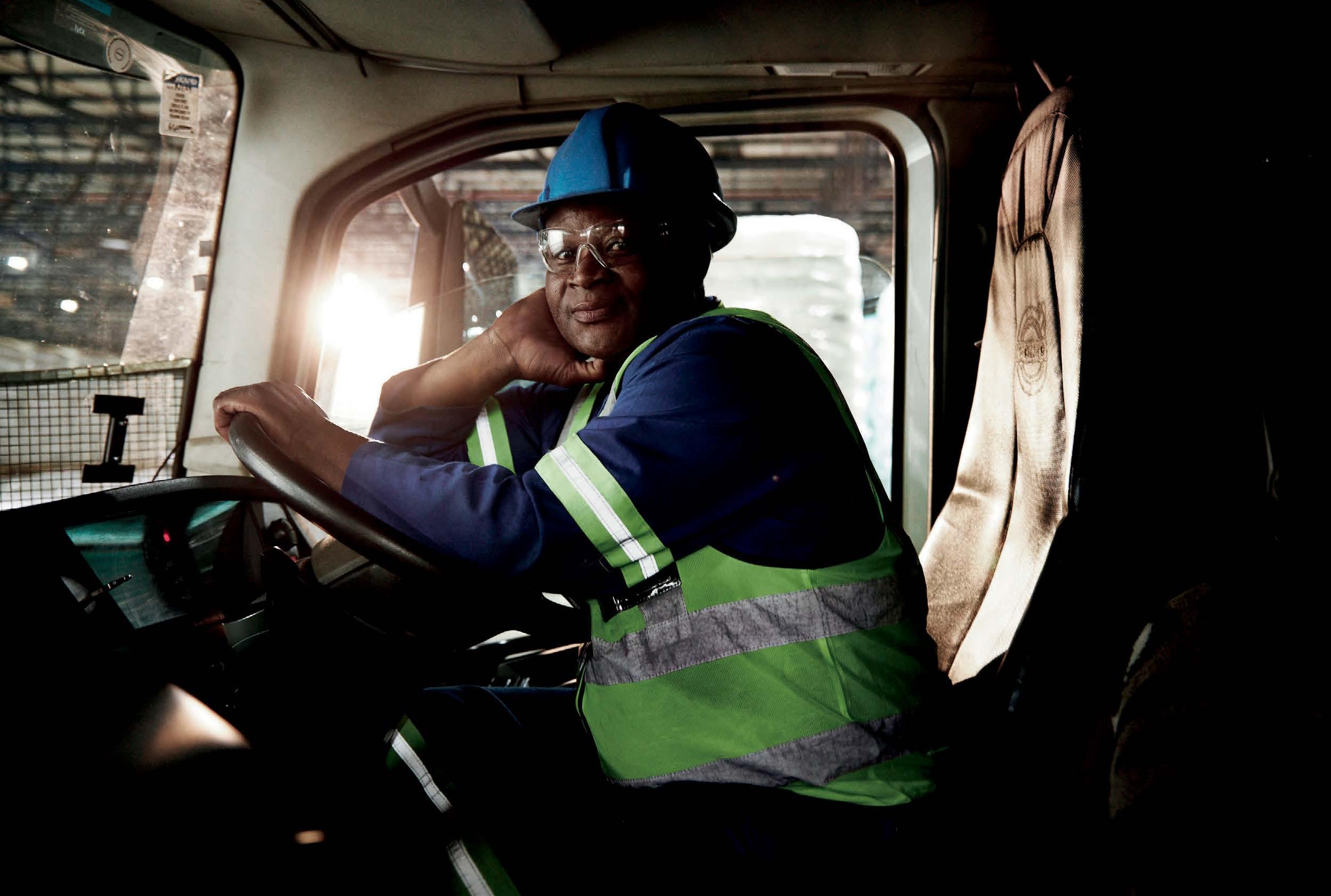
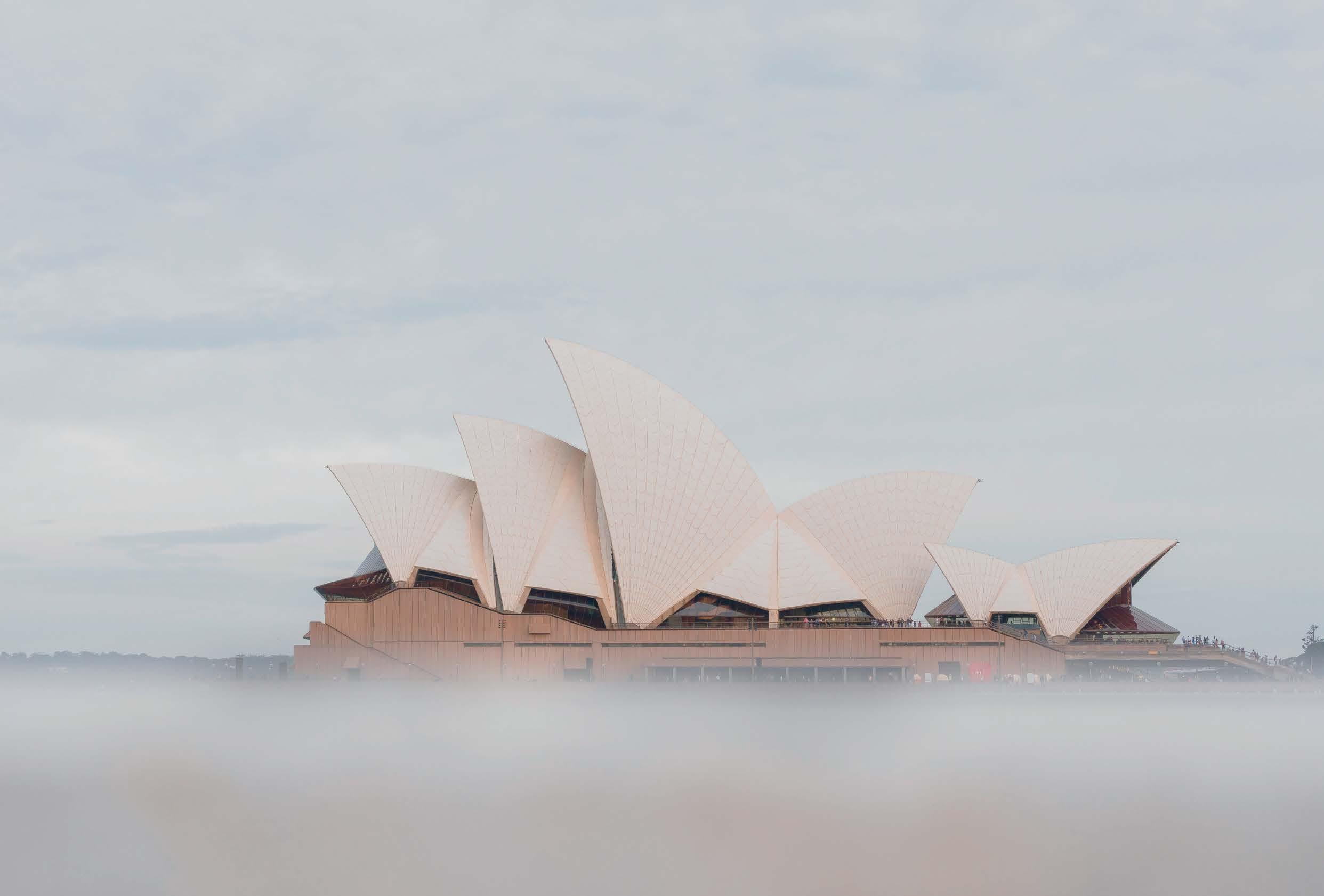
Find
out more at: www.unitransafrica.com
SADC: forging a harmonised regional strategy to support
road infrastructure development
Relative peace and stability in Southern Africa, with some exceptions, has greatly aided progress in road infrastructure development, boosting the region’s prospects for social and economic transformation.
By Tiago Massingue
Given that road transport is the most dominant mode of transport for the movement of goods, services and passengers in the Southern African Development Community (SADC), it is crucial that continuous expansion of the region’s land transport infrastructure is not only accelerated at scale, but also pursued in an optimally coordinated and collaborative way.
Encouragingly, there have been increased efforts from Southern African governments, development agencies and financing institutions to prioritise investment into road networks to improve crossborder road connectivity.
Regional road infrastructure policy has chiefly been driven by the SADC bloc, comprising 16 member states: Angola, Botswana, Comoros, Democratic Republic of Congo, Eswatini, Lesotho, Madagascar, Malawi, Mauritius, Mozambique, Namibia, the Seychelles, South Africa, Tanzania, Zambia and Zimbabwe.
Land transport the dominant link between the region and global markets
Six of SADC’s primary transit markets are landlocked, making land transport the dominant link between the region and other continental
and global markets. Southern Africa’s main road transport routes are therefore focused on three primary road-based corridors – the North-South Corridor, which links the port of Durban in South Africa to Zimbabwe, Zambia and the DRC; the Maputo Development Corridor, connecting Mozambique to South Africa’s Gauteng, Limpopo and Mpumalanga provinces; and the Dar-es-Salaam Corridor in Tanzania, running into Malawi and Zambia.
It is worth noting, however, that the region has 932 207km of road network, of which only 13.6% are paved, indicating the progress required to meet road infrastructure deficits present in the region.
As a first major step to addressing infrastructurerelated barriers for the region’s development, in 1996 the SADC region passed its Protocol on Transport, Communication and Meteorology. One of its aims is for regional collaboration on a harmonised road policy to develop road infrastructure.
ASANRA enhances policy coordination and integration of road transport systems
Based on the Protocol, the Association of Southern African National Roads Agencies (ASANRA)
INFRASTRUCTURE
30 sabusinessintegrator.co.za
was established in March 2001 and tasked with promoting the development and maintenance of a regional integrated transport system. With its full members comprising the national road agencies of the SADC member states, ASANRA broadly aims to enhance policy coordination and integration of road transport systems among member states. The bloc has also adopted plans and strategies to guide road infrastructure development into the next decade.
One of these is the Regional Infrastructure Development Masterplan, which was first adopted in 2012, in recognition of the deficit of infrastructure necessary for surface transport across SADC. The masterplan acknowledged that policy formulation and implementation was crucial for the sector to develop. It also recognised the need for the rehabilitation of trunk roads owing to overloading and inadequate maintenance, as well as the implementation of harmonised regulatory standards such as load limits across the region to preserve road assets.
The Transport Masterplan outlines 72 road projects comprising new builds, upgrades or maintenance projects. These include the Dar es Salaam-Chalinze toll road, the Kazungula Bridge,
the Beitbridge-Chirundu road upgrade, and the implementation of an intra-regional road asset management system – all of which the bloc aims to have completed by 2027.
The region is also featured in the United Nations Economic Commission for Africa’s (UNECA) development of the Trans-African Highway, a continental road network set to have a total length of 59 100km. Through this project UNECA envisions a transcontinental network linking African countries, although it must be noted the progress for completion of this network has been slower than anticipated. UNECA launched the concept in 1971 and is developing the network together with several partners, including the African Development Bank (AfDB) and the African Union.
Road infrastructure development has notable political will for collaboration
By and large, Southern Africa’s road infrastructure development sector has witnessed notable political will for collaboration between countries and the development of innovative financing models to support the creation of efficient trade corridors.
More recently, a key boost for transportation on the North-South corridor has come online with

INFRASTRUCTURE
31 sabusinessintegrator.co.za
the Kazungula Bridge. The 923 metre-long tolled bridge crossing the Zambezi river between Zambia and Botswana was commissioned to better connect nations including South Africa, Zambia and DRC.
Constructed at a cost of around $259.3 million, and opened in 2021, the bridge is jointly owned by the Botswana and Zambian governments and is funded by toll fees. The Kazungula Bridge has lessened pressure on the Beitbridge border crossing between South Africa and Zimbabwe, helping to cut transit times, driving efficiency in border processes and promoting intra-regional trade.
It must be noted, however, that despite the progress made in building road networks, road maintenance costs remain a concern for the region. The SADC bloc has noted that many governments often face competing priorities which make funds available for road maintenance scarce or limited. SADC countries must therefore keep road maintenance a priority at the top of their agenda, consistently.
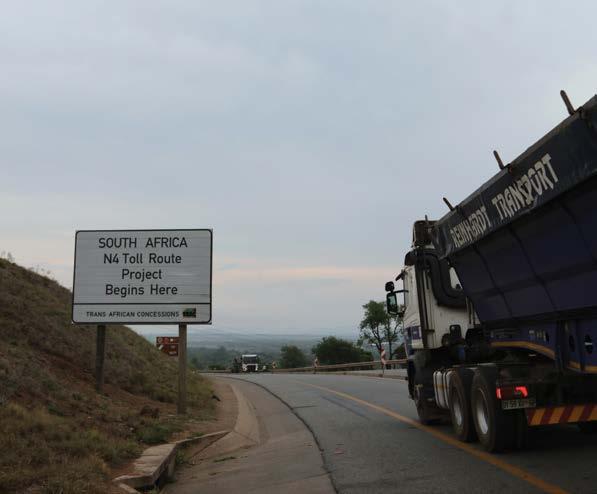
A stronger focus needed on building climate resilience for surface infrastructure
The region must also gear up for a stronger focus on building climate resilience for surface infrastructure. In recent years, Southern Africa’s road infrastructure has been particularly vulnerable to the impact of climate insecurity, mainly in the form of extreme temperatures, heavy rainfall, flooding and in cases such as Mozambique, Malawi and Madagascar, cyclone damage.
This is driving countries’ efforts to climate-proof their road infrastructure to minimise damage. For example, Zambia began to implement the country’s first resilient road system in 2018. Climate-related damage to the Zambian roads stands at around ZMW295 million, set to rise to ZMW303 million by 2030. In 2015, SADC adopted the SADC Climate Change Strategy and Action Plan, committing to adapt public infrastructure including roads to
climate change. However, it will be integral for the roll-out of a harmonised strategy to ensure road quality standards can be relatively uniform across the region.
Southern Africa still has a way to go to build on gains made towards intraregional growth
Looking ahead, Southern African governments still have a way to go to build on the gains made towards intra-regional growth. Largely, this will hinge on factors including greater harmonisation and implementation of regional policies and strategies at the national level, increased collaboration across the road construction value chain as well as improved funding mechanisms, both for new builds as well as maintenance of existing infrastructure.
The benefits for SADC members countries, South Africa included, for adopting a harmonised and integrated road transport strategy are immense and will support their countries’ own national goals and objectives.
Tiago Massingue is a civil and structural engineer and a senior project manager with SANRAL, specialising in areas of project management, bridge and roads designs, concession contracts, procurement processes in road project, and roads project finance across Africa.
32 sabusinessintegrator.co.za
INFRASTRUCTURE
SIYASEBENZA.
THE N2 WILD COAST PROJECT IS AN INVESTMENT IN THE FUTURE OF SOUTHERN AFRICA.
The R8 billion investment in the Eastern Cape section of the project will benefit local businesses and bring jobs to local communities. The project also demonstrates South Africa’s commitment to the continuous expansion of land transport infrastructure across the whole of the Southern African Development Community. When the region works together towards a common goal the road to a brighter future is smoother.
www.sanral.co.za
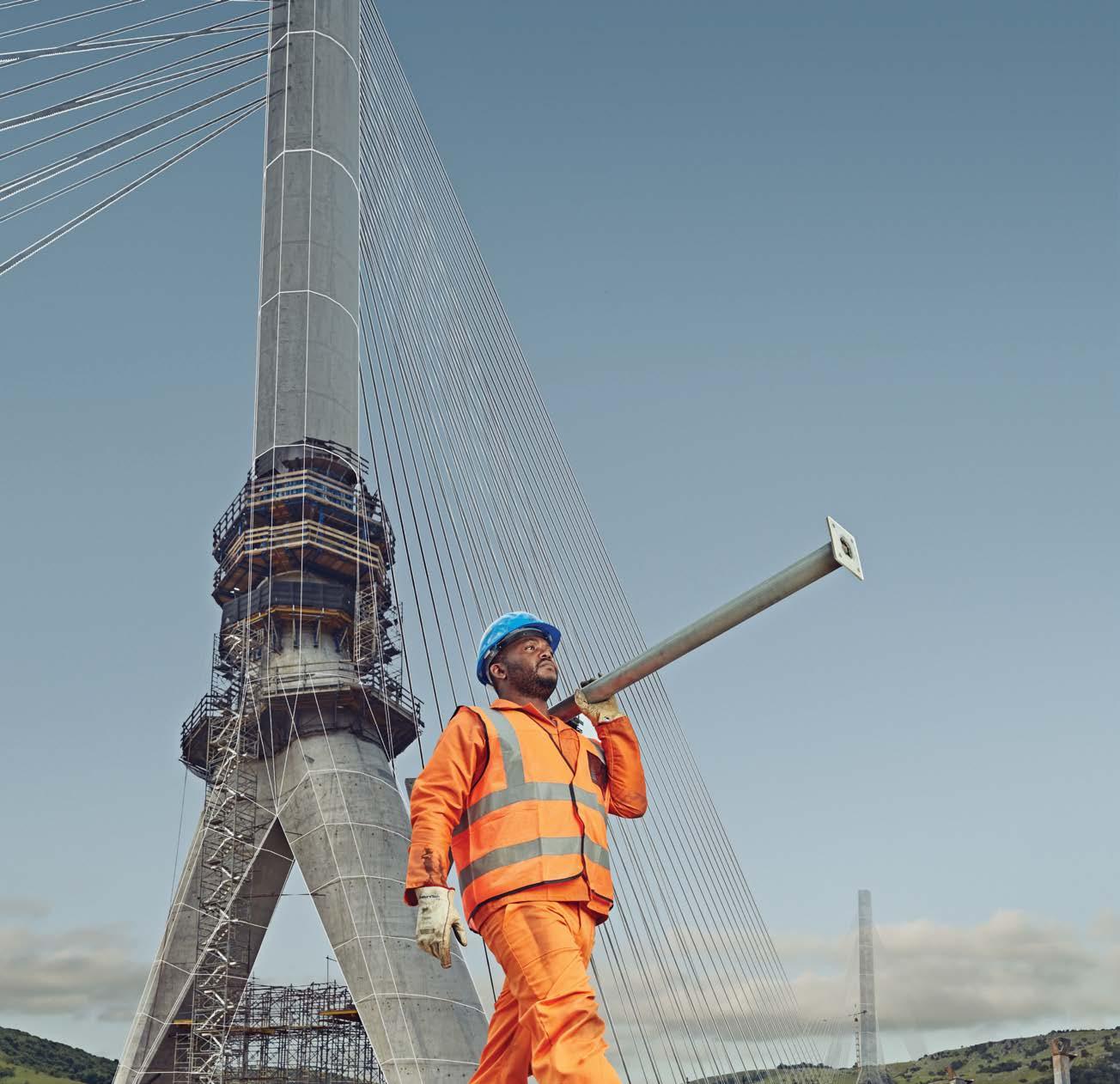
Reg. No. 1998/009584/30. An agency of the Department of Transport.
BLUEPRINT
5507/E
Transforming SA's
transport ecosystem
In the drive toward a more efficient, economically prosperous, and environmentally sustainable future, few areas have as much potential as transportation. Dr. Mathetha Mokonyama, the Impact Area Manager for Transport Systems and Operations at CSIR, shares some insights...

Beneath the surface of South Africa's transport system lies a wealth of opportunities for transformation. Dr. Mokonyama emphasises the importance of revisiting the laws that govern the system, which were not originally designed with efficiency in mind. By recognising this crucial aspect, we can begin to recalibrate legislation and regulations to create an evolved, efficient, and interconnected transport network.
Dr. Mokonyama acknowledges that every journey comes with obstacles but to approach these with a specific impact pathway in mind. The issue of rising transport costs is deeply intertwined with historical spatial dynamics and population growth. He highlights how job-centric land use in historical townships and the positioning of state-owned enterprise headquarters contribute to increased travel distances and expenses. Additionally, prioritising pedestrian infrastructure is vital for ensuring commuter safety and reducing road fatalities.
Sustainable transport transformation goes beyond economic considerations. Dr. Mokonyama notes how PRASA is spearheading a significant shift by adopting modern rolling stock, resulting in reduced externalities per kilometre traveled within rail-intensive cities. The CSIR also champions alignment between the Department of Transport's
Green Transport Strategy and public-private partnerships. Effective project packaging can bring aspirations to life, making them not only viable but also transformative.
The theme of intelligent mobility solutions emerges as convenience and cost-effectiveness take centre stage in progress. The CSIR emphasises that these solutions stem from a comprehensive understanding of individual travel patterns and transport service consumption. With regard to transport transformation, Dr. Mokonyama's insights resonate as a symphony of possibilities. "A future beckons where transport is not merely a conduit but a conduit of prosperity, efficiency, and sustainable progress," concludes Dr.
Mokonyama
TRANSPORT
34 sabusinessintegrator.co.za

Toll road public-private partnerships:

a sustainable roadmap for the future
South Africa’s successful toll road concession projects should be considered a blueprint for public-private sector partnerships (PPPs) to unlock infrastructure investment opportunities.
By Thania Dhoogra, Operations Manager at N3 Toll Concession (N3TC)
A country’s road infrastructure is key to providing a connection between goods, people, and places, a view unanimously shared by economists. In recent years SA’s road network has become even more integral as a strategically important lifeline because its crippling rail infrastructure forced the movement of goods and commodities from rail to road.
On the N3 corridor, linking the port in Durban to the economic hub of Gauteng, the N3 Toll Route has been able to absorb the extra load, and continues to facilitate commercial activity, provide a pathway for development, boost trade, and create opportunities for economic growth and socio-economic development. This all while maintaining a reputation as having one of the highest standards of road network condition as compared to other roads elsewhere in the country.
TOLLS
36 sabusinessintegrator.co.za
PPPs best positioned to protect and expand SA’s infrastructure assets
Infrastructure projects have a multiplier effect and offer a powerful mechanism to unlock economic value. Studies show that they are critical to the growth of a country’s economy as they stimulate job creation and the transfer of skills, provide muchneeded impetus to the development of associated emerging micro-enterprises (EMEs), facilitate regional growth, and unlock socio-economic development opportunities.
Year after year, South Africa’s increasing budget deficit has been cutting into government expenditure on large-scale infrastructure development projects, despite the availability of the best tools to advance our nation’s economic prospects – the maintenance and expansion of our existing assets, and the construction of new infrastructure. Capitalising on the efficiencies of the private sector, carefully structured PPPs offer South Africa an opportunity to close the funding gap between what is available (from the government) and what is required. This in turn relieves the State of its operational duties to spend more time on efficient policymaking and regulation.
As an asset class, infrastructure projects provide attractive and stable investment opportunities to development institutions, the formal savings sector, banking institutions, foreign investors, and the construction sector. When structured correctly, infrastructure projects are highly financeable, with equity partners taking a long-term view to protect the asset and ensure a fair return on their investments over the life of the project. Wellstructured PPPs provide funding solutions and mechanisms to enhance the delivery of public infrastructure services, scale projects, improve efficiencies, governance, and accountability, and ultimately close socio-economic inequity gaps through knowledge/skills transfer and the creation of new economic development and employment opportunities.
A case in point
Toll roads, first introduced to South Africa in 1984, have since grown from an initial 27km to 3 120km. They currently constitute approximately 13% of the entire national road network (23 569km in March 2023) and are made up of agency-funded toll roads (1 832km) and public-private sector partnerships (1 288km).
On 2 November 1999, N3 Toll Concession (RF) Proprietary Limited (N3TC) entered into a 30-year toll concession contract with the South African National Roads Agency (SOC) Limited (SANRAL) to manage a 415km section of the N3 corridor, known as the N3 Toll Route. The N3 Toll Route starts at Cedara in KwaZulu-Natal and ends at Heidelberg in Gauteng.
As a major arterial road, the N3 Toll Route transects four provinces and connects large sections of the country’s agricultural, mining, industrial, import, and export sectors to its main port in Durban, KwaZulu-Natal.
It is one of South Africa’s busiest transport corridors – and is considered to be the bedrock of our economy – with approximately 80 million tons of freight per annum being transported along the route. Winding through picturesque landscapes, villages, and small towns of KwaZulu-Natal, Free State, Mpumalanga and Gauteng, the N3 Toll Route also acts as a conduit for tourism and rural development.
Infrastructure projects, such as those falling under the ambit of the toll road concession programme, have long been considered some of South Africa’s most successful PPPs. These tolling projects helped to establish South Africa’s credibility in international PPP markets and laid the groundwork for future infrastructure concession projects.
In terms of the N3 Toll Route PPP, N3TC is responsible to design, construct, finance, operate and maintain the N3 Toll Route. The concessionaire assumes all risks related to traffic, debt financing,
TOLLS
37 sabusinessintegrator.co.za
construction, maintenance, and operational costs, and holds the asset for a set period of 30 years, whereafter it is transferred back to the State, in a contractually specified condition which is monitored by independent parties on an annual basis. There are currently only six years of the concession period remaining; the N3 Toll Concession will come to an end in November 2029.
Some common misconceptions suggest that the initial road construction costs are the sum total of all costs incurred on a toll road and further, that once the road infrastructure has been “paid for”, tolling should stop or be adjusted down to cover only ongoing maintenance activities.
The fact is that the initial road construction costs are only a fraction of the life-cycle cost of a road. The balance is comprised of the substantial maintenance costs essential to “keep them in good condition”. Apart from periodic upgrading costs, which cater for increases in traffic and axle loads on the road, and rehabilitation costs to repair damages caused by overloading, additional costs are incurred as a result of major disruptive incidents, crashes, arson attacks, and public protests. All of these costs have to be borne by someone and in the case of the N3 Toll Route, these are the obligations of N3TC.
In its endeavour to deliver world-class infrastructure, and live up to its promise of safety, convenience, and mobility, N3TC’s strategy is heavily geared towards the rehabilitation and ongoing maintenance of the road, which is achieved through innovative engineering interventions.
The safety of all stakeholders is always of paramount importance. Numerous road safety interventions and initiatives are continuously being undertaken to improve the safety of road users and protect the asset.
These include the construction of climbing lanes; enhancement of the road surfaces; bridge management and repair; improved signage; the strategic placement and use of variable message signs and other information systems; and the provision of a well-established road incident management system, which encompasses the 24hour N3 helpline, and a dedicated route patrol and rapid emergency response service.
N3TC is a strong supporter of interoperable tolling technologies. It works tirelessly to deliver integrated and seamless tolling solutions that cater to improved mobility, safety, and convenience, and deliver an enhanced road user experience. In addition to facilitating the tag payment method, contactless payment will soon be accepted along the N3 Toll Route.
The social compact
N3TC and its shareholders continually strive to strike a balance between the nation’s requirements for economic transformation, the needs of local communities and stakeholders, and the expectations of its investors. Collaboration between government, business, and civil society is considered to be the cornerstone of longterm economic development and growth, social security, and stability. Antagonism between these parties only gives rise to uncertainty and instability.
Public liaison committees on the N3 Toll

TOLLS
38 sabusinessintegrator.co.za
Route are the conduit through which qualifying SMMEs from the neighbouring communities are able to access opportunities to participate in N3TC projects. Annually, through its various interventions encompassing construction, toll operations, design and rehabilitation, routine road maintenance, route incident management, and corporate social investment projects, N3TC contributes to the generation of more than six jobs per kilometer along the route. The concessionaire also proudly supports several women- and youth-owned small business enterprises.
Through its corporate social investment programme, Touching Lives, N3TC is involved in the upliftment of various communities along the N3 Toll Route, creating socio-economic value through 43 legacy socio-economic- and enterprise development projects, positively impacting the lives of many thousands of beneficiaries annually.
As a national priority, and in support of the United Nations Social Development Goals, N3TC promotes education and youth development through bursaries it annually awards to qualifying recipients.
All recipients are residents of the communities along the N3 Toll Route and are completing tertiary degrees within the science, technology, and engineering faculties. This is in addition to learnership opportunities afforded to disabled individuals, helping them to open doors to further employment opportunities.
Towards 2029 and beyond
South Africa will remain reliant on all transport modes, particularly road networks, such as the N3 corridor, to stimulate economic activity and development well into the future. It is thus of paramount importance that the continued and sustained maintenance and expansion of the N3 Toll Route should remain a priority requirement,
even after the asset has been returned to the State in November 2029.
It is incumbent on us all to focus our attention –and the national conversation – on the protection and advancement of our country’s infrastructure improvement projects, beyond the lifespan of PPPs such as the N3 Toll Concession, so as to continue to reap the vast economic and socioeconomic benefits from this crucially important asset class.
Cooperative public-private partnerships provide a solid foundation for future generations to continue to benefit from today’s infrastructure investment and asset management initiatives.
Thania Dhoogra: Operations Manager, N3 Toll Concession (N3TC)
Thania Dhoogra joined N3 Toll Concession as a young university graduate in 2004. With a keen eye for data technology, analytics and programming – backed by a BCom (Hons) Informatics from the University of Pretoria – Ms Dhoogra soon found her footing in the fast-paced tolling environment, where operational efficiencies and innovative thinking, are essential tools to succeed. The N3 Toll Route provided Ms Dhoogra with an opportunity to combine her affinity for people, travel and technology with her aspirations for personal growth while making a meaningful contribution to South Africa’s development. From technical information manager to IT manager and now operations manager of N3TC, she finds it rewarding to have a front row seat to how teamwork contributes to the safety, convenience and mobility of road users, and the development of the communities along the N3 Toll Route. The learnings Ms Dhoogra has gained throughout her career with N3TC featured prominently in the achievement of an MBA from the University of Reading (Henley Business School), which she now holds.
TOLLS
39 sabusinessintegrator.co.za
a trailblazer in the industry FleetAfrica –
FleetAfrica, a leading provider of fleet leasing, fleet maintenance and vehicle tracking and monitoring solutions throughout Africa, boasts a customer base spread across the public and private sector. The company uses its experience and management information systems to tailor fit-forpurpose fleet management solutions. We spoke to Christie Els,
Chief Operating Officer at FleetAfrica...
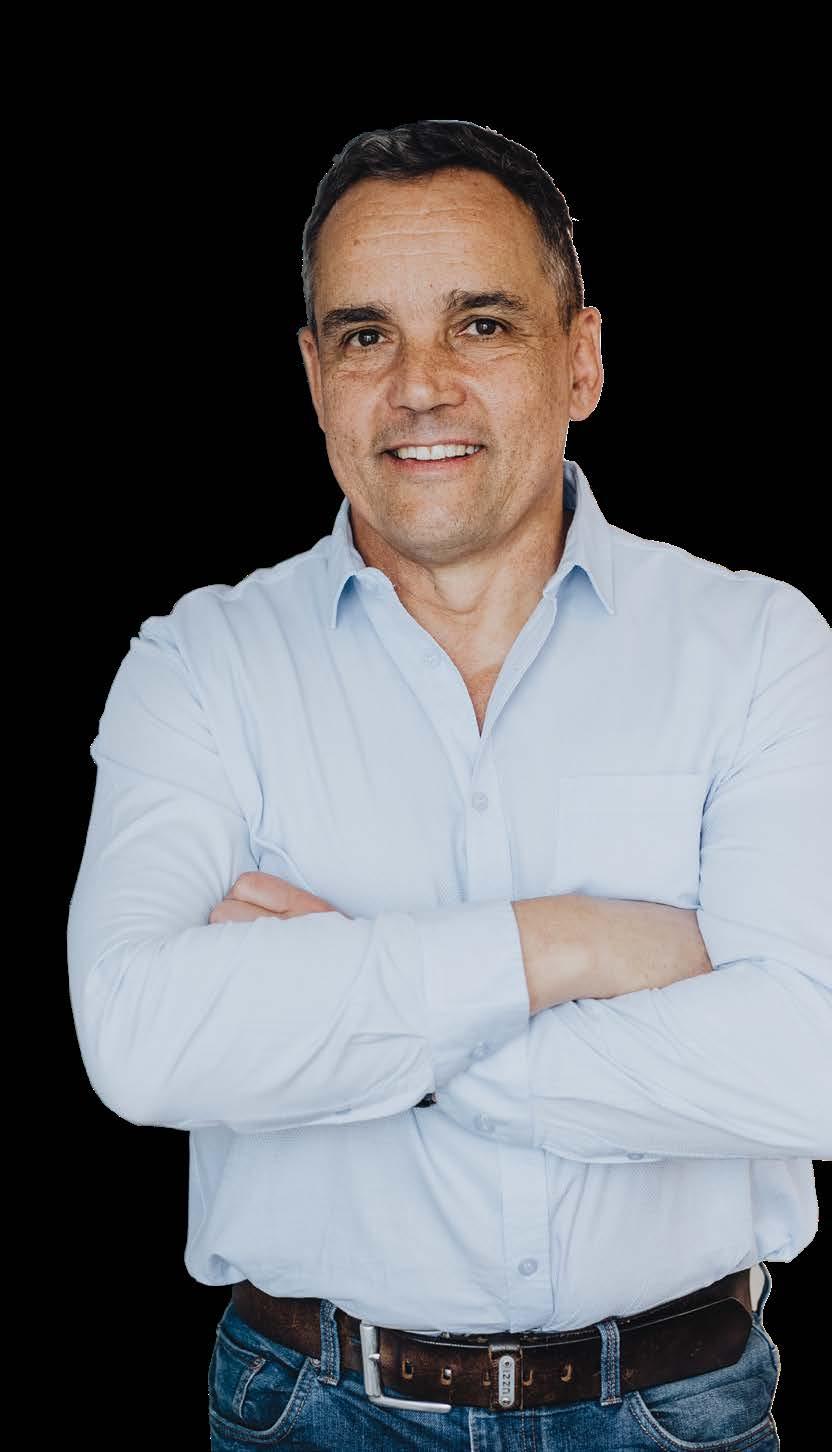
FLEETAFRICA: CHIEF OPERATING OFFICER
Christie Els
Q&A: FLEETAFRICA
40 sabusinessintegrator.co.za
FleetAfrica has made significant strides in the fleet management industry. What are the core principles that have driven its success and growth?
FleetAfrica's journey through the fleet management industry has been defined by a steadfast commitment to core principles that underpin its remarkable success and growth. These principles revolve around a relentless pursuit of excellence, unwavering dedication to customer satisfaction, and an unyielding passion for innovation.
By consistently delivering exceptional services, tailored solutions, and embracing evolving technologies, FleetAfrica has not only met but exceeded the expectations of its clients, solidifying its position as a trailblazer in the industry.
What has been the evolution of FleetAfrica’s business strategy over the years?
Originally founded in 1987 as Super Fleet and rebranded to FleetAfrica in 2012, our journey as a subsidiary of Super Group commenced with a strong emphasis on the private sector.
Over time, our reach extended to encompass the public sector. However, our current strategic drive is to expand and increase our market share in the fleet management solutions space by providing services to more companies in the private sector. Therefore, once again, our focus is keenly directed towards the private sector.
What is FleetAfrica's organisational culture and values, and how do they resonate with both your team members and the clients you serve?
Central to FleetAfrica's enduring triumph is a dynamic organisational culture rooted in values that profoundly connect with our esteemed team members and the clients we diligently serve.
Our culture thrives on collaboration, accountability, and an acute awareness of our efforts that influence our clients' operations. This collective pursuit of excellence fuels our drive to surpass expectations consistently, propelling us to explore new horizons and embrace evolution.
As we learn and grow, we continually reinvent ourselves to remain aligned with the shifts in our industry. This ethos of dedication, which clients have come to associate with the FleetAfrica experience, inspires us to remain at the forefront of innovation and adaptation.
How has FleetAfrica's commitment to technological advancement shaped the company's services and client experiences?
FleetAfrica's dedication to technological advancement has been instrumental in shaping our services and elevating client experiences to unparalleled heights. Embracing innovation as a driving force, we have harnessed cutting-edge solutions that leverage data analytics, artificial intelligence, and advanced telematics.
This commitment ensures that our clients benefit from real-time insights, predictive analysis, and streamlined operations. By consistently staying ahead of the technological curve, FleetAfrica stands as a pioneer in delivering tailored, future-ready solutions that empower our clients to navigate the complexities of fleet management with confidence.
The Fleet Intelligence Control Centre stands
Q&A: FLEETAFRICA
41 sabusinessintegrator.co.za
Embracing innovation as a driving force, we have harnessed cuttingedge solutions that leverage data analytics, artificial intelligence, and advanced telematics.
as a testament to FleetAfrica's commitment to operational excellence. This cutting-edge hub functions as a nerve centre, aggregating and analysing a wealth of data from our clients' fleets in real-time.

Through state-of-the-art technology, we provide clients with actionable insights, enabling data-driven decision-making that optimises efficiency, reduces costs, and enhances overall performance. This hub serves as a strategic advantage for our clientele, empowering them to navigate the intricacies of fleet management with precision and confidence.
What is FleetAfrica's approach to client relationships?
Exceptional service is rooted in a profound understanding of the human factor, and FleetAfrica's approach to client relationships reflects this philosophy.
We prioritise building lasting partnerships that are based on trust, open communication, and a deep understanding of our clients' unique needs. By consistently exceeding expectations and providing unwavering support, we foster strong bonds that withstand the challenges of a competitive market.
Our focus on client satisfaction is unwavering, and this dedication continues to elevate FleetAfrica's reputation as a reliable industry leader.
Q&A: FLEETAFRICA
42 sabusinessintegrator.co.za
What are the collaborative efforts by FleetAfrica that actively contribute to the community's well-being?
FleetAfrica proudly collaborates with outstanding organisations, including Reach For a Dream Foundation, which makes a significant impact in our communities.
Committed to excellence and social responsibility, FleetAfrica is honoured to support this client and contribute to their mission by providing tailor-made Fleet Solutions for their business.
How has FleetAfrica demonstrated its agility in navigating challenges and embracing opportunities?
In a dynamic industry landscape, adaptability is not just a quality, but a necessity.
FleetAfrica's agility shines through its ability to swiftly respond to challenges and embrace opportunities. By embracing change, continuously fine-tuning our strategies, and investing in the growth of our team, we have maintained our position as an industry leader.
Our proactive approach to innovation, combined with a keen understanding of market shifts, ensures that we not only survive but thrive in an ever-evolving landscape.
About FleetAfrica
FleetAfrica is a division of Super Group Africa (Pty) Ltd which is a subsidiary of Super Group Limited, a leading logistics, supply chain and mobility group listed on the Johannesburg Securities Exchange.
Founded in 1987 as Super Fleet, it was rebranded to FleetAfrica in 2012. It is a leading provider of fleet leasing, fleet maintenance and vehicle tracking and monitoring solutions on the African continent with a customer base spread across the public and private sector. These include blue chip companies, SOEs, municipalities, national and provincial government departments, etc.
The company offers a range of flexible vehicle leasing options on every vehicle class and type. These includes passenger vehicles, long haul trucks, emergency vehicles, specialised municipality fleets, security and police vehicles, implements of husbandry, waste management vehicles, civil and water services vehicles, power and electricity vehicles, mining fleets, construction vehicles, etc.
FleetAfrica has extensive experience with management information systems to tailor fit for purpose fleet management solutions for clients across the African continent.

Q&A: FLEETAFRICA
43 sabusinessintegrator.co.za

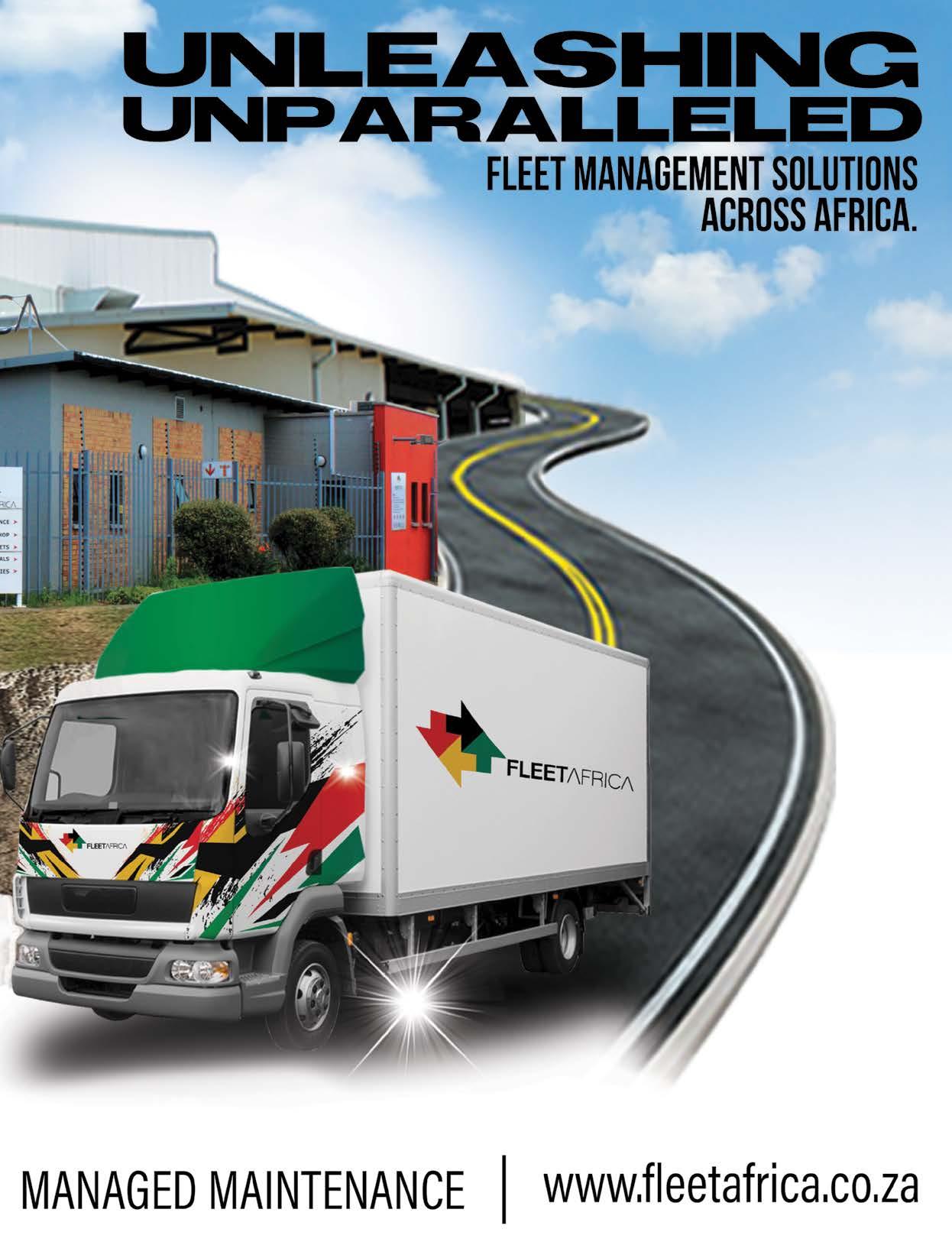
Looking ahead –
the role of AI in fleet management
Modern fleet management systems have the ability to harness data from a wide variety of sources. Still, running large fleets can result in massive amounts of data that are time-consuming to process and analyse before any decisions can be made.
 By Ctrack
By Ctrack
FLEET MANAGEMENT
46 sabusinessintegrator.co.za
The emergence of big data in the fleet management space has necessitated smart solutions in order for this data to be of real value to end users.
Fleet hardware and software solutions
Ctrack has a wide variety of well-developed fleet hardware and software solutions that work hand-inhand to give fleet managers only the data they need to make the correct decision at that point in time.
"At the core of this is Crystal, Ctrack's cloud-based fleet management platform. Crystal can process vast amounts of telematics data resulting in a business tool that offers accurate and truly powerful visibility and insight," says Hein Jordt, Chief Executive Officer of Ctrack.
Crystal is a cloud-based platform where telematics meets data intelligence and offers all the functionality that consumers have come to know and love in one location. The result is a business tool that offers so much more than simple reporting.
"AI has the ability to analyse vast amounts of data at a rapid pace and make accurate predictions based on that data," says Jordt.
Real-time data streams
Real-time data streams include precise location, speed, traffic, fuel consumption as well as camera feeds, amongst others. This data is combined to give a clear picture of exactly how assets are being used.
Based on predetermined parameters, AI constantly analyses data, refines reporting and can make predictions and recommendations that allow fleet managers to continually streamline their operations with safety and efficiency as a priority.
Short-term predictions include alerts on avoiding traffic or optimisation of routes according to traffic patterns and average length of stops.
In the medium term, AI can predict maintenance schedules based on usage and the common lifespan of components or manufacturer guidelines and assist with making service bookings that will result in the shortest downtime.
AI seamlessly automates tedious tasks
AI has the ability to seamlessly automate many of the previously tedious tasks and, in doing so, lighten the workload of fleet managers by more simply presenting fleet managers with a high-level overview, or so-called snapshot, of the data they need to make decisions at that particular moment in time. At a glance, fleet managers can get an indication of the health of their fleet, daily progress and any immediate issues that need urgent attention.
Driver behaviour is monitored and available to drivers, assisting them in improving their driving style or optimising their daily operations almost immediately via the Crystal app.
Ctrack offers a variety of camera solutions, including in-cab, external and load box solutions. Users can now add camera and video technology to the Crystal suite, offering a live feed into the inside of the vehicle and the person operating it, granting unprecedented insight into what is happening at that exact moment. As Crystal is cloudbased, this functionality gives fleet managers eyes everywhere, accessible from any smart device at any given time.
While camera systems are an excellent tool for monitoring drivers and assets, reviewing hours of footage is a time-consuming task that, in the past, resulted in inefficient use of this valuable data stream.
FLEET MANAGEMENT
47 sabusinessintegrator.co.za
AI has the ability to analyse vast amounts of data at a rapid pace and make accurate predictions based on that data.
It is in this area that AI offers massive advantages. The use of AI technology works along with the camera systems to automate the process of identifying transgressions, significantly reducing the leg work required by fleet managers in managing driver behaviour more efficiently, with deeper insights that allow for better decisions.
Cameras can detect what drivers are doing and can be configured to identify transgressions such as smoking or talking on a cell phone while driving. AI coupled with ADAS (Advanced Driver Assistance Systems) can also predict factors such as driver fatigue by monitoring their eye movements and looking out for tell-tale signs such as blinking or yawning. AI software can automatically flag and categorise unsafe driving behaviour allowing for swift action and relevant coaching.
Keeping drivers and assets safe is the fact that AI technology can detect objects such as firearms and knives and immediately notify the authorities of potential criminal behaviour at a precise location
without the driver having to do anything.
While AI is an extremely useful tool, it depends on good-quality data. Ctrack's software and fleet management solutions are naturally designed to work with Ctrack's wide variety of hardware devices but can also harvest data from other systems, such as those fitted by OEMs, including the vehicles' own CAN bus, as a single or additional data stream. This ensures that the software systems and their AI functionality have high-quality data to process and act on.
The use of AI in fleet management is still in its infancy, and the future of AI will have a massive effect on fleet management, supply chain and even traffic flow, with the potential for communication between various assets.
"Along with Ctrack's well-developed hardware and software solutions, AI is taking the guesswork out of fleet management and offering fleet managers actionable reports based on real data with the power to predict," concludes Jordt.
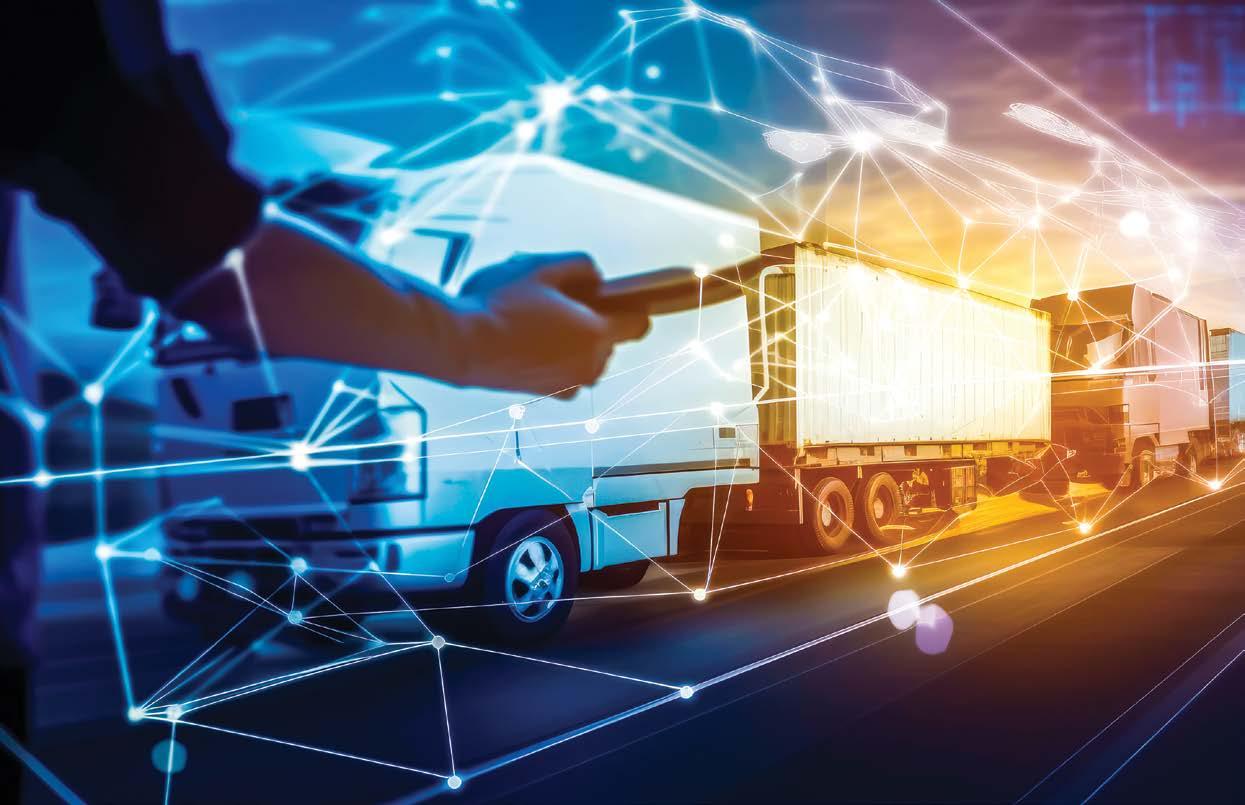
48 sabusinessintegrator.co.za FLEET MANAGEMENT
AI provides deeper insights that allow for better decisions
The Power to Predict
What if next-generation Telematics and AI could predict if your freight will be on time? Or time for an alternative route.

With Crystal by Ctrack, you can. Transport and Logistics Management, beyond tracking and reporting.

Scan QR code for more information or contact us at 0860 333 444 ctrack.com
LKDA 41906 V5
Transportation collapse threatens the viability of
the agriculture sector
Recently many people across the Western Cape went food shopping at their local supermarkets and were greeted by severely understocked or even empty shelves. Many products simply weren't available.
By Kulani Siweya, Chief Economist at Agri SA
On average, farmers are estimated to have lost 16% of their turnover as a result of transporting agricultural commodities on badly maintained roads during the last financial year.

AGRICULTURE
50 sabusinessintegrator.co.za
This was due to the taxi strike that brought Cape Town to a halt. This upheaval underscores a fact that South Africans have largely taken for granted – if our road transport doesn’t function, supermarket shelves will be empty.
Roads are what keep this country going. But our road network is becoming more and more dysfunctional by the day. There are a number of problems that contribute to this dysfunction protestors blocking roads; truck arson attacks; freight looting; criminally unsafe driving practices; decaying road infrastructure. These problems are reaching such an intensity that they are now beginning to threaten the viability of the agriculture sector.
Farmers bear the brunt of poor road conditions
A survey conducted by Agri SA last year found that the estimated average of repair costs and related expenses due to poor road conditions was approximately R200 000 per farmer. This excludes logistical problems some farmers experience such as the regular delays in deliveries as a result of decaying rural roads. On average, farmers are estimated to have lost 16% of their turnover as a result of transporting agricultural commodities on badly maintained roads during the last financial year.

Dangerous roads are also adding to the already substantial financial burdens of our farmers as the cost of road freight transport increases. As Gavin Kelly, the CEO of the Road Freight Association recently pointed out, the long-term impact of truck attacks and looting "will be felt in terms of increased security costs into the cost of logistics, higher insurance premiums, higher SASRIA cover premiums, higher toll fees."
Agri SA's figures show that 94% of all agricultural commodities are transported by road. In the past, the rail network presented a secondary transport option, but because of the destruction and decay of our rail infrastructure, this isn't the case anymore.
Just between 2011 and 2019 rail's share of the agricultural extraction market decreased from 18% to 3%, and since 2019 this percentage declined even more dramatically. The complete dominance of road freight has removed an element of competition from the market, and it has resulted in further price pressures on farmers.
AGRICULTURE
51 sabusinessintegrator.co.za
Funding for road maintenance must be increased
This situation is not sustainable. Specific transportation issues need to be addressed with targeted solutions, and there are a number of priority areas that need to be addressed urgently.
First, funding for road maintenance must be increased. This must not be seen as an expense but as an investment. Without good rural roads, agriculture won't grow. Farmers should also be included in administrative processes relating to road infrastructure and repairs. Agri SA has found that producers have knowledge and expertise that can be used on a decision-making level by authorities.
Moreover, the Department of Transport and municipalities must assist SANRAL in addressing the poor rural road network. Better cooperation and communication between these role-players are essential.
Law and order on our roads and railways must be a priority
Law and order on our roads should be a priority of the police service. Where the police cannot address the problem alone, other plans must be made. Agri SA recently called on the government to deploy the South African National Defence Force in support of the police to protect major transportation routes.
Rail safety and security must also be addressed. A recent report by the South African Institute of Civil Engineers has underscored that
the increased vulnerability to theft, sabotage, and vandalism has paralysed our rail network.
"The rising trend of sabotage, theft, and vandalism has resulted in high costs of corrective maintenance as opposed to preventative or asset life cycle maintenance regimes and have impacted safety performance," the report further explains.
Private investment in rail must be fasttracked
Furthermore, the entry of private investment in rail must be fast-tracked. The tender to upgrade the Durban harbour was awarded to the International Container Terminal Services (ICTSI), but public-private partnerships of this size need to take place on the rail corridors leading to harbours as well. Improving rail will relieve pressure off our roads.
The disintegration of our road and rail networks is nearing a point beyond which the country's food security will be affected. Even if the government addresses all other agricultural issues threatening production, such as load shedding, water infrastructure, expropriation, and labour issues, among others, the connection between producer and consumer needs to be safe, strong, and functional. That connection is formed by our roads and railways. It is, literally, a lifeline.
Urgent action is therefore needed on the issue of transportation collapse in South Africa, and the government, agricultural associations, and farmers must work together to enact the necessary transport solutions.
The empty shelves consumers saw during the recent taxi strike, as well as during the Covid logistics crisis and the July 2021 riots, should be seen as warnings. These crises demonstrate how fragile the transportation chain in South Africa is. Urgent action must be taken to secure this essential link between consumers and the farms that produce the food we need.
52 sabusinessintegrator.co.za AGRICULTURE
The disintegration of our road and rail networks is nearing a point beyond which the country's food security will be affected.

Transformation in logistics,

transport and supply chain
Over recent years, the logistics and transport sector in South Africa has embarked on an exciting journey of transformation, fuelled by rapid advancements in technology and a growing commitment to promoting collaboration, inclusivity, diversity, development, and sustainability.
By Catherine Larkin, APR CMILT, Chief Visionary: CVLC Communication
If you want to go fast, go alone: if you want to go far, go together. African proverb
OPINION
54 sabusinessintegrator.co.za
These elements all lead towards responsible, safe business practices, which make business sense. There are a number of organisations and initiatives that have been instrumental in driving change and reshaping the industry. In this opinion piece, I explore just some of the proactive efforts to promote inclusivity, development, and sustainability in the logistics and transport sector.
Digital transformation: paving the way for the future
Digital transformation has emerged as a disruptive force in the logistics and transport sector, revolutionising how goods and people move across South Africa. The adoption of cuttingedge technologies, such as cloud computing, artificial intelligence, and the Internet of Things, has facilitated real-time tracking, improved supply chain visibility, and optimised route planning – all resulting in increased efficiencies and optimisation.
The Road Freight Association (RFA) has been at the forefront of driving digital transformation within the trucking industry. Through initiatives like its "Smart Trucking" programme, RFA members are encouraged to invest in advanced telematics systems, enabling remote vehicle monitoring, predictive maintenance, and fuel-efficient driving. This not only reduces operational costs, but also minimises the sector's environmental impact, contributing to a more sustainable transport network.
Collaboration, inclusivity, and diversity: empowering the industry
Promoting collaboration, inclusivity, and diversity is essential for the long-term success and sustainability of the logistics and transport sector. The Chartered Institute of Logistics and Transport South Africa (CILTSA), part of an international, professional body, plays a pivotal role in fostering dialogue among industry stakeholders, encouraging knowledge exchange, and promoting
best practices. By providing a platform for professionals to come together, CILTSA ensures that diverse voices are heard, and innovative solutions are developed.
One of the most significant and much-needed shifts in recent years has been the focus on empowering women in the traditionally maledominated logistics and transport sector. Women Leading Women in Transport (WiWiT) is an initiative of the Commercial Transport Academy (CTA).
Supported by the US government through the United States Agency for Development (USAID) and launched in 2021, WiWiT focuses on training women to become truck drivers, managers, and entrepreneurs in the transport sector. The programme will train and mentor one thousand women: 120 female professionals, 300 entrepreneurs, and 495 truck drivers over a threeyear period. Part of the training programme for female professionals includes an international, portable qualification from the Chartered Institute of Logistics and Transport.
Though progress is happening, there is still a lot of work to be done. According to Nicci Scott-Anderson, Founder of the CTA, less than 1% of the workforce in South Africa’s transport sector are women, making training for women an urgent imperative. Transport and logistics play a critical role in economic development. Transport contributes 8% to the total GDP and has the ability to create four jobs per R1 million invested. Yet it remains the least gender-transformed sector in our country.
The WiWIT initiative, supported by CILTSA, has been instrumental in promoting gender equality, providing mentorship programs, and advocating for equal opportunities. As more women enter the industry, fresh perspectives and talents are enriching the sector's workforce, leading to enhanced innovation and problem-solving.
Inclusivity however extends beyond gender
OPINION
55 sabusinessintegrator.co.za
equality. The logistics and transport sector recognises the importance of uplifting small, medium-sized enterprises (SMMEs) and the youth. The RFA, CILTSA, and the CTA have been actively involved in developing training programmes and mentorship schemes to equip aspiring professionals with the necessary skills and knowledge. This not only addresses youth unemployment, but also fosters a pool of skilled workers that will drive the sector's growth in the future.
Promoting development and sustainability: a forward-thinking approach
Promoting development and sustainability is no longer an option but a necessity for the logistics and transport sector in South Africa. The country's commitment to achieving the United Nations Sustainable Development Goals (SDGs) has spurred industry players to implement environmentally responsible practices.
The facts are sobering. Emissions from the transport sector account for 10.8% of South Africa’s total greenhouse gas emissions, with road transport being responsible for 91.2% of these GHG emissions (Department of Environmental Affairs, 2010).
In a global context, transport is at the centre of many economic and social development challenges, accounting for about 64% of global oil consumption, 27% of all energy use, and 23% of the world’s energy-related carbon dioxide emissions (International Institute for Sustainable Development). Global roadway emissions are 70% higher now than they were in 2005.
Increasing knowledge and expertise
At the heart of CILT is its commitment to life-long learning. Sustainability and green programmes are an integral part of the suite of CILT courses
and continuous professional development (CILT) programmes, all of which are recognised internationally.
The CILT Certificate in Managing Sustainability in Transport and Logistics aims to increase the awareness of sustainability in transport and logistics industries, as well as building skillsets required for professionals in the transport sector. More details are available at https://www.cilt.ie/ Education-Exams/Our-Courses/Short-Courses/ Certificate-in-Managing-Sustainability-inTransport-and-Logistics
WiLAT launches sustainability leadership programme
In response to growing concerns around the world around sustainability, Women in Logistics and Transport (WiLAT), an interest group of the CILT, launched the WiLAT Sustainability Leadership Programme. It is designed to prepare managers to undertake a leadership role in their organisation’s initiatives toward sustainability.
It is focused on managers in the supply chain, logistics, and transport industry, practitioners leading sustainability projects, and those who would like to formalise their sustainability effort into an Environmental, Social and Governance (ESG) report. (More information can be accessed at www.ciltsa.org.za)
The Road Freight Association (RFA) has a dedicated "Green Transport" interest group, which encourages companies to transition to eco-friendly and fuel-efficient vehicles. Currently chaired by Liesl de Wet, the Group regularly shares international updates on key advancements in green trucking technology –from electric trucks and hydrogen-powered trucks to aerodynamic designs, lightweight materials, and automated driving systems.
“Overall, these technological advances in green trucking have the potential to reduce greenhouse gas emissions, improve air quality,
OPINION
56 sabusinessintegrator.co.za
and reduce the environmental impact of the trucking industry,” says de Wet.
“There are many nuances for the wide-spread application and successful roll-out of these technologies. However, work needs to continue in keeping abreast with these new technologies and working together to find solutions that are easily implementable and cost competitive.”
As these technologies continue to evolve and become more widely adopted, the future of green trucking looks promising.
Looking beyond green – to sustainability
In its efforts to encourage the logistics, transport and supply chain industry to drive sustainability, CILT in South Africa also hosts its annual Environment, Sustainability and Governance (ESG) Conference, which shares the latest trends, best practices and tools. This event has proven to be tremendously popular, as attendees benefit from practical insights and inputs from industry leaders and ESG experts.
By promoting collaboration, inclusivity, and diversity, the industry is building a diverse and skilled workforce that will drive innovation and growth.
Challenges and opportunities
Despite the solid progress made, the logistics and transport sector in South Africa faces several challenges on its journey of transformation. One of the primary obstacles is the lack of widespread access to digital infrastructure, particularly in rural areas.
To ensure the benefits of digital transformation are inclusive, it is crucial for industry players
to collaborate with the government and other stakeholders to improve digital connectivity across the country.
The industry is positioning itself for a more competitive, brighter, and responsible future
The logistics and transport sector in South Africa is undergoing a profound transformation, driven by digitalisation, collaboration, inclusivity, development, and sustainability. Through the efforts of key players such as the Road Freight Association (RFA), the Chartered Institute of Logistics and Transport South Africa (CILTSA), the Commercial Transport Academy, and Women Inspiring Women in Transport (WiWiT), the industry is positioning itself for a more competitive, brighter and responsible future.
Achieving true inclusivity and diversity, however, requires sustained effort and unwavering commitment – by all stakeholders. Encouraging the participation of underrepresented groups, such as women and SMMEs, requires ongoing support, mentorship, and access to funding opportunities.
Digital transformation has revolutionised operations, enhancing efficiency and sustainability. By promoting collaboration, inclusivity, and diversity, the industry is building a diverse and skilled workforce that will drive innovation and growth. Moreover, the sector's commitment to sustainable practices ensures that it remains a responsible steward of the environment and society.
As South Africa's logistics and transport sector embraces change, it is crucial for all stakeholders to remain steadfast in their commitment to transformation. By continuing to collaborate and invest in the industry's future, we can build a thriving logistics and transport sector that serves as a pillar of economic growth and sustainable development for the entire nation.
OPINION
57 sabusinessintegrator.co.za
Enhancing transport infrastructure to create a more equal and prosperous nation
The transport industry accounts for 6.5% of South Africa’s economic output, and there can be no doubt that it is the backbone of the country, connecting people and businesses, and driving productivity by delivering value through the value chain.
The transport industry accounts for 6.5% of South Africa’s economic output, and there can be no doubt that it is the backbone of the country, connecting people and businesses, and driving productivity by delivering value through the value chain.
South Africa has a well-developed transport infrastructure across road, rail, air, and maritime, although the sector faces several challenges, including lack of proper maintenance, sabotage, and other acts of criminality, as well as structural and legacy inequalities.
Contributing to the economy
Coca-Cola Beverages South Africa (CCBSA) is a leading bottler. We operate 13 manufacturing facilities across the country and distribute products through an expansive road distribution network, which reaches almost all corners of the country.
We believe we have a responsibility to create shared value for the business and the communities we serve across the value chain through opportunities we create as we grow our business.
We acknowledge that, for any company to survive in the current environment, characterised by economic challenges and an increase in volatility in communities, it needs a comprehensive
review of the way in which business is conducted. This includes relevant market targeting, driving efficiencies, paying due regard to the environment, ensuring profitability for a business and operators who enable companies to get to their customers, and importantly creating shared value for the communities in which we operate.

CCBSA has an Owner Driver Scheme which is an integral part of our business. This programme has enabled us to support the growth of operators who own their businesses and to support South Africa’s development mandate, where we provide previously disadvantaged groups the economic opportunity to be part of the supply chain of a major industrial operation.
In our efforts to take our products closer to customers, we also have the Local Distribution Partners (LDP) programme, reaching those who live in townships and rural areas through small businesses. Working closely with the LDPs, CCBSA has ensured smoother delivery and enhanced customer service and has also created much-needed opportunities for entrepreneurs.
Ninety percent of LDPs are from previously disadvantaged groups. Not only do LDPs create work opportunities for themselves, but they also
Dlise na P i l l a y , Logisti forCoca-Cola Beverag f ica
ADVERTORIAL: COCA-COLA BEVERAGES SOUTH AFRICA
58 sabusinessintegrator.co.za
employ drivers, crew, and warehouse staff from local communities.
These are just a few examples of the many transport and logistics innovations that we, in conjunction with the Department of Transport, are developing to improve safety and productivity within South Africa’s logistics industry.
CCBSA also runs initiatives to empower SMMEs, especially for women, youth and rural communities, through our hugely successful Bizniz in a Box (BiB) programme; as well as our Study Buddy bursary fund to support young people with educational support. We have also rolled out our Cokeville project to water-stressed communities around the country.
Our commitment to safe road use
We have further heeded the government’s call to participate, as a business, in providing a safer, more affordable, accessible, and reliable transport system, while ensuring ongoing commitments towards carbon emission reduction.
About CCBSA
Together with the Department of Transport, through the Arrive Alive campaign, we launched a state-ofthe-art simulator truck that aims to improve the competency levels of truck and bus drivers, as well as other public transport drivers.
We are a major road user and support our country’s efforts towards improved road safety. We have integrated training in all our business operations to ensure we entrench a responsible mindset amongst our drivers and operators.
We are in the middle of a five-year pilot Smart Truck Project that was initiated in 2019, to run a 44-pallet Performance-Based Standard (PBS) trailer between Bloemfontein and Upington. The PBS trailer is 27.9 metres long and can transport 44 pallets, compared to the conventional 30-pallet trailer.
This project has seen the redesign of PBS trailers to minimise damage, improve safety, and reduce congestion on the roads. This approach uses performance-based standards, which specify the performance required of a heavy vehicle on particular routes, bearing in mind both safety and the nature of the road infrastructure itself.
Our efforts and innovations are driven by a recognition that for as long as we have our fleet of trucks moving across the country, we carry a joint duty and responsibility to support the government in managing road congestion and contribute to road safety.
Coca-Cola Beverages South Africa (CCBSA) is a proudly South African company that began operating as a legal entity in July 2016, after the merger of six non-alcoholic ready-to-drink bottling operations. We employ over 7 000 people at 13 manufacturing facilities across the country. As a subsidiary of Coca-Cola Beverages Africa (CCBA) and a bottler for The Coca-Cola Company, our vision is to refresh Africa every day and make our continent a better place for all.
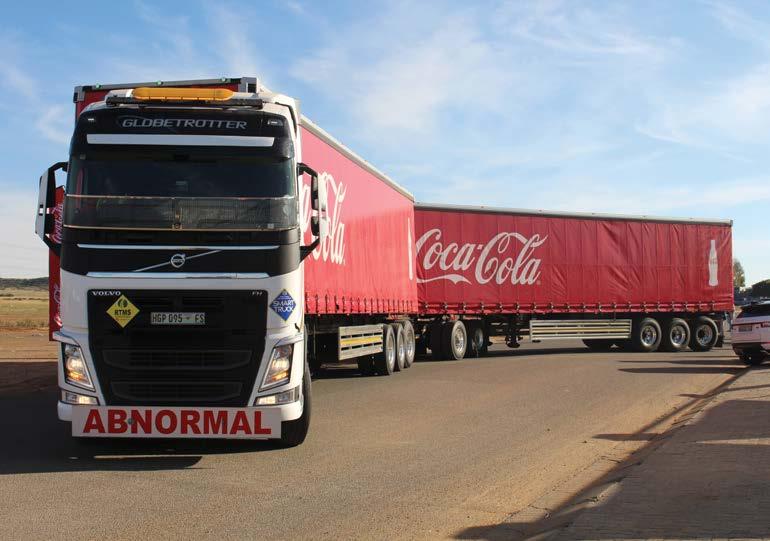

59 sabusinessintegrator.co.za
ADVERTORIAL: COCA-COLA BEVERAGES SOUTH AFRICA
Driving affordable and effective training
in the motor industry
distribution
By Mike Hanly, Managing Director at New Leaf Technologies
Accordingly, auto companies spend hundreds of hours looking at ways to provide essential features and remove unnecessary components to deliver a product that won’t break the bank. By pursuing a strategy of frugal engineering, they can effectively reduce costs.
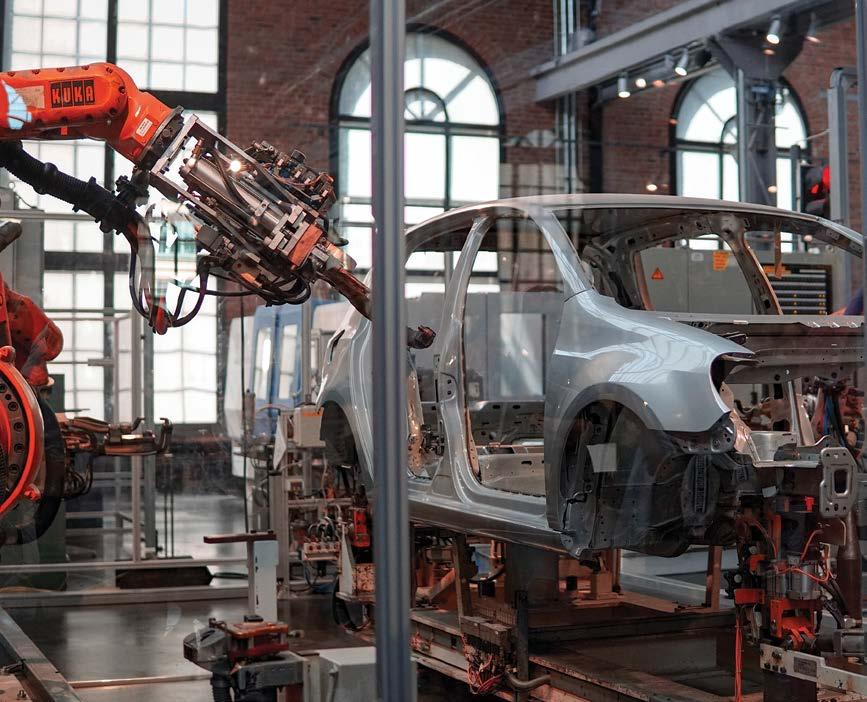
Vehicle manufacturers are also increasingly turning to technology to help save money. The use of artificial intelligence systems, for example, is already noted for bringing down costs while also increasing production output. That is not to say humans are falling by the wayside. Quite the contrary, in fact.
Workforce needs to be trained to manage the latest developments
With the industry undergoing such dramatic change, the workforce needs to be trained to manage the latest developments. New products being developed require skilled employees to oversee the process and there obviously has to be an oversight function performed by human workers. What is important to note is that training itself can be costeffective.Technology has become highly democratised and even smaller companies can access it for training purposes.
Cost-effective training methods enable organisations to reach a wider audience and provide training to more employees, increasing the potential for improved sales and customer satisfaction.
TRAINING
The process from concept and design to production and
is not a cheap one, and vehicle manufacturers are faced with the additional challenge of having to balance these costs with what consumers can afford.
60 sabusinessintegrator.co.za
Microlearning: Content is delivered in bite-sized modules that are focused and easily understood.
Some of the most popular training innovations
Gamification: Game-like elements to make training more engaging and interactive.
Mobile learning: The need for physical resources is reduced as training can be delivered anytime, anywhere.
User-generated content: Learners create and share their own content, negating the need for expensive external content development.
Virtual reality (VR) and augmented reality (AR): Immersive technologies to create realistic training simulations without the need for physical equipment.
Fit-for-purpose digital learning tool
Technology has become highly democratised and even smaller companies can access it for training purposes.
Automotive industry training should be results-driven
The automotive industry is incredibly results-driven, meaning that training should be too, Hanly says. Ultimately the learning and development should contribute to the company remaining competitive and, as such, training should be geared towards the goal of achieving higher return on investment. Resources and costs saved can then be allocated to other strategic initiatives.
Cloud-based learning management systems are very good for saving money on storage, management, and delivery of training content, while the use of analytics and data can very quickly establish what training modules are working and which are not. Those that fall short can then be adapted or removed, ensuring that little capital is wasted on frivolous content.
New Leaf Technologies offers a fit-for-purpose digital learning tool called aNewSpring that enables trainers to create, curate and deliver blended learning that adapts to each individual. The flexibility of the platform ensures that learners can access the training they need, even if they are working remotely.
This technology can also be tailored to incorporate interactive multimedia elements such as videos, quizzes, and simulations to engage learners and improve knowledge retention. With the auto sector changing as much as it is, being able to learn quickly and affordably is essential and this platform really meets this requirement.
Additionally, a lot of training will be focused on soft skills as these will play an even greater role in differentiating between competing vehicle manufacturers.
Effective communication and meeting customer expectations will be critical going forward, and developing these skills are important if companies are to retain or grow their market share.
Properly trained employees can deliver exceptional customer service, fostering customer loyalty, positive word-of-mouth, and repeat business.
TRAINING
61 sabusinessintegrator.co.za
A STRATEGIC PARTNER OF CHOICE FOR DEFENCE AND SECURITY SOLUTIONS
The Armaments Corporation of South Africa SOC Limited (Armscor) is an acquisition agency for the South African Department of Defence (DOD), and other organs of state and entities.

AB Logistics
AB Logistics (AB Log), a Corporate Service division of Armscor, is a shipping and travel company which provides clearing and freight forwarding plus travel management services to Armscor, the DOD, the Defence Industry and commercial clients both domestic and global.
The freight services are road, rail, sea and air; AB Log are specialists at domestic and international transportation and distribution. The travel division manages flights, car rental, bus bookings, shuttle services and accommodation for Armscor and DOD.

Services offered
• Clearing and freight forwarding – provision of state of the art freight services. Customs clearances and requisite embargo clearances.
• Road, rail, sea and airfreight services – transportation of goods and cargo via road, rail, sea or air depending on client needs and requirements.
Armscor's mandate is to provide the armed forces with state-of-the-art defence matériel, delivering innovative defence solutions efficiently and effectively. The organisation manages the strategic capabilities of the DOD, producing research and vanguard technological solutions required to provide safety and security for South Africa, its citizens and the continent.
• Transportation of explosive and sensitive cargo – adherence to all relevant regulatory provisions in transportation of such sensitive cargo.
• Travel management services – provision of travel requirements such as flights/bus and/or coach transportation, accommodation, shuttle services and car rental hire.
Contact us for more information: +27 (0)12 428 2455 012 - 428 2455 / 082 4671818 (Senior Manager) | 012 - 428 2484 / 082 4671822 (Shipping Manager) | 012 – 428 2164 / 082 467 1821 (Warehouse Supervisor) | 031 – 337 7647 / 083 252 1012 (Branch Manager – Durban Office) | 012 – 428 2038 / 083 655 6702 (Travel Manager)
Gerotek Test Facilities
Gerotek Test Facilities (Gerotek), a subsidiary of Armscor SCO, is an internationally accredited multidisciplinary facility offering various ISO 17025 accredited tests. The facility primarily aims to meet South Africa’s needs in the testing of defence-related and commercial vehicles and products.
Gerotek’s well-maintained facilities are located just 20km west of Pretoria in the Gauteng Province, a 520ha site designed and built in accordance with international standards to offer unparalleled technical and service excellence to local and international markets.
Who we serve
Gerotek offers world-class ISO-accredited and certified facilities and services that can be used by both local and international clients to test and evaluate the performance of their vehicles and products. Services are designed to cater for the exact requirements of clients, to meet and exceed customer expectations.
Contact us for more information:
Service offered
• Vehicle and product testing – Gerotek offers ISO 17025 accredited testing that adhere to international standards in order to promote repeatability and accuracy of tests. Gerotek offers a broad range of vehicle and product testing services including vehicle characterisation, endurance, evaluation/qualification of electronic, electrical and mechanical, systems and components; fatigue testing and analysis, electromagnetic compatibility, antenna testing, etc.
• Advanced driver training – Gerotek’s advanced driver training focuses on safe driving practice in a safe, controlled environment under expert supervision. Training interventions on offer include defensive, advanced, high performance, offensive and 4x4 driver training. Gerotek advanced driver training offers TETA and SASETA accredited and other non-credit bearing driver training courses.

• Facilities hire – Gerotek’s well-maintained venue is suited for work and play. It is a unique venue for conferences, product launches, seminars, team-building activities, exhibitions, on- and off-road test tracks, an accredited shooting range, etc. Gerotek facilities are ISO 14001 and ISO 45001 certified.
• Events, recreation and conferencing – Gerotek’s event services are tailored to unique client needs, suited to enable corporate clients to get down to serious business in the conference venues and then have fun outdoors as they take advantage of the many recreational pursuits it offers.
• Restaurant and catering – The African-themed Sidibane Restaurant venue offers excellent catering facilities suited to any occasion, from a relaxed cocktail party or a spit braai to more formal events.
+27 (0)12 371 2000 / 2065 / 2059 / 2052
info@gerotek.co.za
www.armscor.co.za
Transnet National Ports Authority
partners with CSIR
Collaborative approach to understand the impact of extreme wind disruption to operations at the Port of Cape Town (PoCT).
Transnet National Ports Authority (TNPA) has signed a memorandum of agreement (MoA) with the Council for Scientific and Industrial Research (CSIR)-hosted programme, the Alliance for Collaboration on Climate and Earth Systems Science (ACCESS), and other research institutions to establish a series of research projects aimed at understanding the impact of extreme wind disruption to operations for the integrated maritime transport logistics chain at the Port of Cape Town (PoCT).
In the last few years, the PoCT, lost on average 1 200 hours per year of operational time due to extreme wind disruption. Extreme wind gusts can result in terminal equipment becoming unsafe to operate, thereby impacting terminal operations. This sometimes leads to congestion inside and outside the port, resulting in vessels being at anchorage for extended periods. Several industries, including the time-sensitive fruit industry, are severely impacted by wind disruptions in the port.
Research experts at universities involved
The research is being conducted by experts in various institutions who possess the skills required to address the problem. Climate specialists at the University of the Witwatersrand are studying the seasonal climate patterns that result in these extreme winds to establish whether there are trends and whether the wind is indeed intensifying
with time, as well as how the wind patterns in the Cape Peninsula and the port are likely to change as a result of climate change.
Researchers at the University of KwaZuluNatal and the University of Cape Town (UCT) are examining the current and future economic impact of these disruptions on specific value chains to estimate the financial losses and assess the required investment into adaptation measures to deal with the problem. The CSIR and UCT are focusing on feasible engineering and operational adaptations to address the challenge.
Advocate Phyllis Difeto, TNPA Managing Executive for Western Region ports, who signed the MoA, says that the TNPA appreciates the increasing risk of environmental challenges to port operations and that, unless these are carefully understood and managed, they can add a burden to the smooth management of the ports, which are vital to the functioning of the country’s economy.
“Climate change presents a growing challenge to shipping and ports in that it impacts the state of both land and sea operations.”
Extreme events are projected to intensify
CSIR Senior Researcher and ACCESS Director, Dr Neville Sweijd, says extreme weather is really the way in which climate change manifests.
64 sabusinessintegrator.co.za PORTS
He explains that these extreme events, which occur in South Africa and everywhere else, are projected to intensify as global warming and climate change manifest further, and this is how people will experience it in their lives and work.
“The extreme wind problem in the PoCT is a classic example. It is not a new problem, but potentially a worsening one, and so it will increasingly have an impact on lives and livelihoods all around the Western Cape, especially for those people who are involved in
the fruit export industry,” says Sweijd. He explains that the project seeks to produce solutions that can be used to adapt to and manage extreme wind impacts.

“We cannot turn the wind off, but we can learn to better work with it,” he adds.
Research team to work closely with TNPA and port stakeholder
Stakeholders representing exporters and importers, freight management, and producer associations met in June 2023 at a workshop to outline and scope precisely how businesses were impacted by port disruptions. The MoA between TNPA and the research consortium will provide researchers with access to valuable data sources that are required for the study, and the TNPA will facilitate engagements with their key clients and stakeholders. The research team will work closely with TNPA and the port stakeholder over the next two years to find optimal ways of addressing the challenge.
“Strategic partnerships are critical for a successful and integrated maritime transport logistics chain, and TNPA continues to collaborate and partner with all stakeholders to optimise the value proposition of the and the Western Region,” says Advocate Phyllis Difeto.

65 sabusinessintegrator.co.za PORTS
Local aviation
pioneer celebrated
South African-based aviation group Pegasus Universal Aerospace is revolutionising air travel with the development of its groundbreaking Pegasus Vertical Business Jet (VBJ), and its efforts in this space are increasingly gaining recognition through various industry accolades.
A growing leader in aviation innovation for the past
11 years, its visionary VBJ aircraft concept has recently been recognised with two prestigious awards. The first was the Most Innovative Business Jet Manufacturing Company award at the global Aviation and Aerospace Awards 2023, granted earlier this year in recognition of Pegasus’ commitment to pushing the boundaries of aviation technology.
More recently the organisation was honoured with the Innovation Award for SMMEs award at the National Science and Technology Forum’s (NSTF) 2023 awards. This was granted in celebration of the cutting-edge technology and engineering prowess behind the development of the VBJ, and its potential to completely redefine the personal, business, and emergency aviation landscape.
Redesigning air travel
Spearheaded by Dr Reza Mia, Pegasus founder and Chairman, the VBJ represents a paradigm shift
in the aviation industry by combining the luxury, speed, and range of jets with the convenience and vertical take-off and landing (VTOL) capability of helicopters.
The aircraft is in a late-stage prototype testing phase and is hoped to eventually eliminate the need for traditional runways, opening up a myriad of landing options in urban areas, mountainous regions, and even on moving platforms such as yachts.
The Pegasus’ impressive speed and range, which measure up to four times that of traditional

66 sabusinessintegrator.co.za AEROSPACE
helicopters, will significantly reduce commuter travel times.
“Corporate executives and business leaders will be able to lift off from their homes or business premises at any time, significantly saving on travel time to and from airports, enabling them to conduct cross-country meetings in a single day,” says Dr Reza.
“Passengers will also experience the utmost comfort and luxury inside the VBJ. The spacious and elegantly designed interiors will redefine the in-flight experience, making business and leisure travel a delight.”
Beyond its utility for business or private use, the VBJ’s adaptability and enhanced range and speed makes it ideal for emergency response and humanitarian aid missions. During crises such as natural disasters, medical emergencies, or search and rescue operations, quick and efficient transportation is crucial for providing timely assistance and saving lives. The VBJ’s vertical take-off capability will further allow it to operate in areas with limited or damaged infrastructure, where traditional runways may be unavailable or inaccessible.
Dr Reza explains that as the aviation industry continues to face mounting pressure to reduce its environmental impact, the VBJ's fuel-efficient design represents a step forward in adopting more eco-friendly practices. Despite its jet capabilities, the VBJ is designed to be fuel-efficient and environmentally conscious, adhering to stringent emission standards. It is thus well-positioned to lead the way for greener alternatives in the business aviation sector.
Recognition from the business and aerospace communities
Both the NSTF Innovation 2023 award for SMMEs and the Most Innovative Business Jet Manufacturing Company award come as significant milestones for the company and the local aviation sector.
In particular, the NSTF Innovation Awards are highly regarded as a platform for celebrating outstanding contributions to science, engineering, technology, and innovation in South Africa. The SMME category specifically focuses on recognising the exceptional achievements of small to medium enterprises that have made a significant impact in their respective fields.
The award acknowledges the company's relentless pursuit of groundbreaking technology, exemplified by its revolutionary VBJ project. This prestigious accolade serves as validation of the company's commitment to advancing aviation technology and fostering innovation in South Africa's aerospace sector.
Meanwhile, the Most Innovative Business Jet Manufacturing Company award from the Aviation and Aerospace Awards has further solidified Pegasus as a trailblazer in the aviation space. It reflects the dedication and special care put into the VBJ’s design and development, perfectly combining the luxury, speed, and range of traditional jets with the convenience of advanced VTOL systems.
“These awards have helped to cement Pegasus as the innovative, influential aerospace company that we have always believed it would be. Looking ahead, we now plan to expand the VBJ’s utility potential, global market reach, and scientific significance in the coming years. We will proudly add these awards to Pegasus’ growing collection of industry accolades, and we are enormously encouraged to see the VBJ’s revolutionary concept gaining increasing public attention,” concludes Dr Reza.
67 sabusinessintegrator.co.za AEROSPACE
... the VBJ's fuel-efficient design represents a step forward in adopting more eco-friendly practices.
M84 Geotech –geohazards mitigation and rope access
M84 Geotech is a South African company that was established in 2014 in the mining town of Mokopane in Limpopo province. The company is a geohazards mitigation and rope access company specialising in rockfall protection, rockfall barriers, rock scaling, slope stabilisation, and slope monitors installations for open pit mines.
The company is one of the few contractors who are accredited to install slope stabilisation and rockfall mitigation systems for open pit mines and is an accredited member of the Institute For Work At Heights (IWH).

ADVERTORIAL: M84 GEOTECH
68 sabusinessintegrator.co.za
The specialist
Early on, M84 Geotech decided that it would be a specialist in what it did and be valuable to the mines, starting with four experienced rope technicians who made up the company’s first geohazards mitigation and rope access team. In 2018 the company landed its first working-at-height project at Mogalakwena mine to do rock scaling on a high wall.
Since then we have been building ourselves up as the next best alternative and partner when it comes to rockfall protection, rockfall barriers, slope stabilisation, and rock scaling for open pits mines.
As a company, M84 Geotech prides itself on having a 100% completion rate on every project it has undertaken and also maintaining a 100% safety record on-site. The company’s motto is “Safety is our Priority.”
The systems M84 Geotech uses to keep open pit operations safe from rockfall hazards and slope failure are some of the best in the market. Mines are guaranteed a professional service and the safest installation methods. The use of rope access techniques makes it possible for M84 Geotech to install systems with minimum interruption to production.
Completed projects
Building the brand
M84 Geotech’s goal is to build its brand to be associated with what it does best; a leader in the field of geohazard mitigation and rockfall protection systems in the mining sector and other related fields.

M84 Geotech is the go-to contractor when it comes to slope stabilisation, rockfall protection, rockfall barriers, rock scaling, devegetation on high walls, and slope monitoring installations. It is highly experienced in managing high-pressure and high-risk projects with a high level of quality and safety.
For most, if not all of M84 Geotech’s mining clients, safety is very important. Rockfalls are a serious risk in open pit mines and if this risk is not managed or controlled, lives could be lost, and equipment damaged.
M84 Geotech has the experience, resources, and skills to provide a mining site with the right solution, in the form of preventative measures such as installing slope monitoring prisms or through protection systems such as drape mesh, slope stabilisation or catch fences.
Some of the projects M84 Geotech has completed successfully include:
• Rock scaling: Rock scaling involves moving loose rocks on open pit mine high walls to prevent them from free falling to the foot of the slope. We have moved boulders on high walls to protect miners and equipment.
• Devegetation: If not controlled, vegetation on open pit high walls can make it difficult for the Geotech team to monitor slopes. Using rope access techniques, vegetation can be removed or trimmed to keep the high wall clear of obstructions.
• Prism installations: Prisms are installed on high walls to monitor any movement on the slope. There is no interference with production as we do the work while suspended on ropes.
• Rockfall protection: Depending on the needs or scope of the client, we have a few systems that we use to protect open pit mines against rockfall hazards. Our team will provide the relevant solution according to the needs and conditions of the site.
• Drilling and anchor installation: Whether on the surface or on a high wall, we have the expertise to drill and install anchors.
T +27 (0)15 023 1400 | M +27 (0)72
203 8405 | W www.m84geotech.co.za
E info@m84geotech.co.za | admin@m84geotech.co.za
11 Sussex Street, Mokopane 0601. 26 Rhodesdrift Street, Building 4, Suite 3
Rhodesdrift Office Park, Bendor Polokwane 0699
ADVERTORIAL: M84 GEOTECH
m84_geotech M84 Geotech 69 sabusinessintegrator.co.za
futureproofing operations Probe IMT
Probe Integrated Mining Solution
(Probe IMT) is a provider of integrated solutions for productivity and safety across various sectors. We spoke to Gert Roselt, who started out as an apprentice auto electrician, successfully climbing the ladder to become Probe IMT Group’s CEO.

PROBE IMT GROUP’S CEO Gert J. Roselt
What were some of the key challenges you overcame?
After the passing of my dad in 2010, I was catapulted into managing the family business. I suddenly had to develop sales strategies, manage employees, expand the business, and sustain revenue.
From the age of five, I watched my dad work tirelessly from a small garage in Hotazel, and I knew then that I wanted to be an entrepreneur. One of my biggest challenges was not having enough time to absorb the knowledge and wealth of information on management that my dad would have transferred to me. Often, I would contemplate various scenarios and how my dad would have handled these scenarios, then I would analyse all aspects and estimate all the contingencies.
What have been the highlights of your journey?
We formed a 50/50 joint venture with Probe Corporation's Kimberly branch in 2012. In December 2015, I rolled up my shares into Probe IMT.
IMT Kuruman Auto is now fully integrated with Probe Mining Holdings and is also a division of the Probe Group. A personal highlight of my career journey so far has been building strong longterm relationships with key people, whether they be internal to the business, employed within the group, or clients – some as mentors and others whom I’ve had the privilege of leading.
It is also rewarding and always a career highlight to see and be part of the personal and professional growth of others over the years.
Q&A: PROBE IMT
70 sabusinessintegrator.co.za
What are some of the key factors driving your success?
I have built a dynamic team and network that unites our staff in support of the same vision, mission, and values of the organisation. We all share the same clarity and positive mental attitude.
We maintain distinction and excellence in all operational and business processes and listen to our customers, in this way becoming their partner of choice.
As a team, we foster the mantra, “Teamwork makes the dream work.”
What are the key differences between managing one company as opposed to being the CEO of a Group of Companies?
My workload expanded and I no longer work from nine to five, but rather work continuously and base all my decisions of daily living with the key stakeholders in mind.
My calendar is filled with attending board and shareholder meetings, strategy sessions, extensive travelling, and engaging various other constituencies.
On a more serious note, the intensity of external demands and challenges has certainly increased. One does become the centre of public scrutiny, but I love what I do, and it isn’t a burden on my time.
Of course, where I had to ensure that 20 people retain their jobs, I must now ensure that 300 plus retain their jobs. I had to learn new management tools and build new relationships while reframing old ones.
Whilst my influence shifted from direct to indirect means, articulating a clear and easily understood strategy to my Business Unit Managers and institutionalising rigorous structures and processes to assist them to achieve their goals remains a priority.
I do pride myself on the fact that I am accessible to all internal stakeholders, and I encourage an “open door” policy, as I firmly believe that
transparent and open communication is the key to growing any business. I find it important to guide and be guided by new ideas and suggestions from your team.
How do you see your technical knowledge impact your current strategydriven position as CEO?
We promote a conducive environment by creating sustainable partnerships and building strategic relationships between Probe IMT and all its stakeholders, in this way enabling access and transformation of value chains.
We support the growth of small businesses and suppliers with either mentoring, non-financial or financial assistance, or both. We promote economic growth by developing SMEs and focus mostly on the entrepreneurs themselves. While we are not obligated to procure from the SMEs we develop, I firmly believe that as a leader, I want to inspire people to achieve their dreams and enrich their surroundings.
We nurture a culture of continuous learning. Amongst many other traits, we employ inquisitive and engaged employees who have an open mindset, think dynamically, and rely on an independent search for knowledge.
What is your strength as the CEO in helping to drive operations and ensure the growth and sustainability of Probe IMT?
One of our biggest strengths at IMT Probe is that we see problems as challenges, and every challenge has a solution.
Bearing in mind that mines are always leveraging new technologies to enhance their productivity and safety, the Probe IMT brand is the most trusted and sought-after brand with the experience and expertise to truly futureproof operations. We are growing our market share in Southern Africa and continuing to expand through Africa while securing
Q&A: PROBE IMT
71 sabusinessintegrator.co.za
a strong foothold across Europe and Canada.
As we multiply our solutions offering at our existing branches throughout Southern Africa, we do envisage significant expansion into new geographic regions for Probe IMT. We currently have offices in Namibia, Botswana, Zimbabwe, Mozambique, and Zambia, and as we expand on the continent, we are determined to establish local offices and work with our local partners.
We have a Value-Added Partner (VAP) agreement with Wabtec which has opened avenues for Probe IMT to go into Europe right up to Finland. With that said, I am personally passionate and optimistic about the future of mining in South Africa and globally.
What is critical for the mining industry going forward?
There is an obvious need to invest in the right skills and infrastructure, ensuring access to energy and focusing on health and safety.
As resources become scarce or depleted, companies are forced to push new frontiers of exploration. Traditional mining is costly and to reach resources that remain, some mines are establishing off-grid locations and their lifecycle is decreasing, meaning it is no longer financially viable to build permanent power infrastructure to service the mine. Mines must sustain their return on investment and evolve with the lifecycle, improving flexibility and efficiency.
We are working to improve traditional processes and equipment to make mining smarter and have mines run on cleaner energies.
The right information translates into huge cost savings in a mine environment – for example, an M3SH sensor within a mining environment picks up air quality, and decisions can be made to increase or reduce fan speed, thereby saving power and securing carbon tax rebates. Sensors monitor where people are and ensure the safety of the assets and that the lights are on only when needed.
These efficiencies are paramount at a time when environmental, social, and governance (ESG) pressure on mines has never been greater. We are also focused on making world-class renewable energy and digital solutions accessible in Southern Africa, helping mining and industrial users to revolutionize their energy sources. This will enable Probe IMT to digitize the clients’ journey.
Over the years there has been a push towards driving more environmentally friendly mining practices. Tell us a bit about this.
We are spearheading a shift to renewable and alternative energy with a suite of solutions and products that facilitate energy efficiency and carbon emission reduction. Our digital sensor-based solutions also enable environmental efficiencies, providing accurate real-time data that facilitates optimal operation of lighting and cooling systems, for example.
Essentially, we are making traditional equipment smarter with technology. these days it is possible to have sensors on every type of asset in a mine, including people. Real-time monitoring effectively sets environmental performance goals and emission reduction targets and creates environmental monitoring reports to track progress.
Another major benefit is the improvement of disaster response and preparedness. We use live data to improve mining and share this with our clients to improve their compliance, productivity, and safety.
As an evolved mining organisation, focused on social, environmental, and economic sustainability guidance, Probe IMT partnered with the Mandela Mining Precinct on The RealTime Information Management Systems (RTIMS) research programme, to improve data sourcing, transmission, storage, dissemination, and procedures for mines.
As a local company we understand the market
Q&A: PROBE IMT
72 sabusinessintegrator.co.za
and mining environment, and some of our operations are based on the mine, enabling 24/7 access to our skilled personnel.
We are a premium supplier of high-end products and deliver long-term solutions that are sustainable, optimize uptime, and reduce the total cost of ownership for mines. Our mission is clear; limit downtime so mines can operate efficiently, without incurring losses.
What are some upcoming key projects that seek to unlock future opportunities for the sustainable growth of Probe IMT? Mining is energy-intensive, and energy is one of the major costs. Mining and indeed all these sectors have a great opportunity to drive value, improve productivity and mitigate risks through a shift to renewable energy and effective energy management.
At Probe IMT, renewable and alternative energy solutions, provided through Probe Group companies, present solid opportunities for our clients. These scalable solutions include new technology supercapacitors, containerized solutions, electrical vehicle conversions and more. As well as importing industry leading products solutions, we are innovating with locally engineered solutions.
As early adopters of technology, we continue to drive and enable digital transformation efforts in the industry, ensuring our clients have the tools and data to tackle future challenges. Advanced sensor-based solutions have become an essential part of solving energy, resource, and environmental challenges while enhancing productivity and safety.
Probe IMT remains ahead of the curve in bestof-breed Collision Awareness Technology with the launch of Wabtec Generation 3 solutions. South African companies must be legally compliant and can make the leap to Level 9 – driving zero harm and maximum productivity while complying with the new collision avoidance regulations.
We are closely operationally involved with our clients at every level and bring in solutions that ensure work is safer and more productive, from sensor-based monitoring solutions to tailored harnesses to market-leading industrial lights from Vision X.
Additionally, I read a study recently that stipulated the mitigation impact of EVs in South Africa will start to increase from 2040 because of decarbonized power systems and the growth of electrified vehicles. While power supply constraints in South Africa are not conducive to the rapid adoption of EVs, as charging would burden the energy system, our business is all about solving challenges.
We are excited about future growth prospects in various areas including diesel-to-electric conversion and electric forklifts. The need for advanced batteries and energy storage is surging globally, which also drives the need for mined metals and minerals used in the manufacturing of these products. There is extensive investment underway which provides a growth opportunity fully aligned with our growth strategy.
What top five tips would you give to aspiring leaders to help them grow from a career perspective?
1. Don’t be afraid to make a mistake but take accountability and ownership as this shows humility. “Do what is right, not what is easy.”
2. Be proactive, and always seek to learn. A CEO can never know it all.
3. Leadership is an action; it sets others up to succeed.
4. It is important to inspire, but equally important to be inspired.
5. A successful life includes being of service to others. Life offers us the privilege and opportunity to give back to those less fortunate than ourselves. If you can bring joy to just one person, imagine what you can achieve.
Q&A: PROBE IMT
73 sabusinessintegrator.co.za
TEL:
CAPE TOWN
Tel: +27 (0) 21 981 9287
RUSTENBURG
Tel: +27 (0) 82 813 1644






MUSINA
Tel: +27 (0) 72 342 9767
MOKOPANE
Tel: +27 (0) 72 342 9767
WWW.PROBEIMT.CO.ZA
BLOEMFONTEIN
Tel: +27 (0) 51 430 8722
Cell: +27 (0) 82 883 3771
PORT
ELIZABETH
Tel: +27 (0) 41 374 4343
KATHU
Tel: +27 (0) 83 259 9163
KURUMAN
Tel: +27 (0) 53 712 2331
WITBANK
Tel: +27 (0) 13 692 4161
Cell: +27 (0) 82 461 2239

DURBAN
Tel: +27 (0) 31 705 6050
SPRINGBOK
Tel: +27 (0) 60 986 2709
LYDENBURG
Cell: +27 (0) 79 897 4091
Tel: +27 (0) 13 230 4008

ZAMBIA
Tel: +260 (0) 966 994 440
Tel: +260 (0) 967 377 187
BOTSWANA - GABORONE

Tel: +267 7293 7878
NAMIBIA - WINDHOEK
Tel: +264 (0) 811 295 330
MOZAMBIQUE
Tel: +258 (0) 84 393 1000
Cell: +258 (0) 84 389 9698
PROBE IMT OFFICES - JOHANNESBURG (HQ)
NATIONAL: +27 (0) 86 111 3507
+27 (0) 11 453 0924 | TEL: +27 (0) 13 697 0660
245 Albert Amon Rd | Millennium Business Park Meadowdale | Ext: 7
Johannesburg | Germiston
South Africa
|
|
Welcome to the world of Probe Mining Group of Companies, a proud member of the Probe Group. We specialize in offering a comprehensive range of cutting-edge technologies tailored for the mining industry. Our core focus lies in providing Safety and Productivity solutions that revolutionize the mining landscape. With our end-to-end Digital Mine Operation Solutions, we empower mines with enhanced digital design and data analysis capabilities. Our integrated offerings encompass Operation Level 9 Collision Awareness or Collision Prevention Systems, bespoke safety solutions, air quality and gas monitoring, comprehensive alternative energy solutions, as well as specialized solutions for industrial, air, and power requirements. Additionally, we offer auto-electrical field services, off-highway vehicle (OHV) batteries, spares, parts, and expertise in Komatsu drive systems, OEM harness manufacturing, and electric vehicle conversions.
INTEGRATED MINING TECHNOLOGY SOLUTIONS
Probe IMT (Integrated Mining Technology) represents our dedication to providing integrated solutions and transformative processes for the mining sector. By investing in state-of-the-art technologies, we deliver secure and innovative solutions such as uptime and remote monitoring, enabling more efficient and accurate mining operations. Leveraging the potential of Internet of Things (IoT), big data, and cloud computing, we empower mines to address resource challenges and environmental pressures. Our intelligent systems combine cutting-edge technology, skilled personnel, and streamlined processes to facilitate feedback loops, thereby defining an organization’s competitiveness and shaping the industry landscape. We collaborate closely with our customers to design and manufacture tailor-made solutions that address challenges in the mining, construction, agriculture, marine, and industrial sectors.
INTEGRATED TECHNOLOGY SOLUTIONS
Under our Industrial Technologies portfolio, we drive efficient industrial operations by providing high-quality air and power solutions. Our range of screw and reciprocating piston compressors ensures optimal performance while delivering substantial energy-saving benefits. We offer industry-leading power transmission products, including SITI gearboxes, electric motors, Eaton Airflex, and Nexen industrial pneumatic clutch and brake solutions. Partnering with a material handling company, we have expanded our offerings to include electrical forklifts and EV technology, along with associated charging systems. Additionally, we offer a diverse range of batteries to support the material handling segment.
AUTOMOTIVE SOLUTIONS
As experts in the automotive industry, Probe is renowned for supplying the Complete Power Package, with a strong focus on batteries, starters, and alternators. We proudly represent world-class battery and branded auto-electrical component OEM brands, including Borg Warner (Delco Remy), Prestolite (Leece-Neville), CE Niehoff, and Horton. Our commitment to importing and distributing the latest battery technologies makes us a leading supplier in the Southern African region.
RENEWABLE ENERGY SOLUTIONS
Embracing sustainable energy solutions, Probe has ventured into alternative energy technologies such as lithium batteries and supercapacitors. Our Probenergy division offers a range of high-quality and affordable power solutions for various applications, including solar, backup systems, UPS, industrial, marine, and telecommunications. Our portfolio extends to inverters, solar kits, next-generation battery chargers, and boosters. Partnering with international manufacturing plants, we import diverse best-of-breed technologies to cater to different market needs.
SUSTAINABILITY
At the Probe Mining Group of Companies, we prioritize environmental sustainability and consider it a fundamental element in all our planning and development efforts. As an evolved mining organization, we are committed to guiding social, environmental, and economic sustainability. We are proud partners of the Mandela Mining Precinct’s Real-Time Information Management Systems (RTIMS) research program, which aims to improve data sourcing, transmission, storage, dissemination, and information management tools and practices for mines.
Excellence through integration is at the core of our approach. All Probe Mining Group products and solutions are proven leaders in their respective fields, serving the mining, construction, agriculture, marine, and industrial sectors. We are actively exploring the realm of Digital Analytics, with the ultimate goal of consolidating productivity and safety.
National Call: +27 (0) 86 111 3507 | Website: www.probeimt.co.za 245 Albert Amon Rd | Millennium Business Park Meadowdale | Ext: 7 | Johannesburg | Germiston | South Africa
Standardisation to address SA's crushing
energy constraints energy constraints
There is not a business in South Africa that isn’t hurting because of load-shedding.
While there were several months of relative “reprieve” in the form of Stage 2 and 3 blackouts, the cooler weather in winter prompted Eskom to announce a return to Stage 6 levels.

Economists say there won’t be any let-up in summer either, as this is traditionally when the power utility undertakes plant and system maintenance.
It is estimated that load-shedding has already cost South Africa some R1.2 trillion.
Though efforts are being made to source privately produced energy to pump into the grid, this is a drawn-out process that for the moment is having little to no impact on businesses having to spend small fortunes on generators to maintain day-to-day operations.
Solar solutions are certainly on many companies’ radars and, while expensive, these do make a difference.
ENERGY
76 sabusinessintegrator.co.za
Alternative energies not the only mitigation measure than can be used

But alternative energies are not the only mitigation measure than can be employed, says Gareth Swart, senior process engineer at South African International Organisation for Standardisation (ISO) specialist WWISE.
ISO 50001:2018, for example, is an international standard that provides a framework for organisations to establish, implement, maintain and improve an energy management system (EnMS).
Implementation helps businesses to enhance their energy performance, increase energy efficiency, and reduce energy-related costs and environmental impacts.
“By following the standard's guidelines, they can establish clear roles and responsibilities, define processes and set targets for energy performance improvement. This streamlines operations, reduces ambiguity and saves time that would otherwise be spent on ad hoc energy management approaches,” Swart says.
Costs are also reduced, and waste minimised through energy efficiency improvements. Furthermore, better operational effectiveness may result in cost savings in other areas of the business.
ISO 50001:2018 works by:
• Establishing the EnMS to develop a systematic approach to managing energy. This includes defining an energy policy, setting energy objectives and establishing a team responsible for implementing and maintaining the EnMS.
• Conducting an energy review to identify significant energy uses and consumption patterns. Based on this review, the organisation can establish energy performance indicators and set targets to improve energy efficiency and reduce energy consumption.
• Establishing a baseline of energy consumption and performance. This provides a reference point to measure improvements and track progress over time.
• Improving energy performance through the implementation of energy management best practices and technologies. This can include measures such as optimising processes, upgrading equipment, implementing energy-efficient technologies and promoting employee awareness and engagement.
• Measuring and monitoring the organisation’s energy consumption and performance data. This helps identify areas for improvement, evaluate the effectiveness of energy-saving initiatives, and make data-driven decisions.
• Regularly conducting management reviews to evaluate the EnMS's performance, identifying opportunities for improvement and making informed decisions regarding resource allocation and strategic direction.
ENERGY
77 sabusinessintegrator.co.za
Implementation helps businesses to enhance their energy performance, increase energy efficiency, and reduce energy-related costs and environmental impacts.
Data-driven decision-making
Swart makes the point that the standard emphasises data-driven decision-making through the measurement and analysis of energy performance data.
“By collecting and analysing energy-related information, organisations gain insights into their energy usage patterns, identify areas for improvement and make informed decisions regarding energy management initiatives. This helps prioritise resources, allocate budgets effectively, and reduce the risk of investing in ineffective energy-saving measures.”
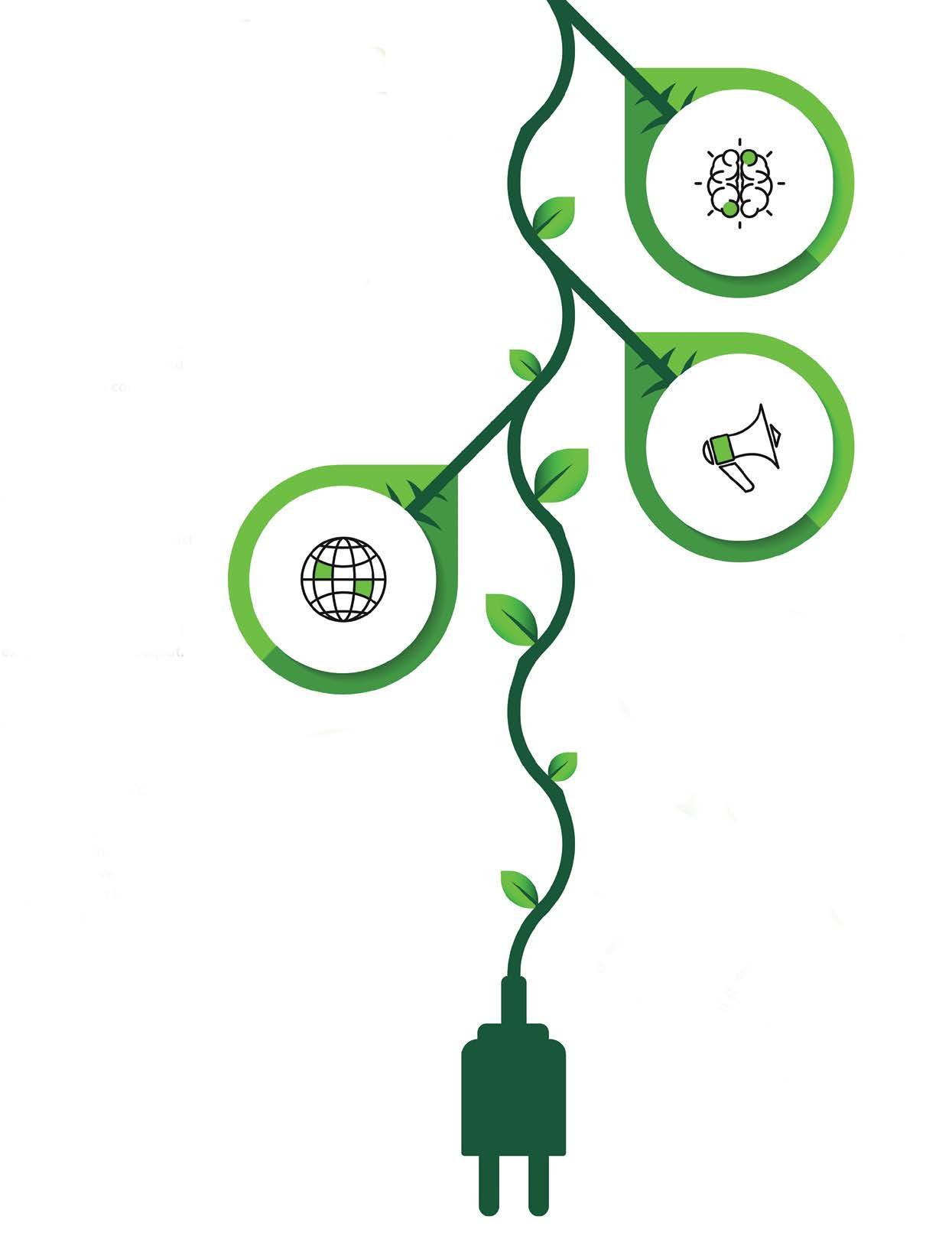
Also, important to note is that ISO 50001 promotes a culture of energy awareness and engagement throughout an organisation. By involving employees in these initiatives, they can tap into their knowledge, ideas and enthusiasm for energy-saving.

Companies should review their energy performance regularly
Swart adds that companies should review their energy performance regularly and always aim to set new objectives.
“By continuously striving for improvement, businesses can adapt to changing energy constraints, technologies and market conditions, reducing the stress associated with sudden energy-related challenges.”
Depending on the maturity and complexity of the organisation’s processes, implementation of ISO 50001 can take anywhere between six months and two years.
Effective leadership is crucial
“Leadership needs to be committed to reducing energy consumption throughout the organisation. To ensure that the energy management system is working in a coherent and consistent way, the organisation will need to establish and standardise how it carries out day-to-day operations as well as how it addresses irregularities and opportunities for improvement,” says Swart.
“This helps to reduce variation in energy consumption and bring the organisation closer to its objectives, ensuring sustainable long-lasting energy and cost benefits.”

ENERGY
78 sabusinessintegrator.co.za

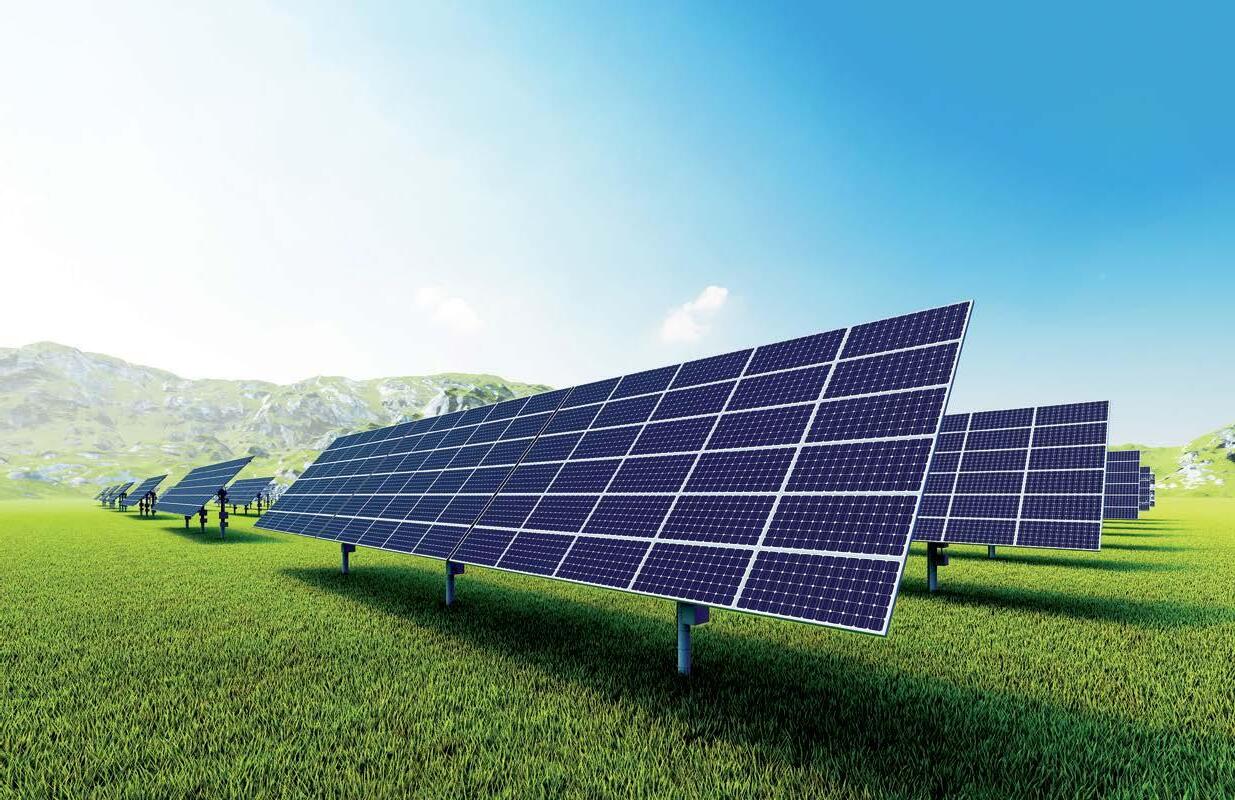





Rebuilding SA's
manufacturing sector
Over the years, South Africa's manufacturing sector has undergone a significant decline. The sector's contribution to the country's GDP has dropped from a peak of 24% in 1981 to just under 14% (13.7%) in 2022 (Stats SA).
The manufacturing sector’s contribution has not recovered since the global economic crisis of 2008 when its contribution to GDP was 16%. To date, the sector contributes 13%, on average.
"South Africa had an established diversified manufacturing base which grew from 1940 and showed resilience and potential to compete in the global economy,” says Thami Moatshe, Executive Head of the Localisation Support Fund (LSF).
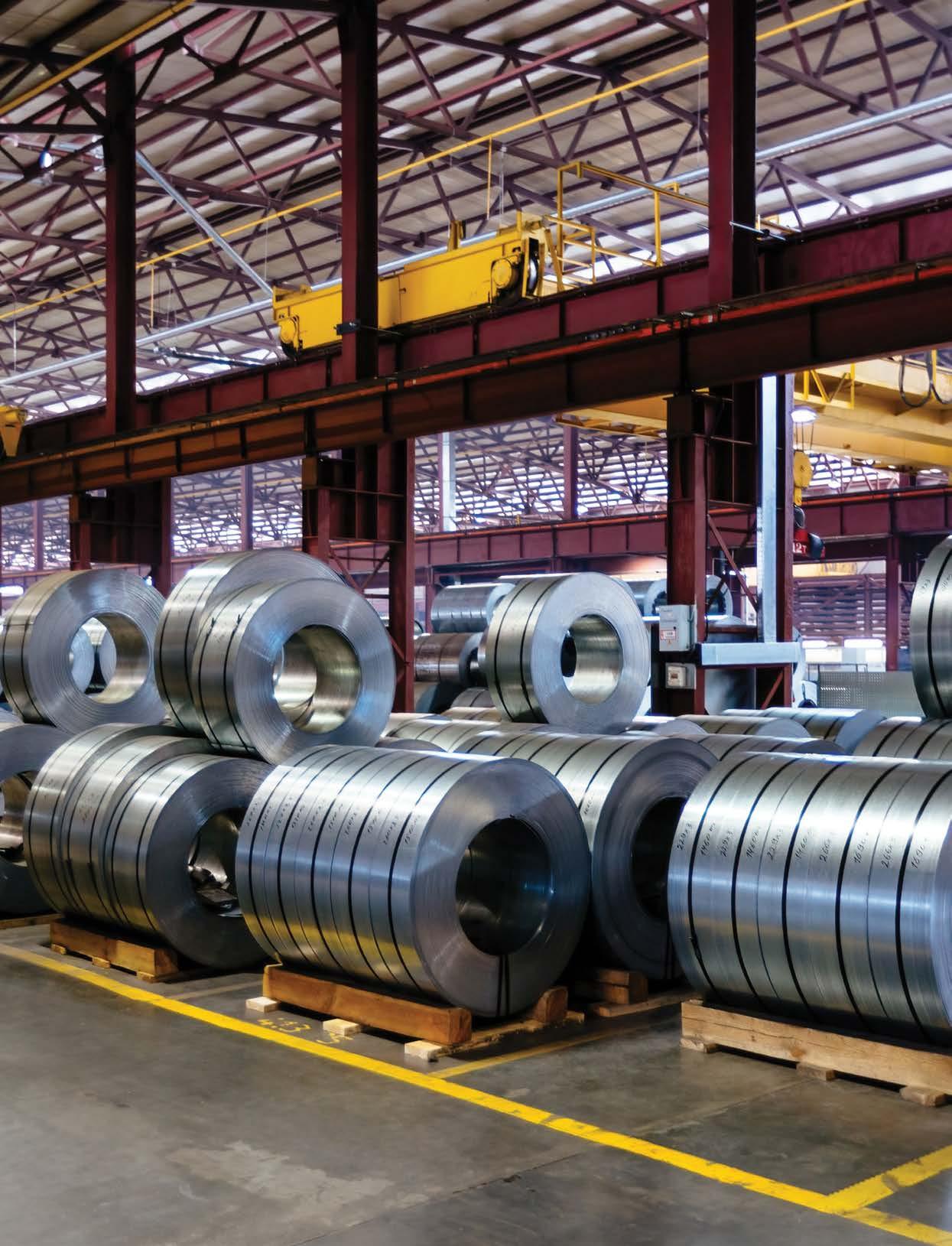
“Manufacturing has historically been the driver of economic growth and job creation. The continued decline in the sector’s contribution to GDP can be attributed to several factors over a period of time, ranging from cheap imports from global players – mainly China – to competition due to price, to quality and specialised skills challenges. The current energy crisis is further compounding the problem.”
South Africa's transition to democracy led to an open economy, which, in the absence of robust protective mechanisms for certain sectors, disadvantaged local manufacturing. This lack of protection, coupled with inherent scale-related challenges, made domestic production comparatively expensive and less competitive when compared to foreign manufacturers.
MANUFACTURING
82 sabusinessintegrator.co.za
Influx of substandard foreign products at lower costs undermines local manufacturers
“It’s not that South Africa doesn’t have the capability or capacity to manufacture certain products, local demand consistency remains a challenge and we need to buy local first from sectors and sub-sectors where we have the capability and capacity to boost economic activity and create much-needed jobs,” Moatshe says.
She argues that a significant influx of substandard foreign products, often at lower costs, continues to undermine and affect local manufacturers who have the capability and capacity to manufacture.
Promoting localisation
The LSF is a non-profit company that was established in 2021 by private sector contributors committed to the localisation of manufacturing in South Africa. It promotes localisation by partnering with participants in the ecosystem, on both the supply and demand side, to deliver on its mandate. LSF funds industry research and deploys technical expert resources in an effort to accelerate or unblock opportunities for growth in the manufacturing sector.
“We want to play a fundamental role by being a key enabler in promoting import substitution and growing exports to improve the manufacturing sector’s contribution to the GDP. The current energy crisis presents an opportunity to design and manufacture components that meet the demand emanating from the renewable energy programme
as well as the anticipated transmission and distribution capital investment programme,” says Moatshe.
“The challenge now is to provide local players and new entrants with the support they need to scale up and modernise production so that they can meet local demand and be globally competitive.
“In addition, we need a consistent demand from both the public and the private sector to ensure that local suppliers can adequately meet the demand. The partnership between the private sector, labour and government has seen success in the implementation of certain policies and masterplans such as the R-CTFL value chain and the Automotive Industry Masterplan to promote localisation. Expansion of these initiatives into other sectors such as medical devices, energy and furniture has the potential to increase local manufacturing’s contribution,” adds Moatshe.
Robust funding mechanisms needed to promote growth in the manufacturing sector
She adds that robust funding mechanisms are needed to promote growth in the manufacturing sector. The substantial CAPEX that will be spent on energy will help the manufacturing industry to increase capacity which in turn can stimulate more competitive pricing due to increased scale.
“While we may not compete with China in terms of scale, we have an opportunity to increase our manufacturing base. The impact of disrupted value chains during Covid was a clear indication that local manufacturing is needed,” Moatshe says.
“My view is that local buyers prefer to buy locally at competitive prices and at the right quality. South Africa should strive to become the best at what it can manufacture locally, while still being internationally competitive. We need to be able to clearly define where we want to play and how we intend to play.”
MANUFACTURING
83 sabusinessintegrator.co.za
... a significant influx of substandard foreign products, often at lower costs, continues to undermine and affect local manufacturers...
Work from home or back to the office?
Understanding the risks and benefits of a remote workforce before embarking on a hybrid or remote office solution can be make or break for staff productivity.

1.
Communication technology to facilitate real time communication amongst team members is key. Investigate which platforms and tools would work best for your organisation. Safe and secure document sharing, video conferencing and chat tools are essential to work in a remote or hybrid workspace.

2.
As a leader, you should encourage employees to set dedicated working hours and avoid working outside these boundaries too often. This allows employees to prioritise self-care and avoid burn-out.
Put an emphasis on taking regular lunch breaks. Encourage colleagues to take at least a two-week break once a year to switch off completely and shorter regular breaks inbetween.
For day-to-day challenges, consider organising online lunch or coffee sessions, motivational sessions or workshops.
3. Lack of engagement
Ensure employees stay motivated and productive while working from home by encouraging them to set tasks and milestones to track daily accomplishments and long-term goals.
Embrace activities that ignite passion and could fuel growth by incorporating gamification, introducing friendly competitions, rewards for targets and challenges with prizes to drive motivation. Recognise and celebrate achievements.
4.
A 2021 study by the Integrated Benefits Institute (IBI) noted that 40% of fully remote and 38% of hybrid work are associated with an increased likelihood of anxiety and depression symptoms compared to in-person work (35%). Leaders should prioritise the mental well-being of their employees who work remotely, considering making free professional support available to them. Scheduling team breakfasts, dinners and team building activities.
5. Time management
Time management is not only a challenge when working remotely, but remote work may make it trickier to manage a schedule. Encourage your team to plan by outlining priorities daily, focusing on time-sensitive tasks first and progressing to less urgent ones.
Time management techniques like time boxing, allocating specific time slots for each weekly and monthly tasks ensures deadlines are met.
6. Loneliness
Encouraging employees to maintain social connections while working remotely is important. Consider making a co-workspace available to employees for a change of environment and a more collaborative work experience.
7. Connectivity issues
Ensure employees are prepared with a backup plan for unforeseen technology problems and reliable resources to connect from home, including access to up-to-date software. For employees working in South Africa, a UPS is essential. Consider reimbursing internet costs to support your team in obtaining the fastest available internet connection.
Prepare for your transition to a remote or hybrid work environment with AIMS South Africa’s Work From Home Readiness Survey. If you already have a remote or hybrid workforce, our survey can help you understand the current challenges your team is facing.
+27 21 001 0070
www.aimsinternational.com/za
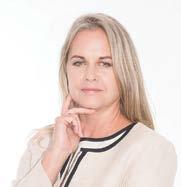

ADVERTORIAL: AIMS INTERNATIONAL
SEVEN OF THE MOST COMMON CHALLENGES WE HAVE COME ACROSS (WITH A FEW SUGGESTED SOLUTIONS):
Communication and collaboration
Burnout
Mental health
Arthur Nkuna Partner Leonie Pentz Managing Partner
84 sabusinessintegrator.co.za
Ashleigh Ball Consultant Teboho Kolane Marketing Assistant

The dos and don’ts of
ESG-linked executive rewards
The trend towards rewarding executives for their achievement of environmental, social and governance (ESG) goals is gaining momentum in the corporate world.
"South Africa is following suit with 93% of our Top 40 JSE-listed companies reporting they use ESG metrics for their shorter-term incentives (STIs) and 88% for their long-term incentives (LTIs)," says Martin Hopkins, executive committee member at the South African Reward Association (SARA).
This is according to a PwC publication titled Executive directors: Practices and remuneration trends report, August 2022.
ESG in South Africa
ESG is a framework for measuring the sustainability and responsibility of organisations in their quest for profit. While the movement is not officially regulated in South Africa, it is supported by existing regulations and standards, like the King IV governance code and institutional investor requirements.

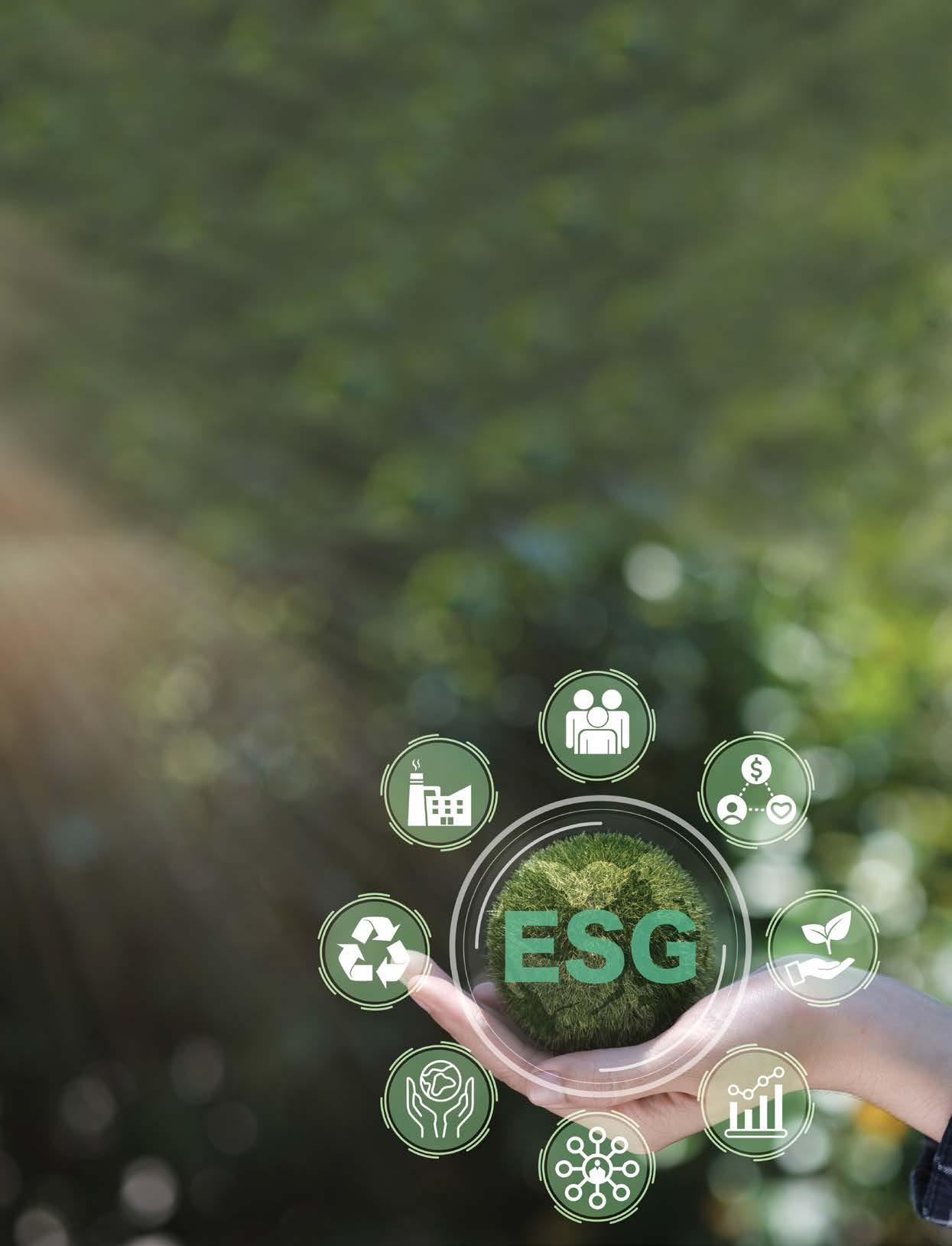
Corporate social responsibility has been around for decades, but ESG is getting an extra push from younger millennial shareholders, employees and other stakeholders who want to see real change in return for their investment and engagement with companies.
Most stakeholders currently want 15 to 20% of an executive's reward package to be contingent on ESG progress. According to PwC, although global ESG targets have a typical rating of 10 to 15%, South African companies trend closer to the upper 20% mark.
"Even so, if local businesses want to win future investment, the move towards formal ESG-based rewards, although not a legal requirement, is inevitable," says Hopkins.
EXECUTIVE REWARDS
86 sabusinessintegrator.co.za
Dos and don’ts Hopkins says there are several commitments organisations must make to ensure their ESG-linked reward structures are effective:
DO make metrics quantifiable. Vague, qualitative measures are neither reliable nor convincing to stakeholders. Rather, they value concrete targets, milestones, timelines and progression, and a logical methodology to link such variables to performance.
DO make metrics independently verifiable. Organisations should not only be able to articulate their ESG goals and rewards in real terms. They must also give assurance on their stated claims and chosen metrics through an independent body that is professionally qualified to validate both.
DON’T make it too easy. Relabelling normal business goals that would be achieved anyway as ESG initiatives and rewarding executives on their accomplishment is not a convincing strategy. Nor will it win the hearts and minds of stakeholders. Make ESG authentic and progressive, challenging the business to do better rather than building a facade.
The reward professional
DO ensure metrics are proximate to the business. Rewardable ESG targets and associated measures must be important and relevant to the type of business. Cherry picking generic ESG goals, like reducing carbon emissions, simply because they are popularised in the media or preferred by stakeholders is less appreciated than selecting a goal that is more closely related to the business of the company.
DO ensure metrics are credible. Any rewards attributable to ESG transformation goals and metrics must be reasonably balanced with suitably stretching targets for their achievement. Overly generous bonuses for success and, likewise, overly lenient penalties for underperformance are easily detected by stakeholders.
DO make ESG contribute economically. While it's good to reward executives for doing good, it's better when they are making money for their shareholders at the same time. ESG does not call on businesses to forego profits but to innovate around how to turn a profit responsibly, something which may also be woven into reward structures.
DON’T "greenwash" or "bluewash". Never fabricate ESG outcomes by making false or unverified claims around environmental (greenwashing) or social (bluewashing) aspects of a given initiative. And certainly, don't structure executive rewards around them.
Hopkins says South African reward professionals have an important role to play in ESG-based incentives.
"Although they are not ESG specialists, reward practitioners will need to become familiar with any chosen methodologies, provide support on their correct use, and develop reward packages that are consistent with their purpose," he says.
As ESG becomes a standard for corporate responsibility, reward professionals can help organisations demonstrate their commitment to it through well-aligned remuneration packages.
EXECUTIVE REWARDS
87 sabusinessintegrator.co.za
Sinayo – sustainable transformation and inclusivity
Sinayo’s mission and leadership is firmly rooted in the aspiration to foster a lasting South African legacy of sustainable transformation and inclusivity.
At the core of this mission lies our unwavering commitment to excellence through the nurturing of a thriving, innovative and collective business that provides our clients with exceptional and distinctive products, services, and tailor-made solutions.
We firmly believe that inclusion transcends political correctness; it is the cornerstone of growth and competitive advantage. Diversity and inclusion, the true catalysts for creativity and innovation, continue to occupy the central position in our ethos. Only through fully embracing diversity will we truly unlock the vast potential of this broad spectrum of talent.
The collective becomes greater than the individual
Through the synergies of varied ideas and perspectives, the collective becomes greater than the individual, and the individual becomes great. The team excels in this environment built on the commitment towards mutual respect, engagement and the spirit of camaraderie.
Sinayo group was built upon a solid foundation, merging the expertise of individuals with extensive experience and a strong entrepreneurial spirit, while also cultivating enduring and impactful client relationships.
Our distinguished team comprises accomplished professionals across multi skilled disciplines. The key to our success is the sharing of common purpose and drive to reach our goal as a team. We are proud of our “best in class” research analysts, investment professionals, stockbrokers, strategists and technologists.
This powerful combination of purpose and expertise, makes for a profound experience of thought leadership, producing market leading products and the delivery of “alpha” to our clients.
The need for innovation
At the heart of our strategy is the commitment to demonstrate the need for innovation. Innovation comes when you empower your team to push the boundaries in the pursuit of progress. Every challenge is pursued by a solution, enabled by innovation and entrepreneurial spirit.
We launched the Sinayo Project Funda in 2015, where we actively identify and nurture talent in research and leadership within the financial services sector. We believe in supporting all aspiring talent, and combined with our commitment to diversity and inclusivity Project Funda will be expanded in 2024 to include a programme for emerging South African artists and sports people.

Furthermore, our commitment to social responsibility shines through our support of 180 children at the Golden Ark Care Centre in Soweto. Through this initiative, Sinayo ensures that all young learners embark on their educational journey with full stomachs, primed for learning and making the most of each day ahead.

88 sabusinessintegrator.co.za ADVERTORIAL: SINAYO SECURITIES
Sinayo Securities (Pty) Ltd +27 11 783 6599 l info@sinayo.co.za www.sinayo.co.za
Our mission is to provide aesthetically enhancing, sustainable infrastructure planning, design and delivery solutions throughout the African continent and the rest of the Globe - through the use of international best practices coupled with our insight and understanding of local conditions. nicholasf@ovumcorporation.com




Ovum About Ovum Corporation Contact Us (+27) 81 787 2633 Ovum Corporation stands for innovation and the giving of life to new ideas for projects that uplift mankind. Founded in June 2020. We are a civil engineering consultancy based out of South Africa that specialises in the structural and hydraulic design of all aspects of modern infrastructure. Commercial Buildings Industrial Plants, Process & Storage Facilities Mining Telecommunication Towers Bridges & Culverts Green Star Ratings for New Building Construction Ovum Services Corporation Bringing Fertile Engineering Ideas to Life ovumcorporation.com
(+27) 81 787 2633
Financial freedom starts with real-time data
Your financial standing and reputation – based on the conduct of your payment history for the accounts and/or debts you hold –often feels like a state secret, right? As if access to that information should require authorisation by stupefying levels of security.
But why when it’s your information – right?
Splendi makes getting, managing, and understanding that information quite simply –splendid!

And the best part? It’s FREE!
ALL ACCESS
No matter what you earn, financial freedom is based on your credit reputation. The source of that knowledge is Splendi, where you have free access to the most up-to-date credit information – anytime you choose.
This cutting-edge South African innovation uses real-time data to give you a simplified overview of where you stand with whatever accounts and/or loans you have – in one place.
REAL-TIME DASHBOARD Get:
• Your up-to-date credit score every time you login
• Alerts when your personal information is linked to any new accounts or those in arrears
• A detailed, 2-year history of your financial activities and how that has affected your credit score
• Advice, insights, and resources to keep you on top of your financial well-being with the right information
www.splendi.co.za
It’s straightforward. It’s simplified. It’s Splendi. Sign-up and turn wondering into knowing – for free!
 ADVERTORIAL: SPLENDI
ADVERTORIAL: SPLENDI
90 sabusinessintegrator.co.za






Visit splendi.co.za and turn wondering into knowing – for free! FINANCIAL FREEDOM STARTS WITH REAL-TIME DATA. YOURS STARTS WITH SPLENDI.
SMEs: accelerate your business
In the fast-changing world of entrepreneurship, small businesses often hit roadblocks that slow down their growth and success.


From tight budgets and limited expertise to encountering barriers in accessing lucrative market opportunities; the struggle for small business owners is real. But there’s a game-changer for those who want to supercharge their growth and have access to untapped opportunities. It is called: Business Accelerators.
Kyle Ballard, Head of Accelerators for the Durban Chemicals Cluster (DCC), a seasoned expert in the field and leader of several Accelerator initiatives, highlights five compelling reasons why SMEs should seriously consider joining a Business Accelerator:
1 Access to established and enthusiastic customer base
Securing a strong customer base is often a challenge for SMEs. Joining a Business Accelerator opens doors to established networks of potential customers and partners.
"Accelerators, like the DCC Accelerator, provide SMEs with direct access to senior decision-makers and industry stakeholders," says Ballard.
This direct engagement significantly enhances the possibility of forming strategic partnerships and securing mutually beneficial commercial opportunities with large customers who are actively looking for new, local suppliers that might otherwise be difficult to access.
2 Expert mentorship and tailored guidance
Navigating the complexities of business growth can be daunting. Business Accelerators connect SMEs with seasoned industry mentors who offer expert guidance and support.

"Our mentors work closely with selected SMEs to align their products or services with customer demands and to streamline operations for efficient and sustainable growth," Ballard explains.
This mentorship ensures that SMEs receive tailored advice that is instrumental in their development journey and enables better delivery to customers.
SMALL BUSINESS
92 sabusinessintegrator.co.za
3 Exposure to capital and investment opportunities

Access to funding is a common barrier to SMEs’ growth. Business Accelerators often facilitate introductions to potential investors, both from the public and private sectors. Additionally, some Accelerator programmes, like the DCC Accelerator, offer the chance to compete for cash prizes.
"SMEs need capital to fuel their growth, and Accelerators can connect SMEs to various capital investment interventions and funding opportunities," Ballard notes.
4Integration into a vibrant community
Business Accelerators cultivate a vibrant ecosystem where SMEs can interact, learn from one another, and collaborate on innovative projects.
"Joining an Accelerator means becoming part of a community that shares experiences, resources, and opportunities," Ballard highlights. This collaborative environment accelerates learning and propels growth through collective knowledge and support.
Play a pivotal role in driving economic growth

5 Industry expertise and sectoraligned empowerment
One of the most significant advantages of Business Accelerators is the chance to connect with industry leaders and established stakeholders.
"Accelerators provide SMEs with the opportunity to learn from the best and gain exposure to industry giants," states Ballard. “This exposure not only offers valuable insights but can also lead to strategic collaborations that can propel them to new heights.”
The primary focus of the DCC Accelerator lies within the local chemicals manufacturing industry and has an exceptional record of value addition within this particular domain. "Our specialisation speaks to the strategic advantage of aligning SMEs with an Accelerator specific to their company’s niche to optimise their potential and unlock targeted growth," emphasises Ballard.
Takalani Rathiyaya, who heads the Economic Development Programmes Department at eThekwini Municipality, believes that Business Accelerators play a pivotal role in driving economic growth by empowering SMEs and fostering mutually beneficial commercial opportunities between diverse industry stakeholders.
"We hold a deep commitment to Accelerators such as the DCC Accelerator, as we have directly observed its transformative impact. It is this very impact that drives us to continue to actively uphold our support for these initiatives, with a specific focus on empowering Black industrialists and catalysing economic transformation within the local chemicals sector," says Rathiyaya.
“Whether through the DCC Accelerator or similar initiatives, SMEs should leverage Accelerators if they are serious about taking their growth trajectory to the next level,” Ballard concludes.

SMALL BUSINESS
93 sabusinessintegrator.co.za
Invest in SA:
Risks, mitigation & mechanisms
All investors whether they be Development Finance Institutions, multinationals, banks, and investment funds take jurisdictional investment risks into account before exploring the investments themselves.
By Alexandra Burger, Managing Director at Lyra Consulting
There are a number of key risk attributes to consider in relation to a specific country to decide whether the country is “investable” and there is a fair amount of competition between countries for international investment. Certain industries will also be more attractive at any time for example presently commodity prices are higher, so people are interested in commodity investments. During Covid the South African agricultural sector showed great returns but is generally considered highly risky.
The main risk factors
Political risk
No matter what people say, the primary issue is always political risk and it can present both opportunities as well as challenges for investors. In particular, political stability is a key factor in ensuring a conducive business environment.
All investors should closely monitor political developments including changes in government policies and regulatory and legal changes. Social unrest became a high-risk factor after the riots in KwaZulu Natal and South Africa is by no means the only country to have social unrest issues.
To manage political risk, it is recommended to engage with local stakeholders, industry associations, and government bodies to provide up-to-date insights and help assist mitigate political risks.
Economic risk
The South African economy virtually ground to a halt during Covid and unfortunately, the economy faces various risks including slow economic growth, very high unemployment rates possibly the highest in the world, and inflation rates (although there are indications that this may be stabilising).
Investors have to evaluate the economic climate and assess the factors such as GDP growth, fiscal policies, interest rates and inflation rates. Many investors use diversification strategies across sectors to mitigate economic risks.

INVESTMENTS
94 sabusinessintegrator.co.za
Grey listing
South Africa’s grey listing by the Financial Action Task Force (FATF) will result in increased scrutiny, due diligence, stringent regulations, and increased compliance and associated costs. Investor confidence has been affected, which could result in a decrease in foreign direct investments and cash flows. It is imperative that money laundering concerns are effectively addressed at all levels.
Power outage risk
The risk of power outages and potentially even grid collapse is a significant concern for South African businesses and all investors. These outages have varying impacts on different sectors of the economy.
Whether an investor is looking at investing in a retail business, a manufacturing business, or even a financial services business, it is essential to make provision for the energy crisis and consider its impact on the bottom line.
Foreign exchange risk
The foreign exchange rates are highly fluctuating and presently there is a downward trend in ZAR against all major currencies. Weak exchange rates favour exporting businesses.
Most international businesses develop strategies to manage currency risks including hedging strategies, diversifying revenue streams, and managing balanced currency exposures.

Market risk
The general trend in Africa was to see growth in the middle class and in buying power however, this is no longer as certain. Investors have to do market research to identify specific target segments, preferences, and potential barriers to entry. Competitive Pricing in particular is essential in South Africa along with effective supply chain and logistics.
Crime
SA’s crime rates have been well-publicised internationally and pose a significant challenge to South Africans and foreign investors. Corruption in particular is currently one of the biggest bugbears of all investors and that is why many now have specific policies identifying issues such as corruption, collusion, anti-bribery, and conflicts of interest.
It is thus essential to assess the security situation in the specific sector and place of business and implement robust security measures in order to protect assets, employees, and operations. Presently South African business is trying to work together with the government to tackle the barrage of crime. It is recommended that investors engage security experts to provide guidance on risk mitigation strategies and consider insurance options and costs.
Taxation risk
Corporate and personal tax rates are high which constitute a significant tax risk. It’s important to consider withholding taxes on dividends, interest and royalties but fortunately SA has a large double taxation network. Exchange control is also a noteworthy challenge for foreign investors.
INVESTMENTS
95 sabusinessintegrator.co.za
Mechanisms for investing in South Africa
1. Direct investment
This requires establishing a physical presence in the country by setting up subsidiaries, branches, or joint ventures with local companies. This route provides more control over operations and allows for direct engagement with the local market.
Joint ventures are quite common especially to ensure that companies have the correct empowerment status. Note joint ventures are complex constructs requiring significant legal agreements, structures, and operations.
Certain industries do have more regulation e.g. financial services, medical, and the relevant licenses /authorisations need to be acquired before one can operate.
The structuring of the investment vehicle is essential to manage tax regulations, especially dividends, interest, and royalties. Robust labour laws can be challenging for some investors and it’s best to obtain local advice on how to manage recruitment and ongoing operations correctly.
2. Portfolio investments
Where investors do not wish to have direct operational involvement they can invest by buying shares in publicly listed companies, mutual funds, or alternatively private equity funds which may be more general or have a specific industry target.
3. Public-private partnerships (PPPs)
4. Greenfield investments
As the name implies greenfield investments involve building from scratch a new operation such as a factory, facility, or even a mining operation. There is significant interest in the mining of rare earth metals in South Africa presently.
5. Mergers and acquisitions
Many multinational corporations consider M&A as a way to enter the South African market or to expand their existing operations. SA companies have been targeted by international companies such as MNCs and funds for investment and expansion.
Acquiring or merging with existing companies allows for quick market entry and access to established customer bases, distribution networks, and local expertise. M&A activities are also heavily legally focused and will involve thorough due diligence, structuring opportunities, legal considerations, valuations, etc.
6. First loss
Development finance institutions perform a valuable function when they use the concept of first loss to reduce risk in their investment portfolios. The DFI takes the first portion of any potential loss incurred in an investment, thereby cushioning the other investors’ risk.
South Africans are problem solvers
PPPs involve collaboration between the government and private sector to set up and operate projects including infrastructure, construction, transportation, energy, or telecommunications. The process is complex and highly regulated. To participate requires bidding for contracts through tender process and forming a joint venture with local partners to provide the necessary skills and B-BBEE credentials. With the current power crisis, there are significant investments being made into the renewable energy projects. The PPP mechanism is designed as a shared risk model and may also provide long-term investment opportunities.
While we live in challenging times it’s important to remember that this country has produced some world-class inventions, companies, and technological skills. South Africans are problem solvers whose solutions transport very well to other economies both in emerging markets and developed markets.
www.lyra-consulting.co.za
96 sabusinessintegrator.co.za
INVESTMENTS

Overregulation
feeding deficit of affordable housing
Overregulation of the housing market in South Africa is discouraging the private sector from investing in formal low-cost housing projects, according to Renier Kriek, Managing Director at Sentinel Homes.
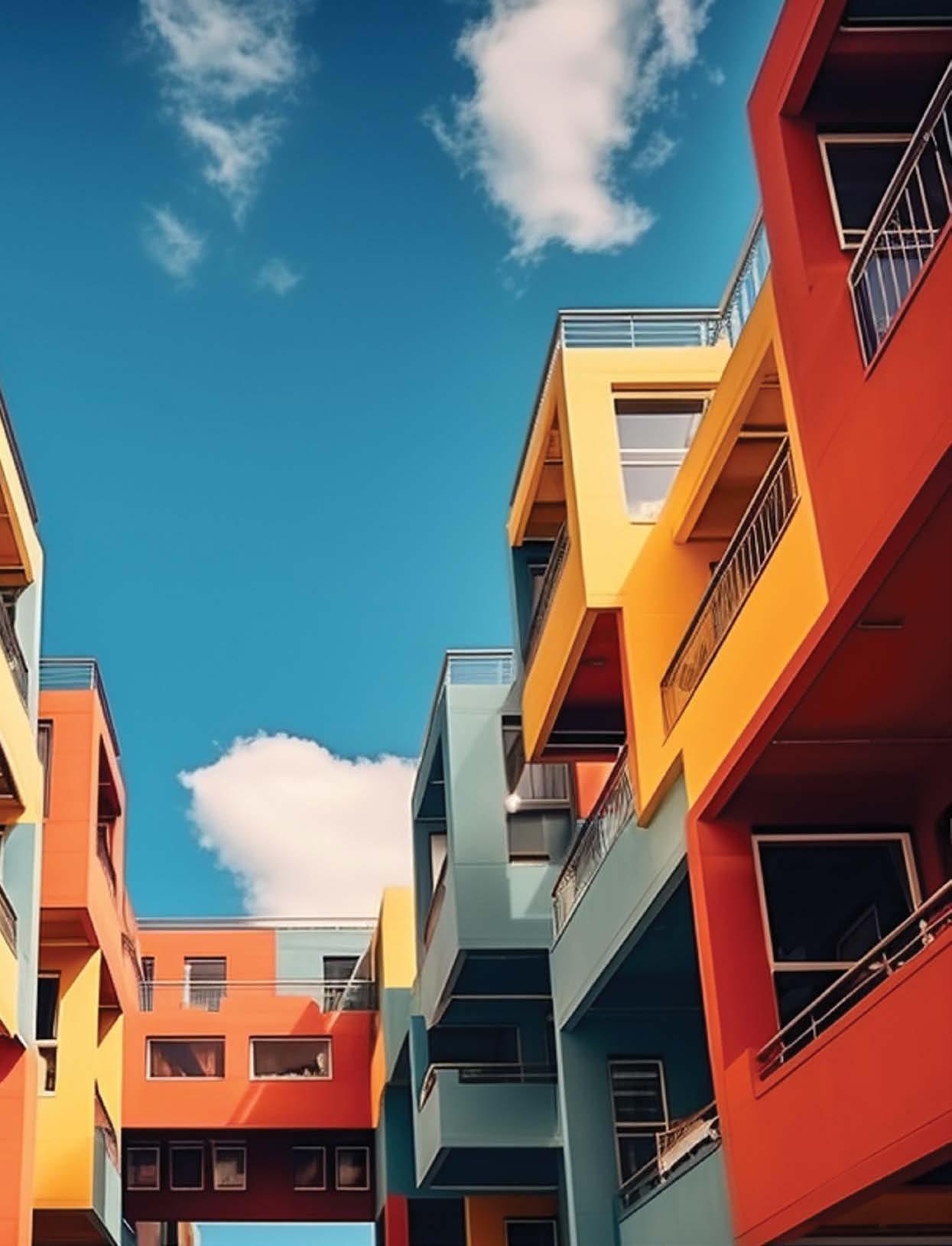
98 sabusinessintegrator.co.za HOUSING
"With government resources being limited and corruption widespread, it is imperative that private capital is enticed to join the constitutional project of granting all South Africans access to adequate housing," he says.
It is apparent that, for all the government's initiatives, programmes and subsidies to provide RDP housing, a vast number of underprivileged citizens still reside in informal settlements.
However, while tax breaks exist for new or improved rental housing, with added incentives for low-cost housing, the rest of the legal and policy landscape is much less persuasive to investors.
Mortgage risk
For one, housing consumers who earn less than R15 000 per month make up less than 0.6% in value and 1.7% in the number of accounts granted mortgages in Q1 2023, matching a decade-long trend. This is because banks tend to avoid these riskier applicants, even when supported by the government's Finance-Linked Subsidy Programme (FLISP).
The reason is simple: the excessively long and inefficient foreclosure process in South Africa seems bent on ensuring losses for both banks and defaulting consumers.
In addition, judges are often overly sympathetic to defaulting debtors per case, not considering the overall negative effect this has on banks' attitude towards financing the larger underprivileged community.
"However, if the cost of terminating defaulting mortgages were low, banks would be less risk averse, thereby increasing the likelihood of access by this segment," says Kriek.
Rental risk
Similar to mortgages, the time and financial costs of eviction are too high, and the law and courts are
too lenient on defaulting renters.
With the supply of formal housing being so low, the cost of eviction should also be low and the rights of a large number of potential tenants should weigh more heavily than those of a few non-paying tenants.
"If the risk was low, more landlords would emerge to invest in satisfying the obvious demand for affordable accommodation," says Kriek.
Development rules
Lastly, housing development in South Africa is inhibited by long or delayed regulatory processes, as well as building standards designed around first-world circumstances. This is further exacerbated by municipal inefficiency, which affects the delivery of essential services like roads, water, power and sanitation.
Authorities have also suddenly become deeply concerned with the lack of affordable housing. Their response has been to request that developers include affordable housing units in new developments, even in areas not marked for such housing.
"While laudable at first glance, this does not increase the availability of affordable housing as beneficiaries will often flip the unit at market price to realise a profit," says Kriek.
The positive intent is therefore negated and leaves the market worse off.
Change is needed
Mortgage risk, rental risk and misguided development rules, taken together, disincentivise the development of low-cost housing in favour of larger, pricier units.
"Given the state of the country’s housing market, urgent legal reforms and businessfriendly policies are needed to ensure all South Africans gain access to constitutionally mandated housing," says Kriek.
99 sabusinessintegrator.co.za HOUSING
SMEs can survive construction spike
Skyrocketing construction and operational costs in South Africa are making it incredibly difficult for small and medium-sized construction businesses to survive, let alone thrive.
By Roelof van den Berg, CEO at Gap Infrastructure Corporation
Notably, the Construction Materials Price Indices report released by Statistics South Africa reveals that total construction material costs had risen by 9.1% year-on-year in February – well above inflation. This can be attributed to noteworthy increases in the costs of concrete, metal roofing, electrical reticulation, and other important construction components.

Combined with the financial impacts of loadshedding, these rising costs are placing
extreme pressure on small and medium-sized enterprises (SMEs) in the sector, with a significant knock-on effect on the country’s economic growth.
For SMEs, the rising costs of material, alongside the already high costs of labour and power, make it exceptionally challenging to remain competitive and profitable, and risks seeing a decline in the number of businesses operating in this sector.
However, diligent cost management and publicprivate partnerships (PPPs) can play a crucial role in helping SMEs cope with these high prices while attaining the South African government’s lofty infrastructure goals in 2023.
THOUGHT LEADERSHIP
100 sabusinessintegrator.co.za
Combatting rising prices by lowering other input costs
There are a few simple ways companies can combat high prices and reduce costs, such as implementing efficient procurement processes. For example, to reduce material costs, SMEs can seek to negotiate better deals with suppliers or consider bulk-buying materials.
Likewise, leveraging the power of technology, such as project management software and Building Information Modelling (BIM) systems, can help SMEs to better manage their resources and reduce expensive surveyance costs.
Modularisation can also help to reduce construction costs. Constructing components off-site and assembling them on-site where possible can minimise waste and time spent on-site while improving safety standards, as more of the construction work is completed in a controlled environment.
The public sector’s role in strengthening SMEs
Another way to help SMEs improve their efficiency and resiliency against rising construction costs and other issues is by leveraging the immense power of publicprivate partnerships (PPPs). The relationship between government and the private sector is critical for infrastructure development, as highlighted by Public Works and Infrastructure Minister, Sihle Zikalala.
Speaking at an investment conference, Zikalala emphasised the importance of PPPs.
“We are in discussion with the National Treasury with regard to the issue of private sector accessing funding,” he said. “We need to explore other avenues with the private sector in as far as financing is concerned.”
1. Government tenders
Streamlining and simplifying the application process for government tenders for infrastructure development projects would be a good start. Currently, the process is relatively complex and new entrants –especially small construction businesses – do not yet possess the skills and knowledge to successfully apply for a tender. Simplifying the process could help more SMEs gain access to lucrative state contracts.
2. Payment processes
Additionally, government needs to improve and speed up its payment processes.
It often takes multiple months for government to pay contractors for services rendered. Larger companies have the financial resources to wait out this period, but for SMEs, being forced to wait this long to pay their debtors and employees could be detrimental.
3.
Tap into the knowledge and expertise of private sector partners
SMEs can benefit from PPPs in other ways too. For instance, they can tap into the knowledge and expertise of their private sector partners, which can help them improve their operations and productivity.
4. Give smaller companies the opportunity to take on larger projects
Additionally, PPPs can create more jobs in the SME sector by giving smaller companies the opportunity to take on larger projects and assisting them in building and training their workforce.
PPPs are critical to the stability and ongoing success of South Africa’s SME market, with a unique opportunity to help them access additional funding and new business – a critical role in challenging times for the industry.
THOUGHT LEADERSHIP
101 sabusinessintegrator.co.za


Profit or loss:
the top 3 mistakes
Online trading platforms have made it possible for even the most novice traders to transact in their own time and on their own terms. Trading in financial instruments such as bonds, cryptocurrency, stock indices and forex has never been simpler or more convenient. But, while opportunities to realise lucrative returns flourish, there are several pitfalls that traders need to avoid in order to achieve long-term success.

Commenting on what some of the most common stumbling blocks are, Kamogelo Mosime, Partnership Manager at Tickmill explains: “Even with access to real-time financial data, market research and statistical information, traders can make costly mistakes – most of which come down to basic human error or misjudgment.
“Fortunately, with the maturity of many of the current markets and the growing volume of traders with various levels of experience, we have a golden opportunity to identify these routine
snags and learn valuable lessons on how to guard against them.”
1Focus on facts, not feelings
Mosime cautions traders against emotional trading. Inexperienced traders often fall prey to their own emotions – particularly fear and greed. One of the most valuable skills in online trading, therefore, is emotional discipline and being able to resist the urge to make impulsive decisions.
“Psychological and cognitive errors can influence
TRADING
104 sabusinessintegrator.co.za
your decision-making – often for the worse. The first step in avoiding these kinds of mistakes is to be aware that as emotional creatures, our own biases, feelings and opinions can get in the way of clear, rational thinking.
The best way of counteracting this is to formulate a trading plan and remain resolute in sticking to it, regardless of the behaviour of the market. Trading is a ‘mind’ game rather than a ‘heart’ one.
“Over time, making data-based decisions that are informed by facts rather than feelings, will allow traders to grow in confidence and see the tangible fruits of trusting their plan and keeping their eyes firmly fixed on the desired outcomes,” says Mosime.
Research first, act second
This perspective provides a segue into discussing another common blunder, which involves making decisions without having conducted proper research. When traders make decisions based on what they believe to be ‘inside information’ or predictions based solely on their instincts, they run the risk of suffering substantial losses when factors beyond their control come into play.
Before initiating a trade, it is, therefore, crucial to understand the market dynamics, analyse trends, and evaluate the potential risks involved. Several analytical tools can prove indispensable in this regard. These include timelines of each instrument’s financial performance over a few years, graphical representations of how the market has fluctuated and expert analyses.
Mosime asserts: “One of the greatest assets that any trader can have at their disposal is the willingness to embrace ongoing learning and immerse themselves in the technicalities of the markets in which they would like to operate. If your online platform offers resources that can enable learning, you should use this to your
advantage and familiarise yourself with how different datasets are interpreted. When it comes to the world of online trading, you can never get enough data.”
With the view that traders need to be equipped with the most reliable data to inform their strategies, Tickmill offers an Advanced Trading Toolkit. Via the toolkit, traders can do a deep dive into various options, looking at aspects such as sentiment, which tracks how the market feels about a certain listed entity or instrument.
Mosime encourages traders to use tools such as these to analyse the market from different angles in order to get the fullest view of its potential.
Keep an eye on the risks while striving for the rewards
Furthermore, in indulging in impulsivity, traders can become overly focused on the ‘reward’ dimension of investing and not as focused on the ‘risk’ factors involved. For example, many traders overlook setting stop-loss orders or fail to define an acceptable risk-reward ratio for their trades.
Without proper risk management, losses can quickly escalate, leading to significant financial setbacks. Traders should establish clear risk parameters, determine appropriate position sizes, and consistently adhere to their risk management strategies.
“At its most fundamental level, successful online trading relies on the ability constantly weigh up these aspects and make calculated decisions based on the interplay between risk appetite and expectations of reward.
“Doing so skillfully involves striking a delicate balance. But with strategies like using a trading plan, setting goals realistically and keeping a trade journal, traders can maximise their potential earnings and walk away satisfied that they have made the best decisions within the parameters they have set for themselves,” Mosime concludes.
TRADING
2 3 105 sabusinessintegrator.co.za
Crypto providers
caught in the licensing net
Around the world, governments are moving ahead to regulate crypto assets. The South African Reserve Bank (SARB) at first merely warned the public about the volatility of the crypto asset market, but South African regulators have now defined crypto as a financial asset under the Financial Advisory and Intermediary Services (FAIS) Act. The Financial Intelligence Centre Act (FICA) also applies.

 By Lerato Lamola-Oguntoye, Consultant & Analisa Ndebele, Associate, Webber Wentzel
By Lerato Lamola-Oguntoye, Consultant & Analisa Ndebele, Associate, Webber Wentzel
106 sabusinessintegrator.co.za CRYPTO
The FAIS Act, and in some respects other pieces of financial services legislation, were not built for the digital environment, so they are not a clean fit. It is a learning process, which will eventually result in more comprehensive regulation under the Conduct of Financial Institutions Act, currently in still a bill.
FAIS requirements
The FAIS Act requires individuals providing a financial service to hold a financial services provider (FSP) licence, and crypto asset service providers (CASPs) are also under this obligation.
The FAIS Act defines a crypto asset as a digital representation of value that is not issued by a central bank, but can be traded, transferred or stored for utility, applies cryptographic techniques, and uses distributed ledger technology (blockchain). This definition is intentionally wide and technology neutral. The term is “crypto assets”, not “cryptocurrency”, because crypto assets are not legal tender in South Africa.
Financial services include providing advice in relation to financial products, i.e., investment advice, and an intermediary financial service, which is defined quite widely. A person who assists other individuals to buy, sell, manage, administer or service a crypto asset is providing a financial service and must hold an FSP licence. An individual trading crypto for their own account would not be an FSP.
Guidance from the regulator of the FAIS Act, the Financial Services Conduct Authority (FSCA), is that certain activity is not covered by the declaration of crypto assets as a financial product. Although certain activity would qualify under this definition, the FSCA does not at this stage require players to apply for a licence. They are:
• Miners and node operators, who support what happens on the blockchain, but are not facing the consumer.
• Those providing services in relation to nonfungible tokens (NFTs). NFTs are unique, based on the code that creates them. Although NFTs can be traded, the regulator considers they present a lesser risk than fungible tokens. Some people have argued that NFTs are the same as crypto assets, so in the next iteration of the FAIS Act, they may be required to have a licence.
• Those providing financial services in relation to crypto asset derivatives, which are defined as securities under the Financial Markets Act (FMA). These players should already be licensed under FAIS or be complying with the FMA.
There is a prescribed application process for an FSP licence. The applicant has to show that they meet the fit and proper requirements, which relate to, amongst other things, competence, good standing, operational ability, and financial soundness. They should nominate a key individual and where applicable representatives. The quantum of the application fee payable at the time the application is submitted depends on how many key individuals and representatives are nominated and the category of FSP licence.
We are currently in an exemption period under the FAIS Act. CASPs who are currently providing financial services in relation to crypto assets are exempt from the FAIS Act, as long as they apply during the application period of 1 June to 30 November 2023. This exemption continues until there is a formal response to their application (granted or not).
CRYPTO
107 sabusinessintegrator.co.za
A person who assists other individuals to buy, sell, manage, administer or service a crypto asset is providing a financial service and must hold an FSP licence.
CRYPTO FICA and FAIS together
Schedule 1 of FICA defines CASPS as accountable institutions, which means they have to register with the FIC and fulfil ongoing compliance obligations. The FICA definitions of entities that qualify as accountable institutions are similar, but not identical, to those in FAIS. CASPs should consider carefully whether they are performing any of the services listed under item 22 of Schedule 1.
FICA does not have transitional provisions – from 19 December 2022 the requirement on CASPs to register as accountable institutions commenced, qualifying entities must register as accountable institutions. The FSCA is not the regulator for FICA, but when an application for an FSP licence is submitted, the FSCA is empowered to ask if the applicant is registered as an accountable institution.
We would advise individuals and entities to assess firstly whether it is necessary to register under FICA, and then whether it is necessary to register as an FSP under FAIS. Now is the time to do this analysis and ask these questions.
If an entity should register, but does not, they are liable to incur penalties. Under FAIS, it is an offence not to register, which may attract a penalty of a fine
of up to ZAR10 million and possible imprisonment up to 10 years. Under FICA, not registering is an act of non-compliance, not an offence, which could incur administrative sanctions, e.g., a caution or reprimand and a fine of up to ZAR10 million. For the first 18 months from 19 December 2022, the FIC will not issue monetary fines for a failure to register, but other administrative sanctions could apply.
Exchange control
Individuals may use their single discretionary allowance and their foreign capital allowance to purchase crypto assets from abroad. A local Authorised Dealer will be able to assist individuals with these allowances. However, there are some blanks in exchange control regulation when it comes to repatriating the proceeds from a sale of crypto assets to South Africa. We expect this will be addressed in the near future.
If individuals or entities involved in the crypto sector have questions about regulation, they may approach the regulator for advice. They can also approach Webber Wentzel if they require assistance engaging with the regulators and we can sound out the regulator on a “no-name basis” on their behalf.

108 sabusinessintegrator.co.za

Legal implications
for emerging technologies
Emerging technologies, such as artificial intelligence (AI), virtual reality (VR), and the Internet of Things (IoT), are transforming industries and reshaping society. As these technologies advance at an unprecedented pace, examining the legal implications and challenges they present is essential.
 By Celesté Snyders, SchoemanLaw Inc
By Celesté Snyders, SchoemanLaw Inc
This article explores the legal perspective on emerging technologies, highlighting the key considerations, regulatory frameworks, and ethical concerns surrounding their adoption.
Regulatory challenges and frameworks
The rapid development of emerging technologies often outpaces the ability of existing laws and regulations to govern them effectively. Legislators and legal experts face balancing fostering innovation and protecting public interests, including privacy, security, and ethical considerations. As a result, new regulations and frameworks are being developed worldwide to address the legal challenges posed by emerging technologies.
Privacy and data protection: The collection and use of massive amounts of personal data by emerging technologies raise significant privacy concerns. Regulations such as the Protection of Personal Information (POPIA), a South African data protection law that aims to safeguard individuals' personal information, promote the responsible handling of personal data by organisations, and empower individuals with greater control over their personal information.
Intellectual Property: Emerging technologies often involve novel inventions and creations, necessitating intellectual property protection. Patent laws, copyright laws, and trade secret regulations play a crucial role in fostering innovation and providing legal safeguards for intellectual property rights.
Liability and accountability: The autonomous nature of some emerging technologies, such as AI-powered systems, raises questions of liability and accountability in case of errors or harm. Establishing legal frameworks that define responsibility and allocate liability among stakeholders is essential for ensuring fairness and mitigating risks.
Cybersecurity and data breaches: With the increasing reliance on interconnected systems, emerging technologies introduce new cybersecurity risks. Laws and regulations addressing data breaches, cybersecurity standards, and incident response protocols are vital in safeguarding against malicious activities and protecting sensitive information.
EMERGING TECHNOLOGY
110 sabusinessintegrator.co.za
Ethical considerations
Alongside legal challenges, emerging technologies bring forth ethical considerations that demand careful examination. Ethical guidelines and frameworks are essential to ensure these technologies' responsible development and deployment. Some of the critical ethical concerns include:
Bias and fairness: Emerging technologies, particularly AI systems, can perpetuate biases and discrimination in the underlying data or algorithms. Developing ethical guidelines that promote fairness, inclusivity, and accountability is crucial to prevent the amplification of societal prejudices.
Transparency and explainability: As AI systems become increasingly complex, ensuring transparency and explain ability become vital. Ethical frameworks should encourage developers and organisations to adopt measures that allow for a clear understanding of how these technologies operate and make decisions.
Human dignity and autonomy:
Technologies like VR and IoT may impact human dignity and autonomy, raising ethical questions regarding consent, surveillance, and preserving individual rights. Legal frameworks should address these concerns to balance innovation and human rights.
Collaboration and future outlook
Addressing emerging technologies' legal and ethical challenges requires collaboration between policymakers, technology developers, legal professionals, and other stakeholders. Multidisciplinary approaches that combine legal expertise, technological knowledge, and ethical considerations are essential to creating comprehensive regulatory frameworks.
Going forward, the legal landscape will continue to evolve to keep pace with the rapid advancement of emerging technologies. Governments and international bodies will likely focus on fostering innovation while implementing regulations that protect individuals' rights, ensure accountability, and mitigate potential risks.

Continuous dialogue and collaboration among all stakeholders will play a pivotal role in shaping a legal framework that encourages responsible and ethical development and deployment of emerging technologies.
Emerging technologies hold immense potential to transform industries and improve society but also present complex legal and ethical challenges.

EMERGING TECHNOLOGY
111 sabusinessintegrator.co.za
BIZNIZ IN A BOX
What is Bizniz in a Box (BiB)?
BiB launched in 2025 to help transform aspirant entrepreneurs, including women and youth, into fully-fledged business owners who can create a livelihood for themselves and others.
Why BiB?
It supports SMMES with upskilling through infrastructure support, working capital investments, tools and training.






The impact of BiB?
BiB has financially supported and provided training to over 700 entrepreneurs across the country. CCBSA has rolled out around 758 containers, 400 being youth.
Did you know?
In 2022, Fourteen young South Africans SMMEs won a fully equipped BiB mobile kitchen or container all worth R1,316,000 during a Youth month competition across South Africa.












BiB beneficiaries must have skills such as basic financial management, bookkeeping, marketing and preparing a business plan. APPLY
Business owners can apply on our website https://www.ccbsaco.com, call us on 011 848 2600 or email CCBSAYEP@ccbagroup.com. Criteria: South African Citizen l Minimum of 2 years operating a business l Aged between 24-56 years
NOW
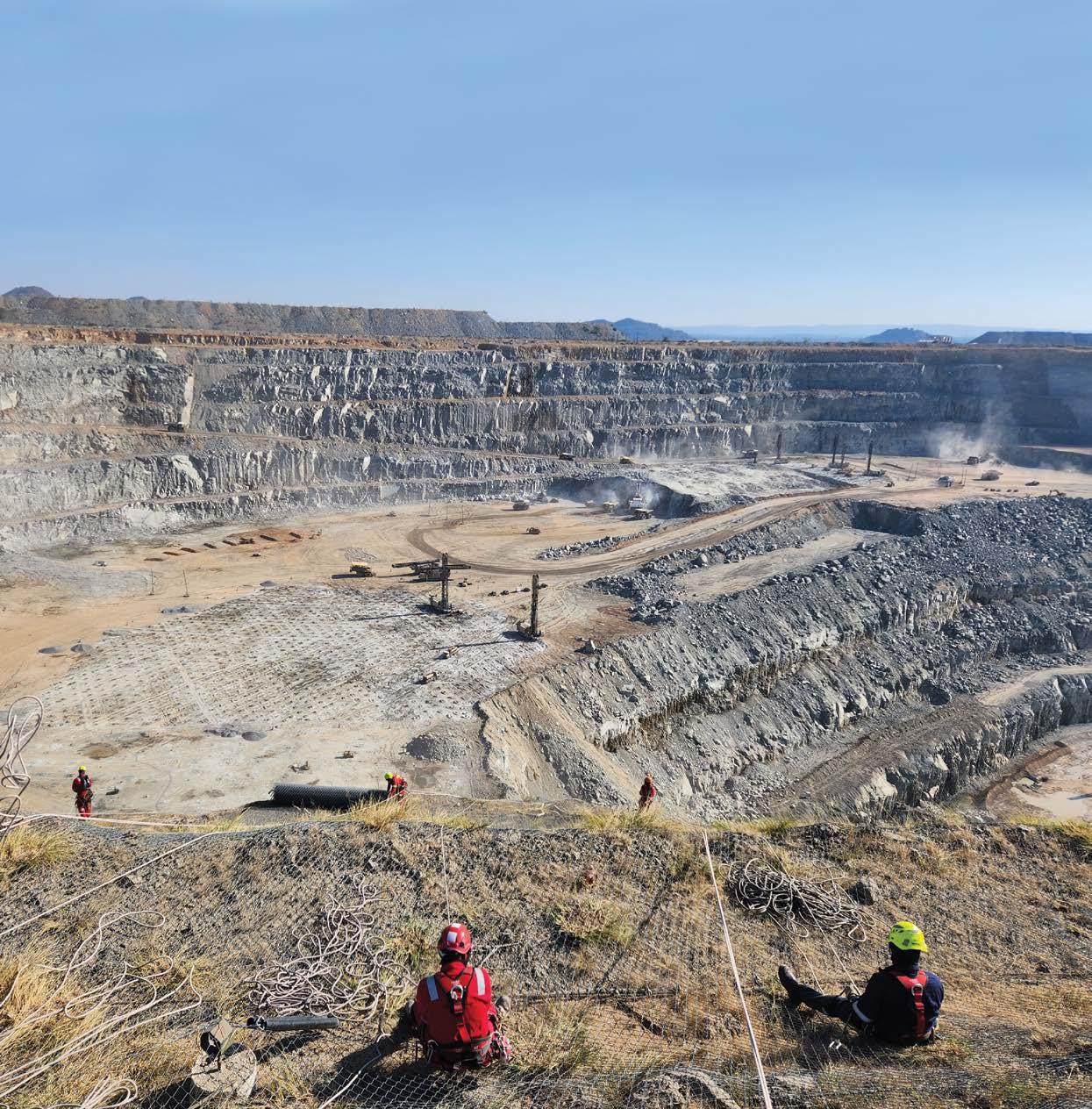



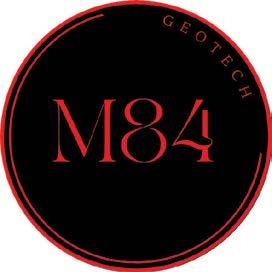
m84_geotech M84 Geotech mines A geohazards mitigation and rockfall protection specialist for open pit T +27 (0)15 023 1400 | M +27 (0)72 203 8405 | www.m84geotech.co.za MINING SERVICES: ROCK SCALING | ROCKFALL PROTECTION | ROCKFALL BARRIERS PRISM INSTALLATION | DEVEGETATION | ANCHOR INSTALLATION | TESTING



































 Singh
Singh





































 By Sindisiwe Chikunga (MP), Minister of Transport
By Sindisiwe Chikunga (MP), Minister of Transport




















 By Ctrack
By Ctrack




















































 ADVERTORIAL: SPLENDI
ADVERTORIAL: SPLENDI




















 By Lerato Lamola-Oguntoye, Consultant & Analisa Ndebele, Associate, Webber Wentzel
By Lerato Lamola-Oguntoye, Consultant & Analisa Ndebele, Associate, Webber Wentzel


 By Celesté Snyders, SchoemanLaw Inc
By Celesté Snyders, SchoemanLaw Inc














